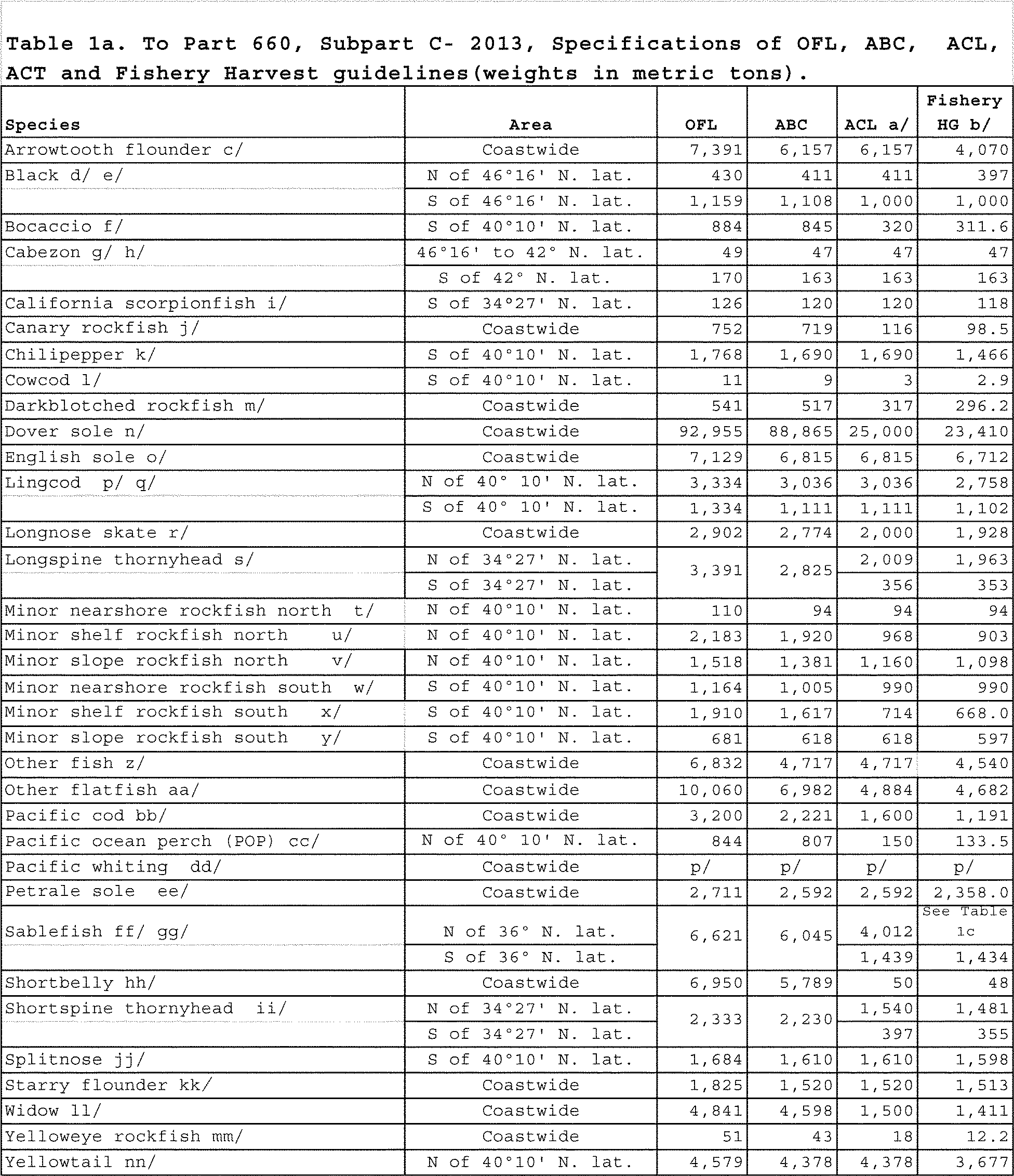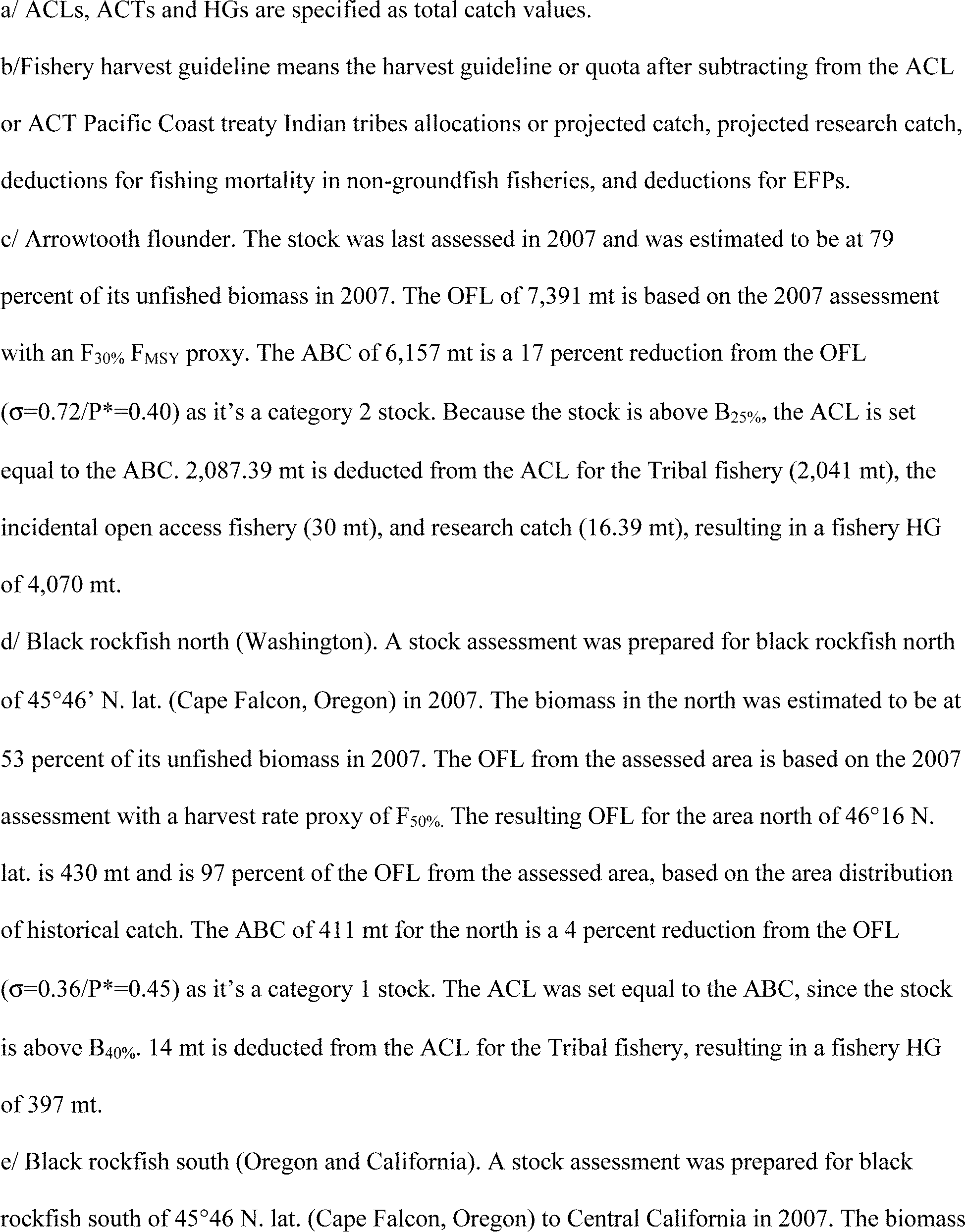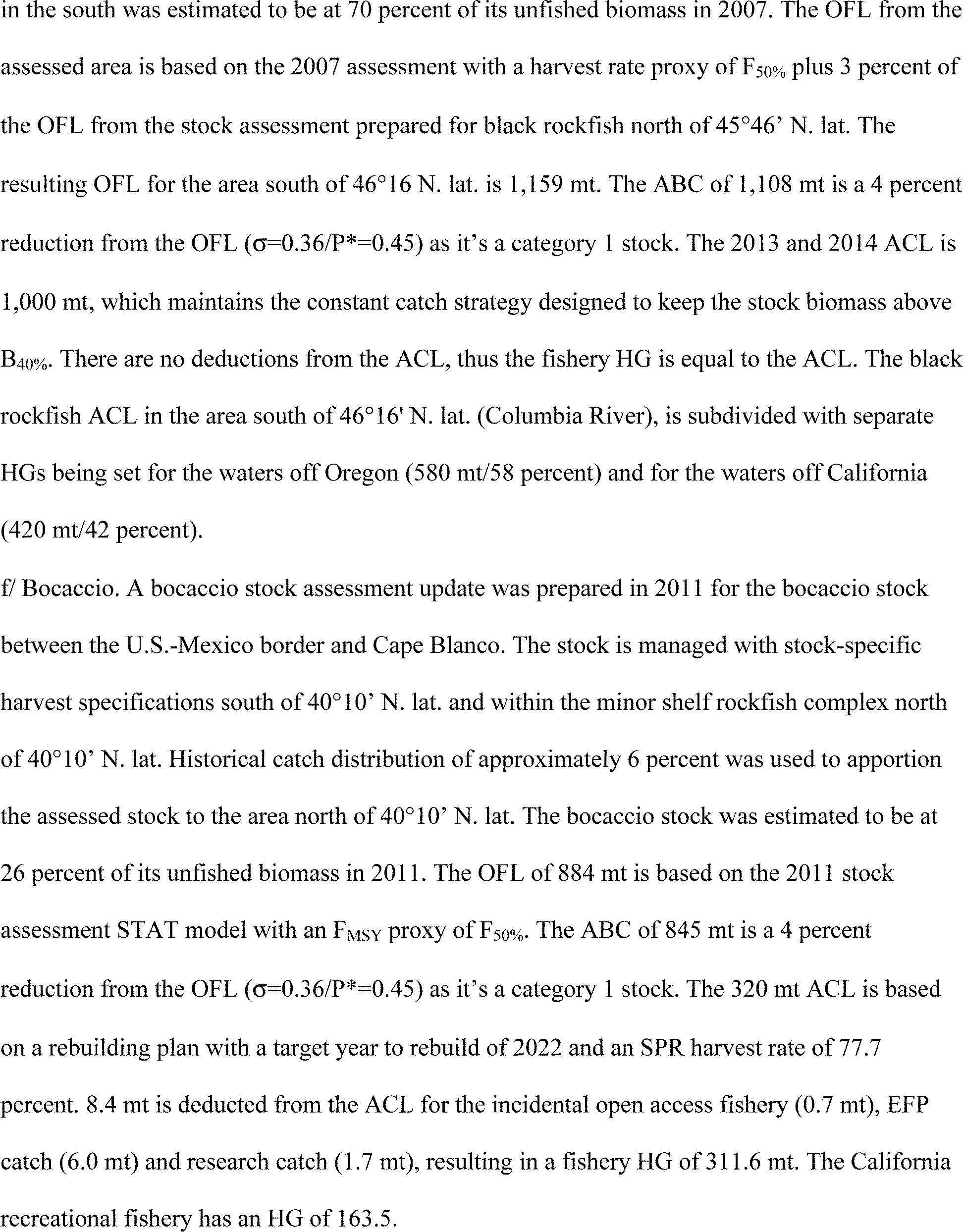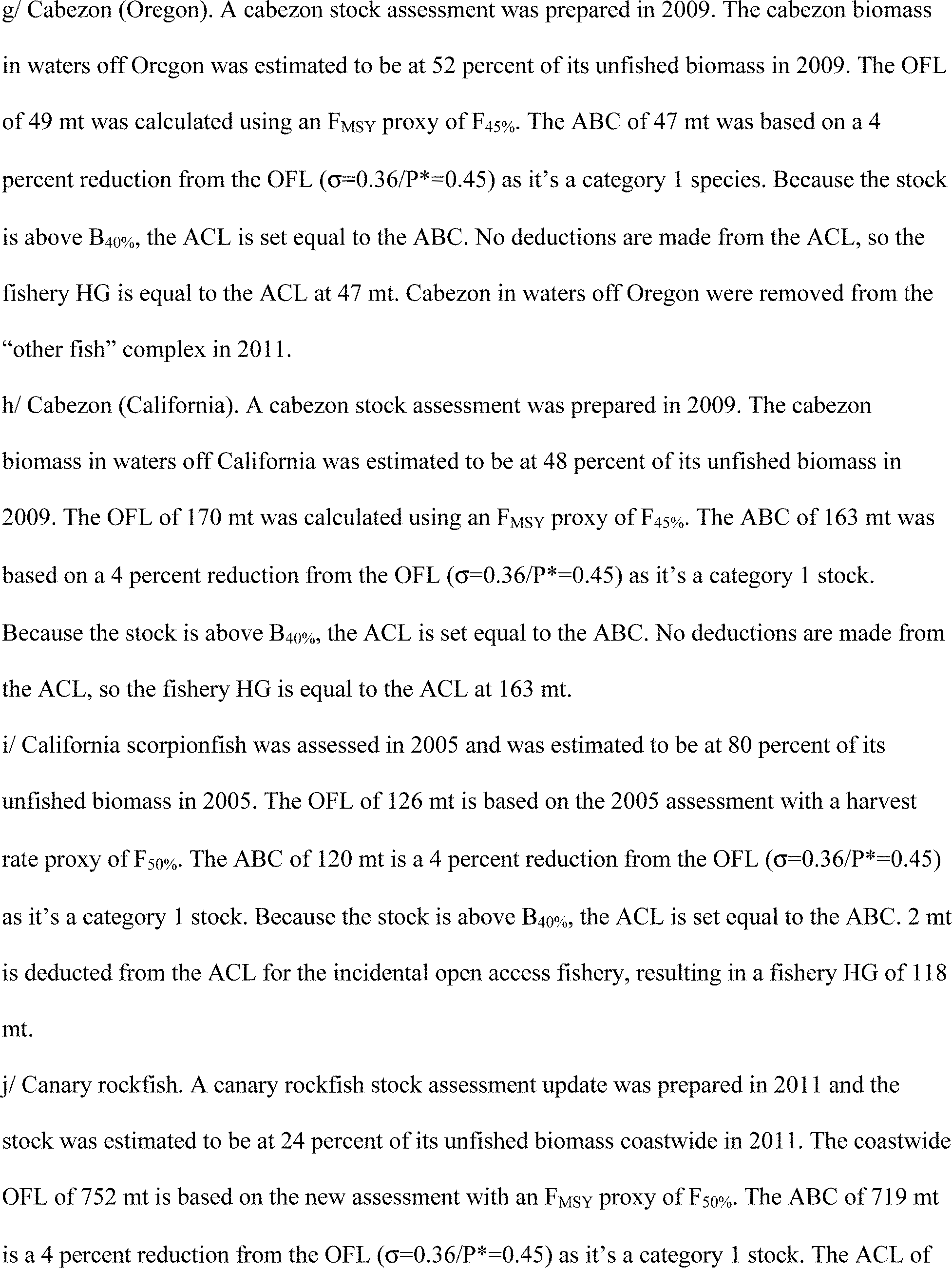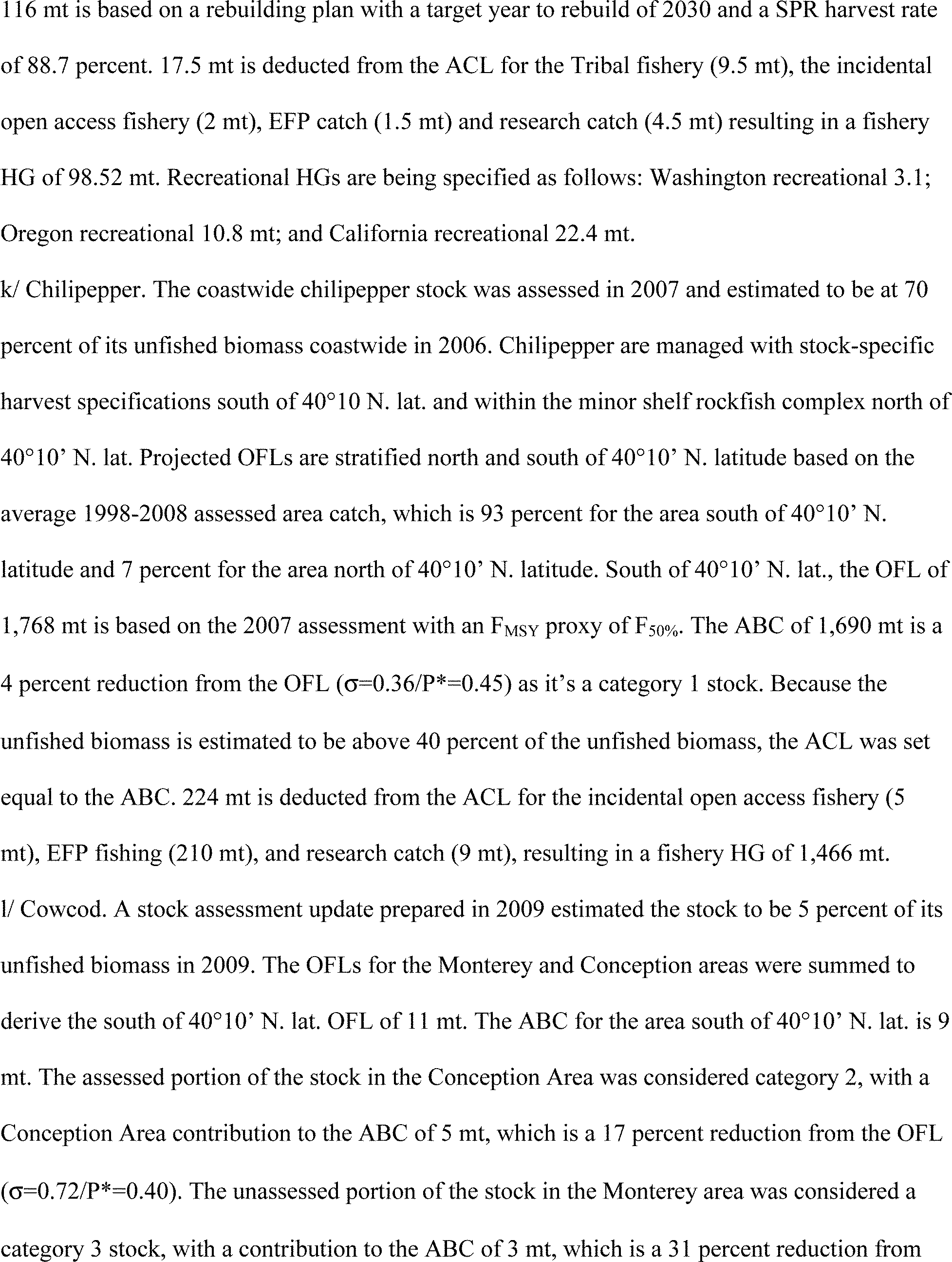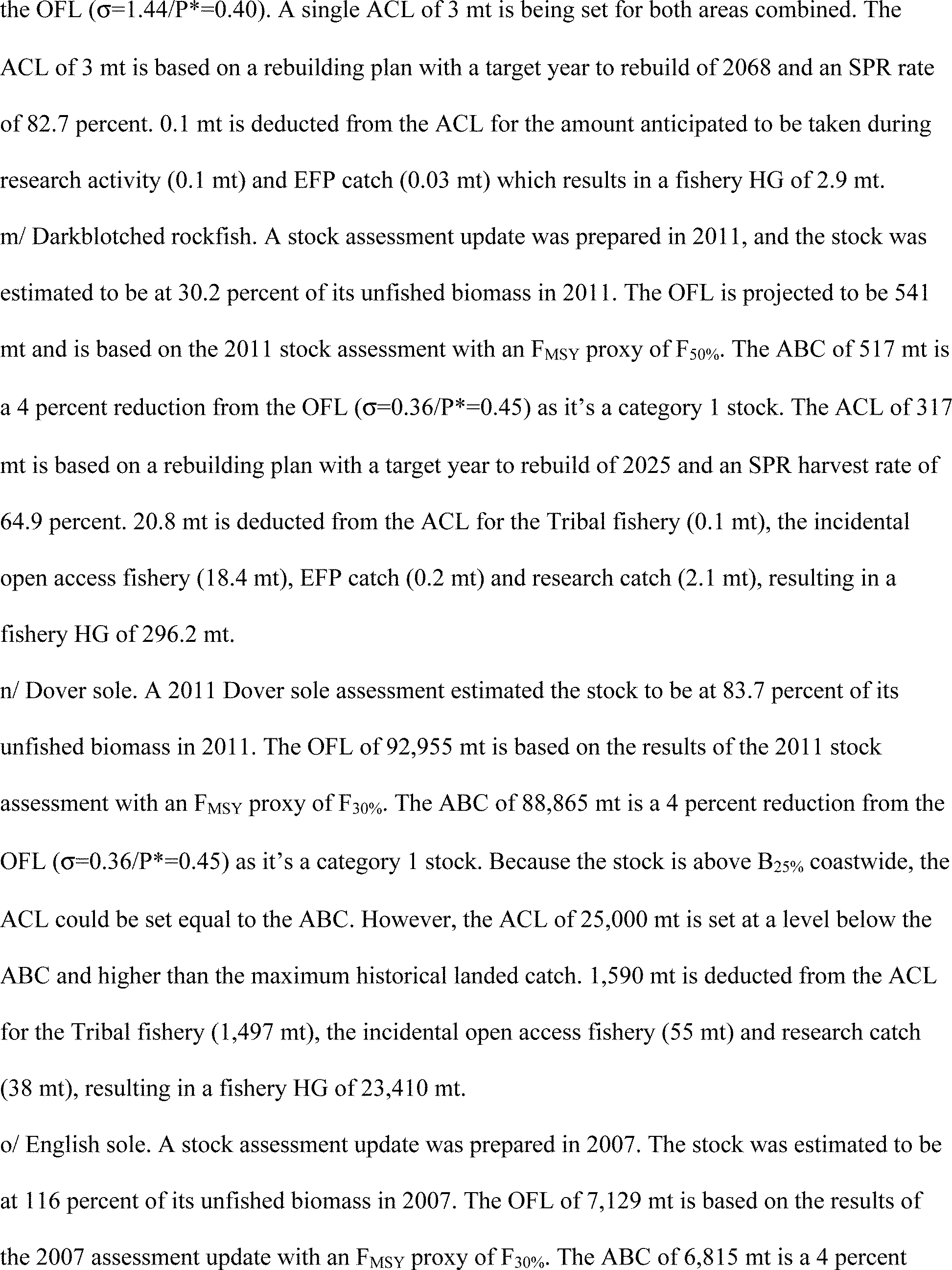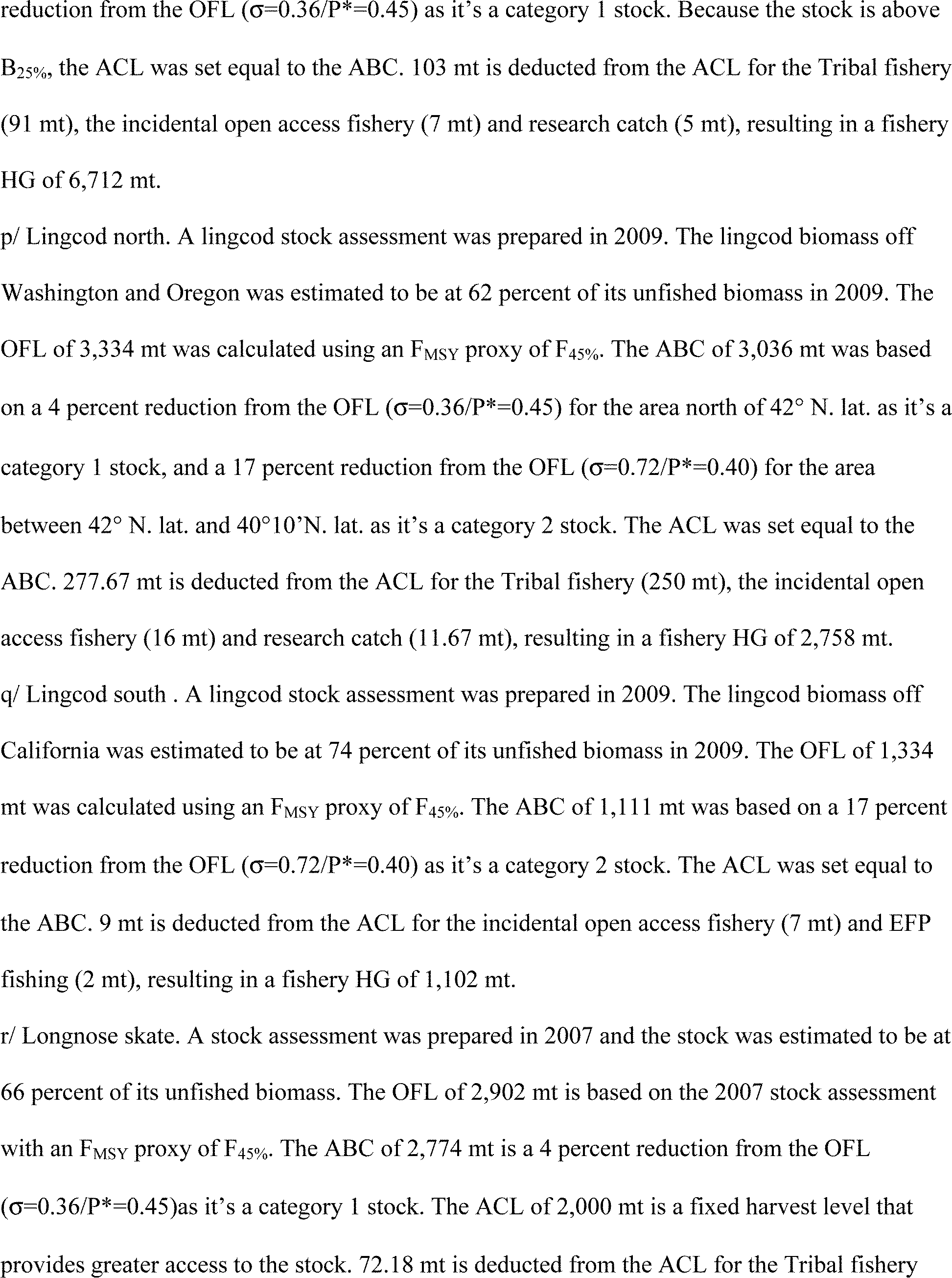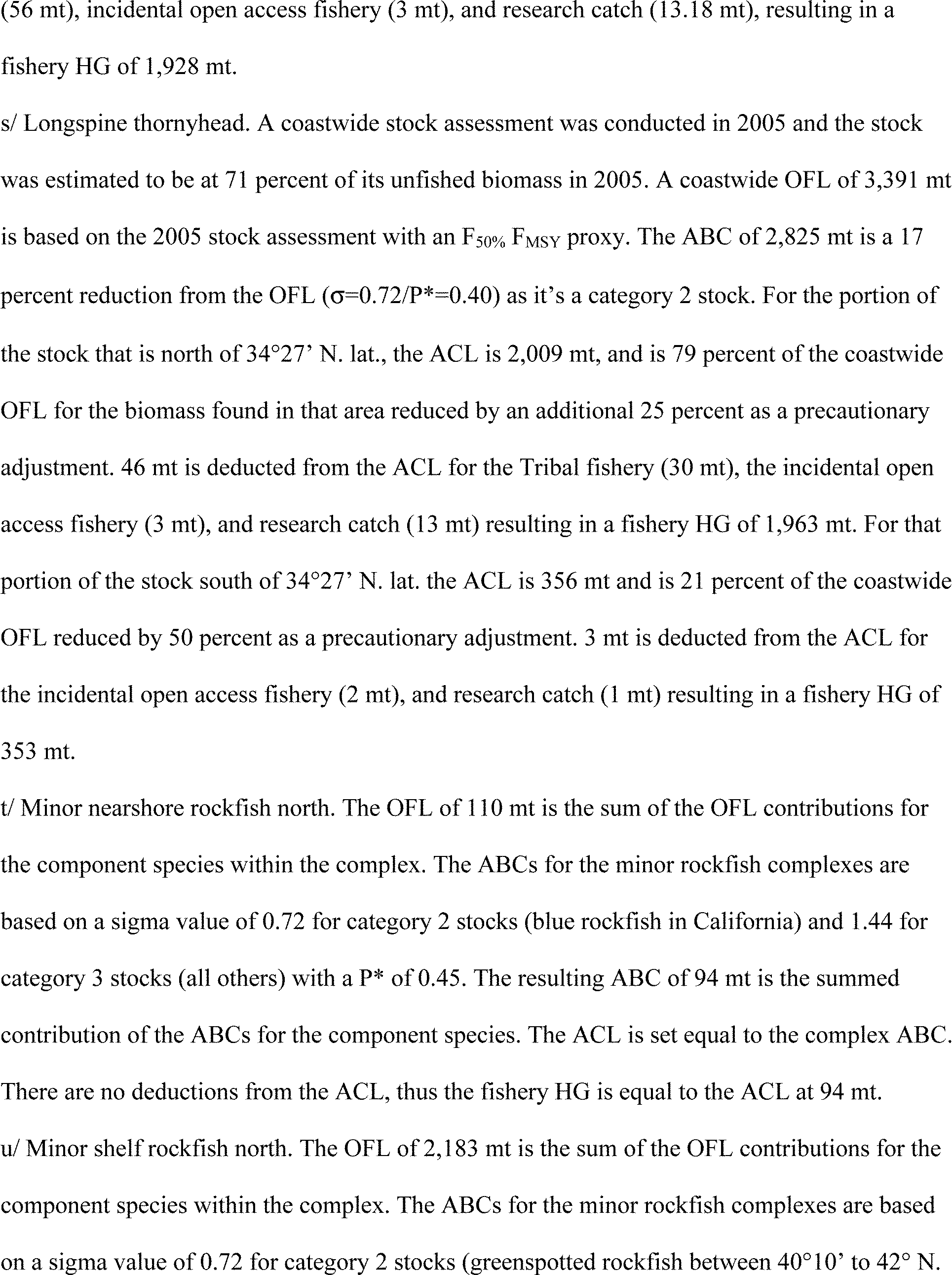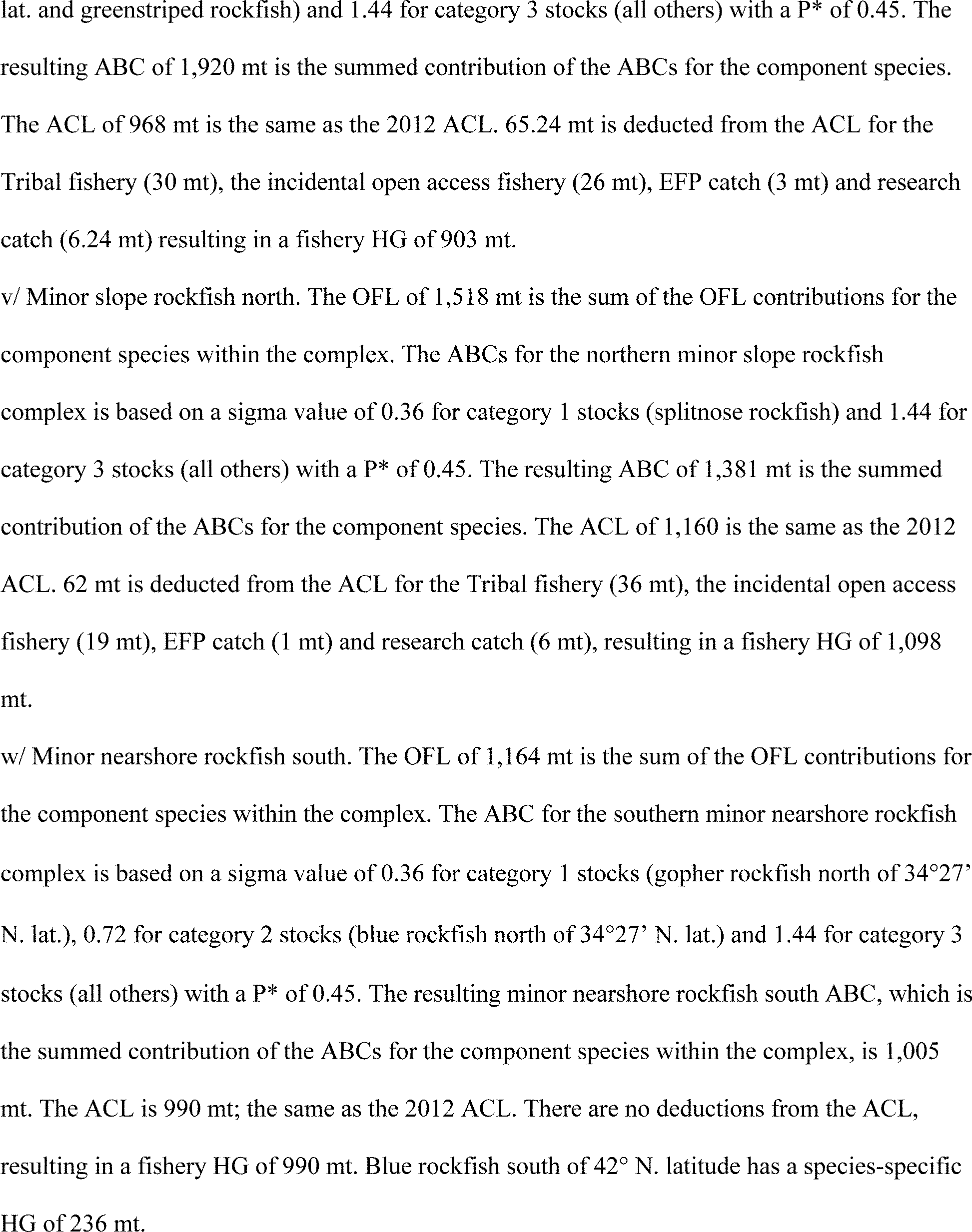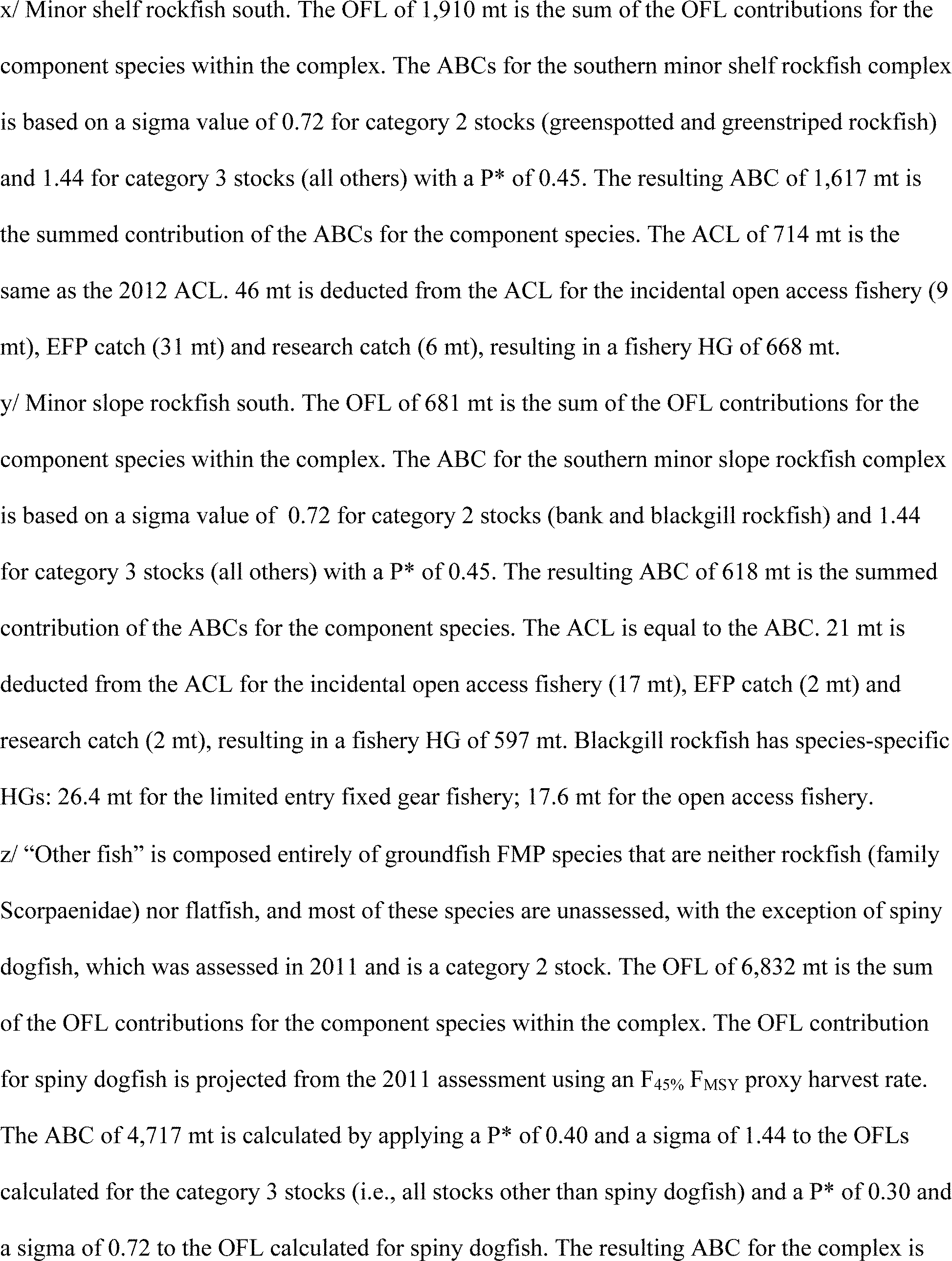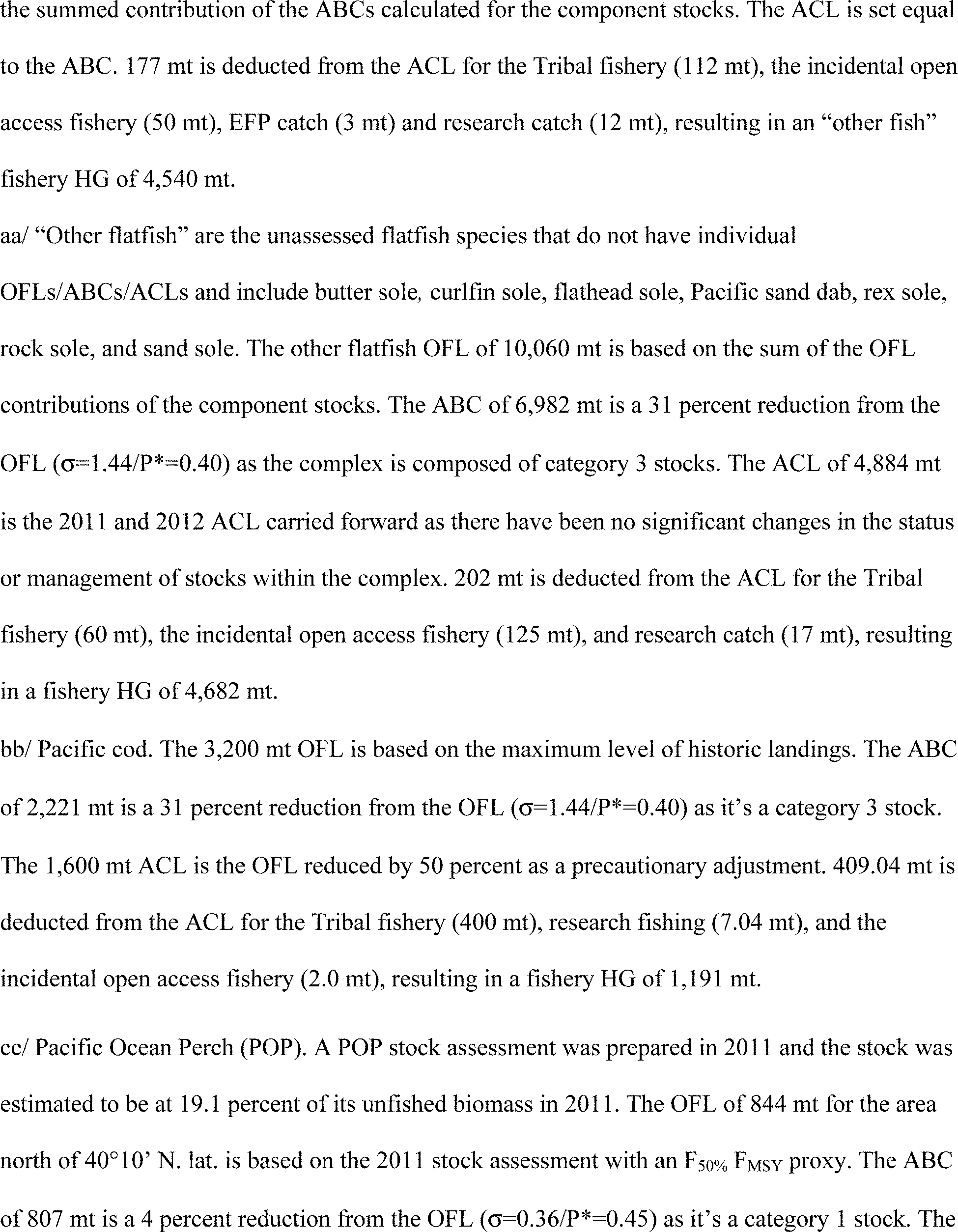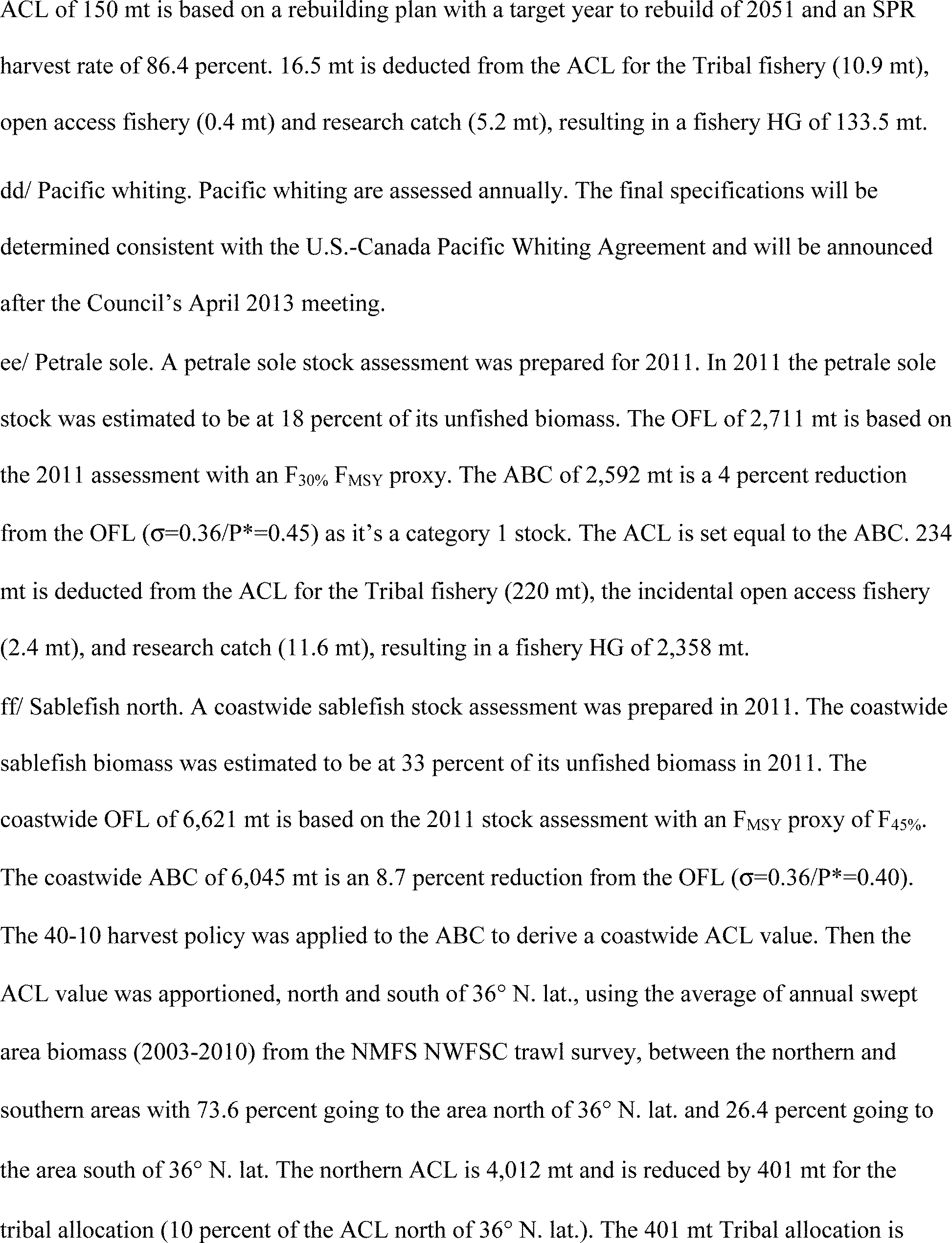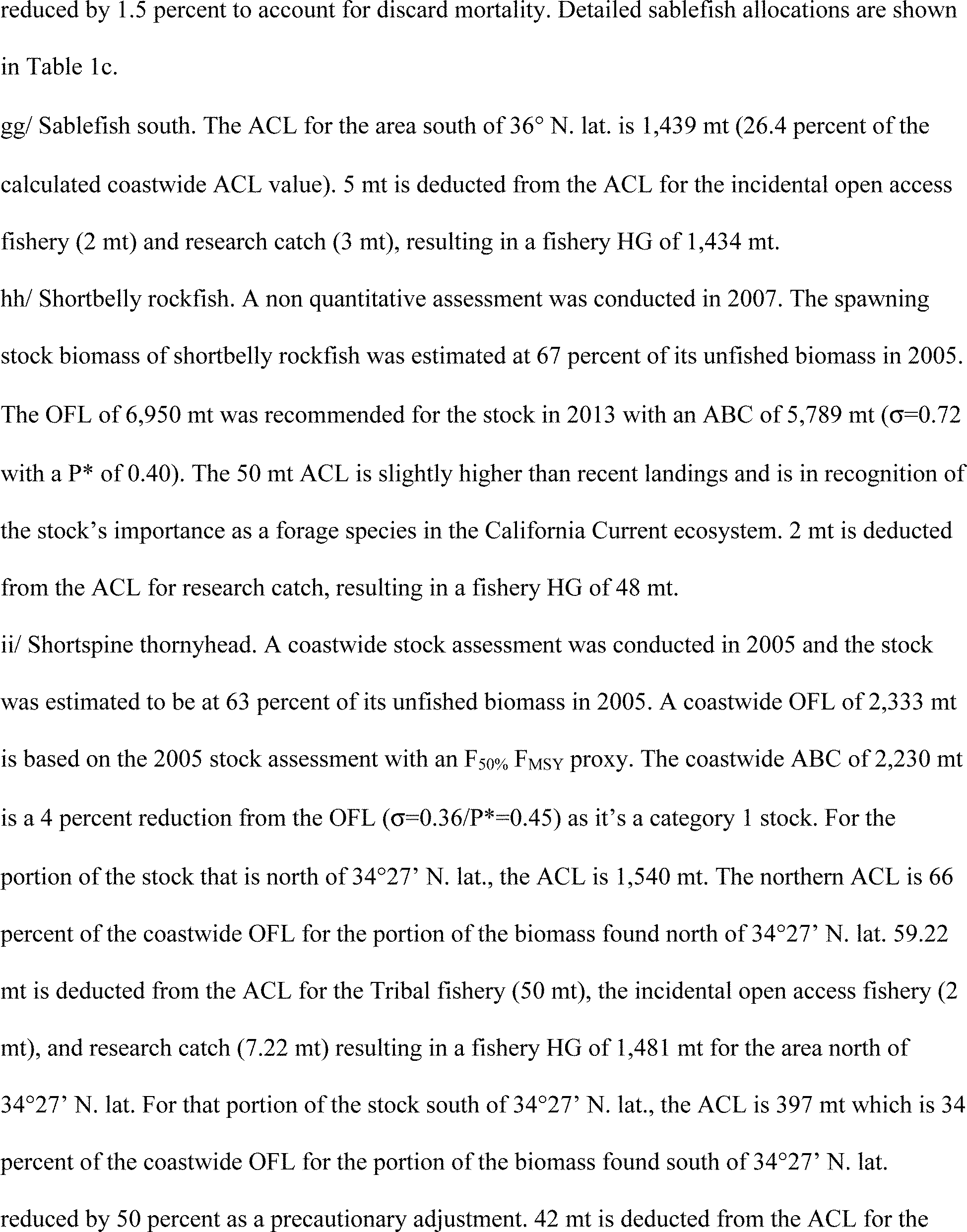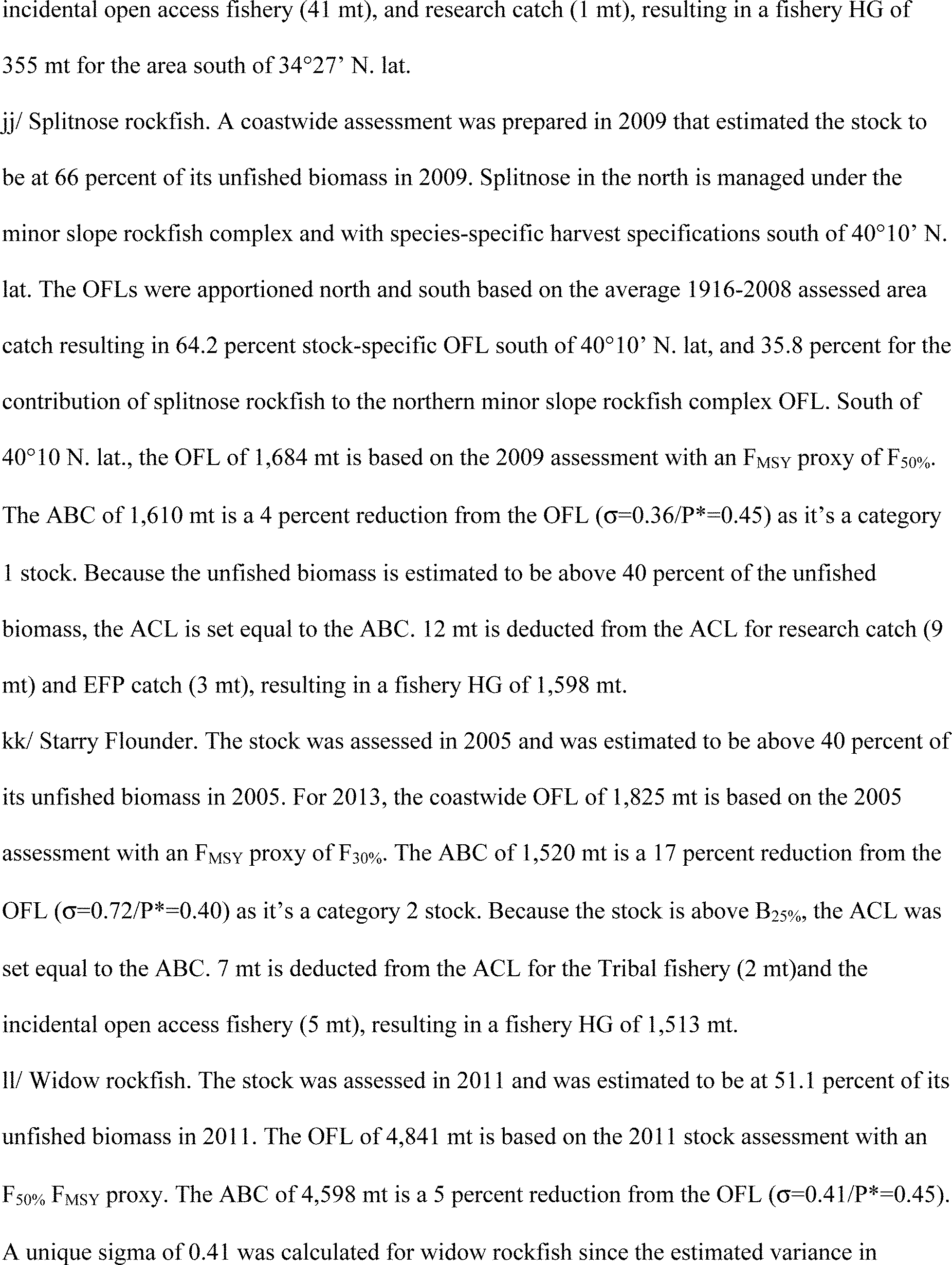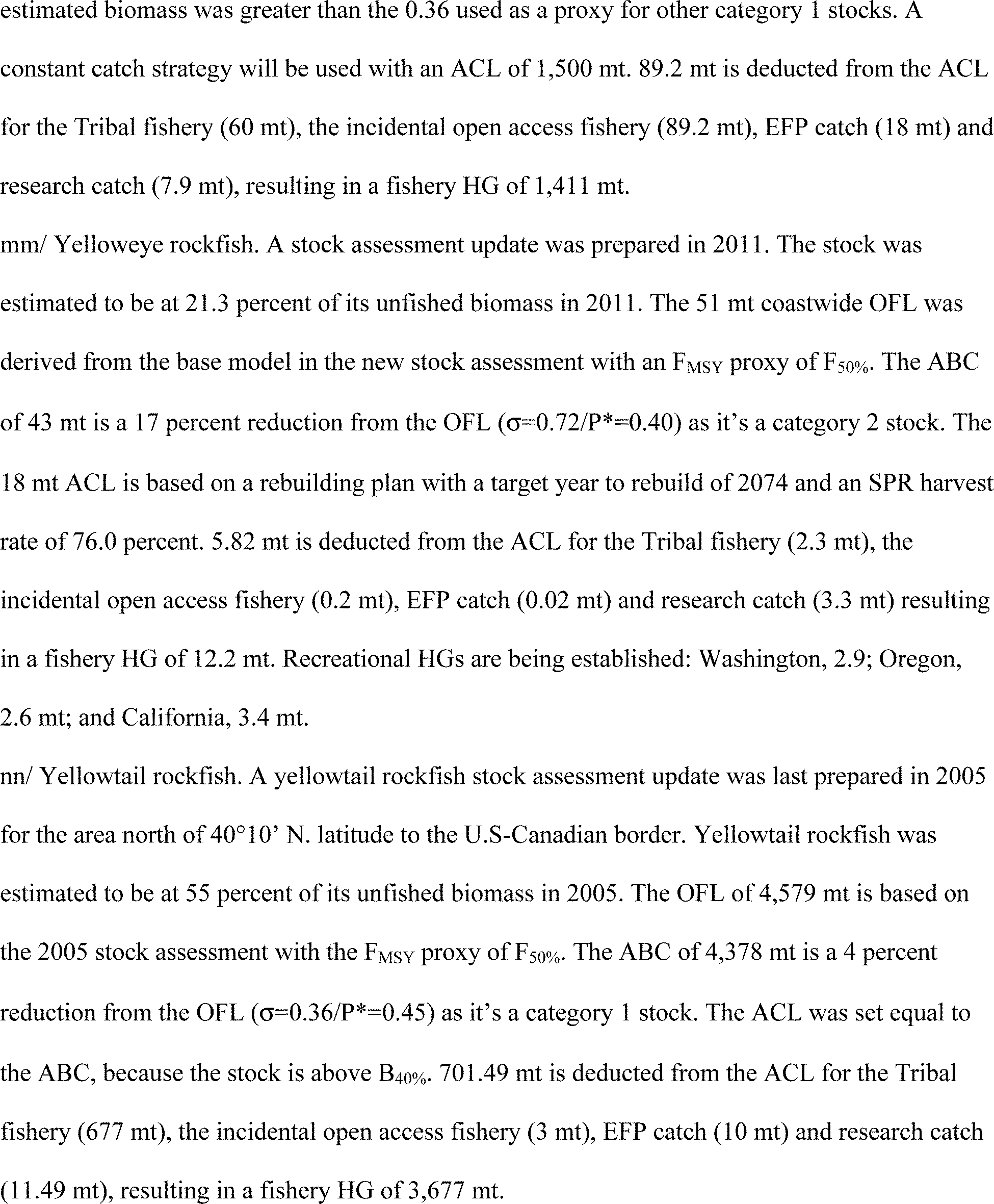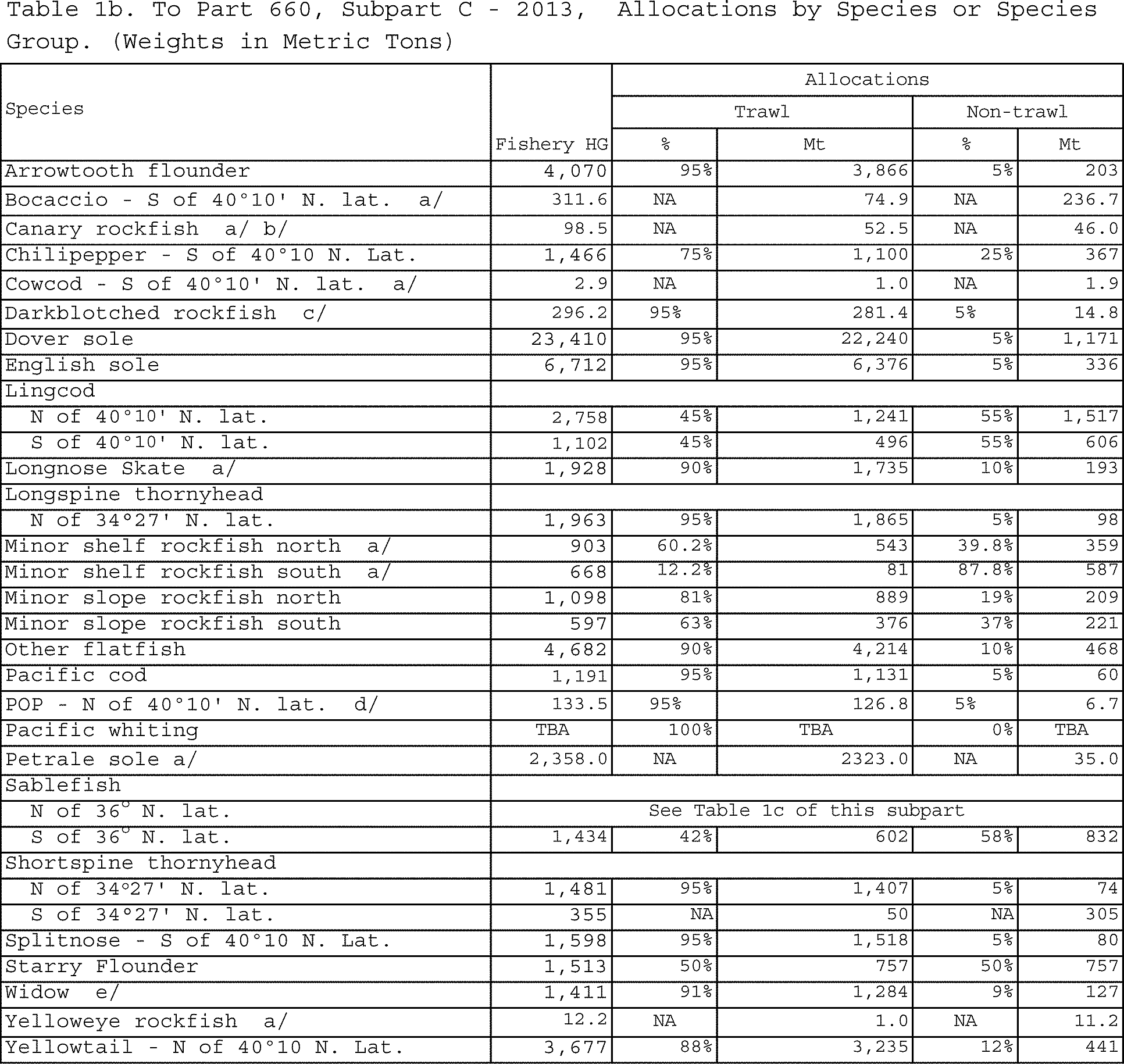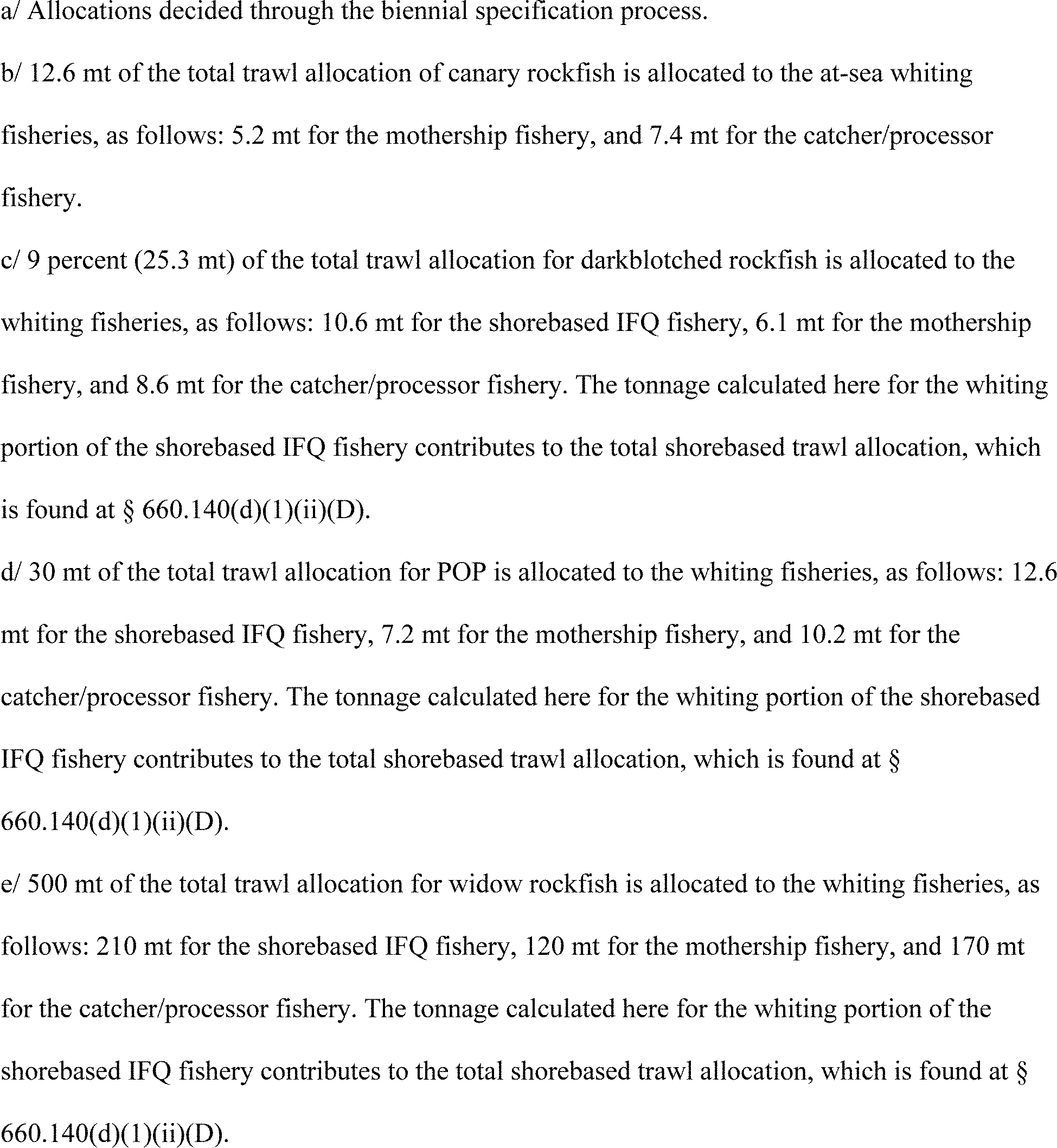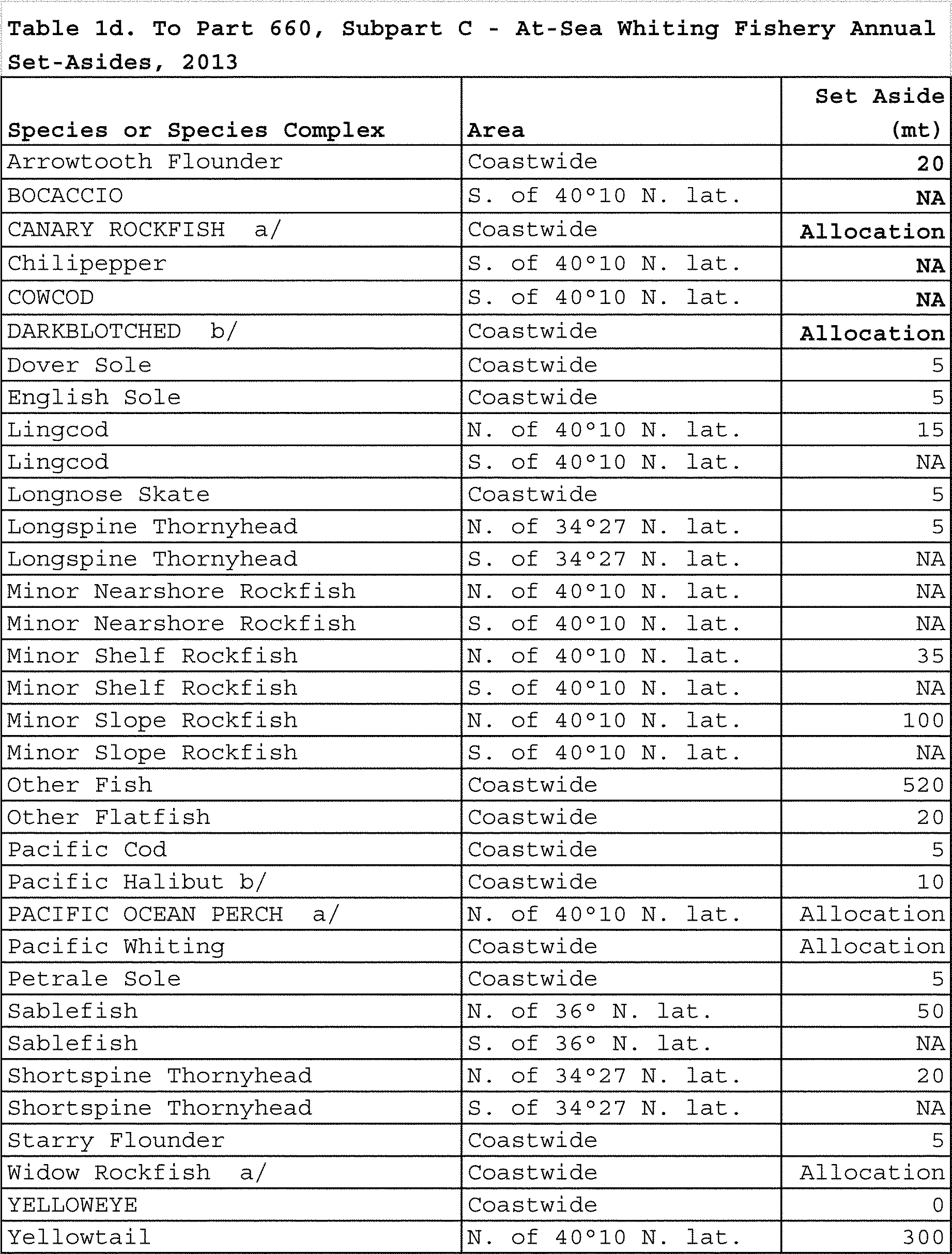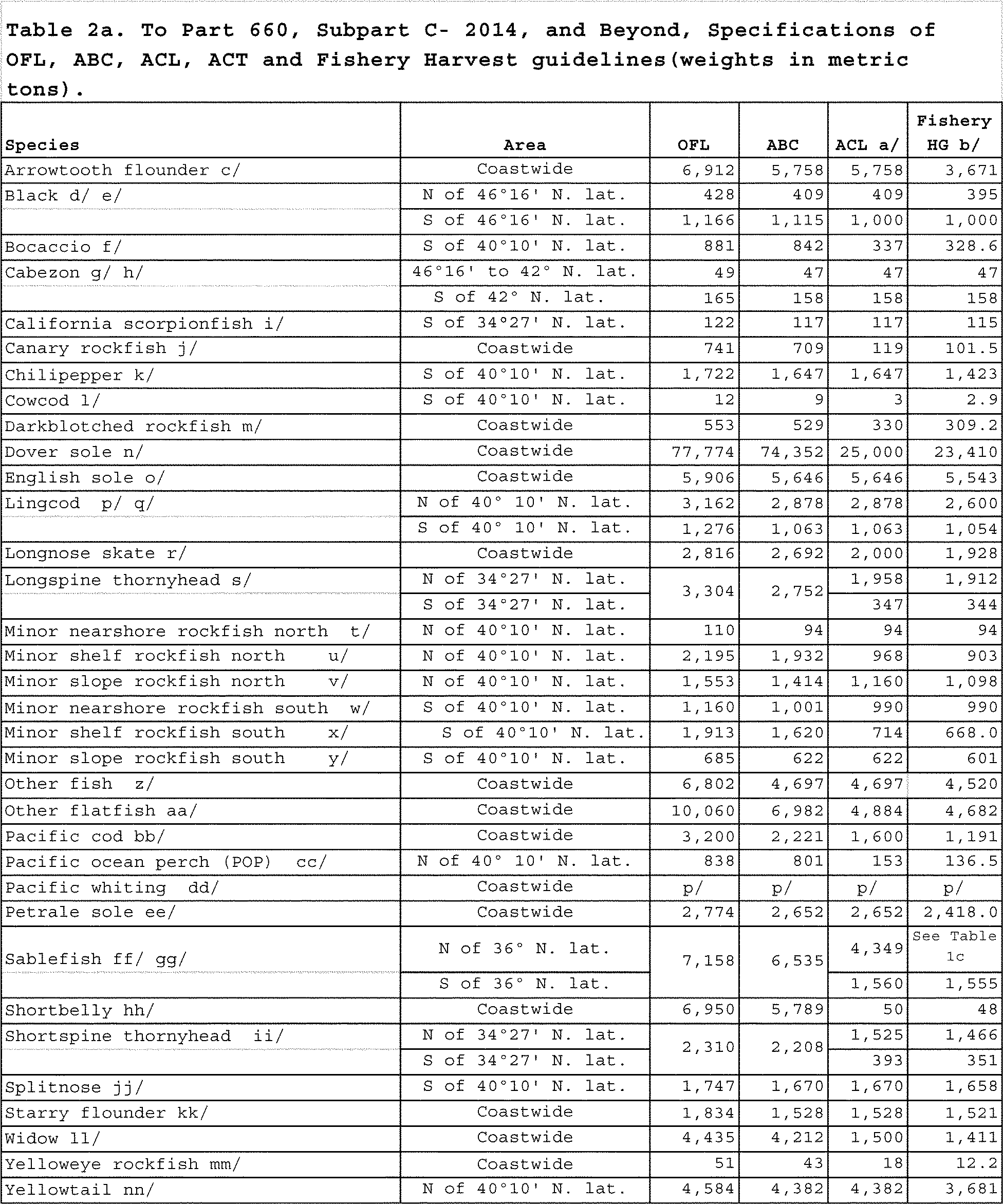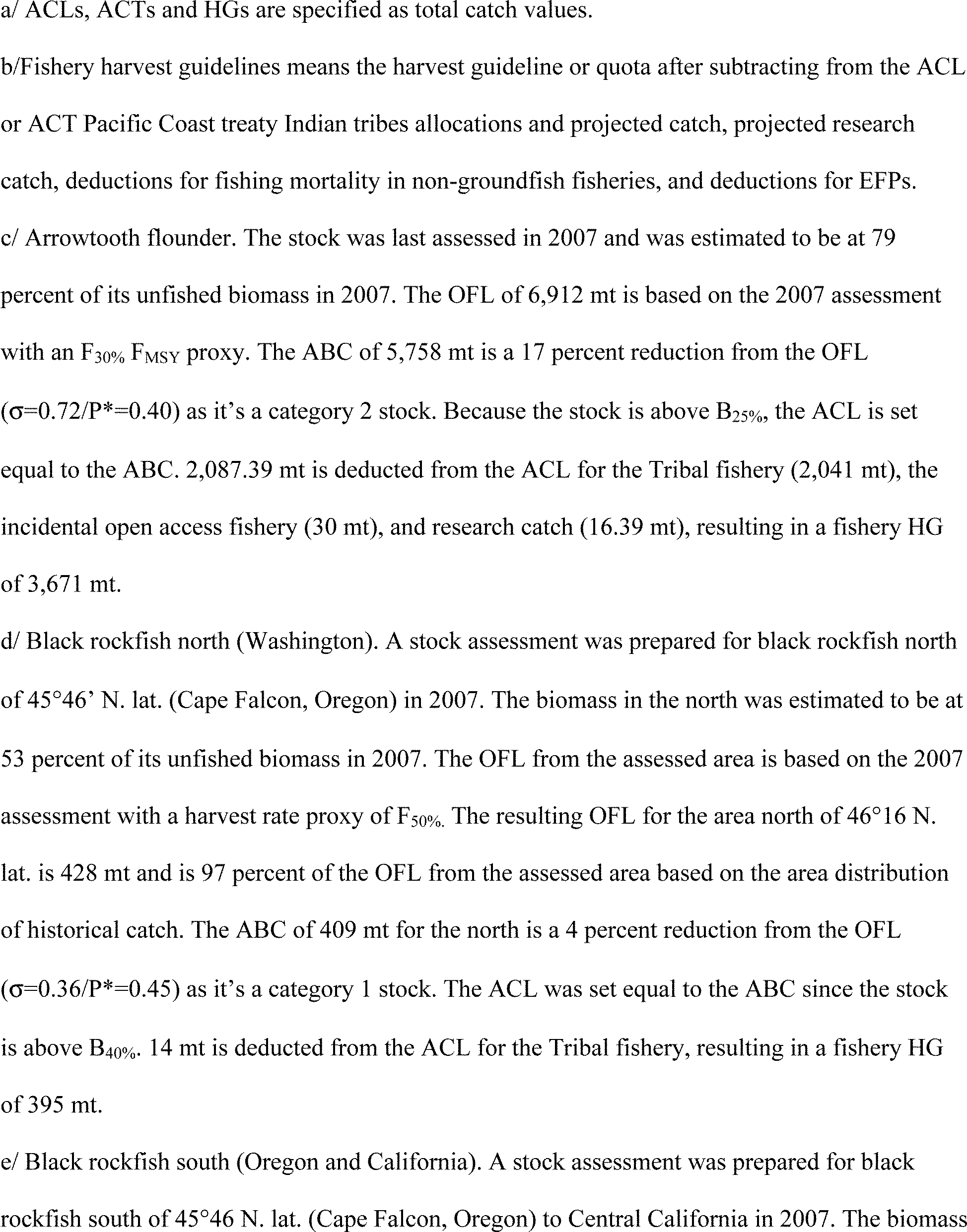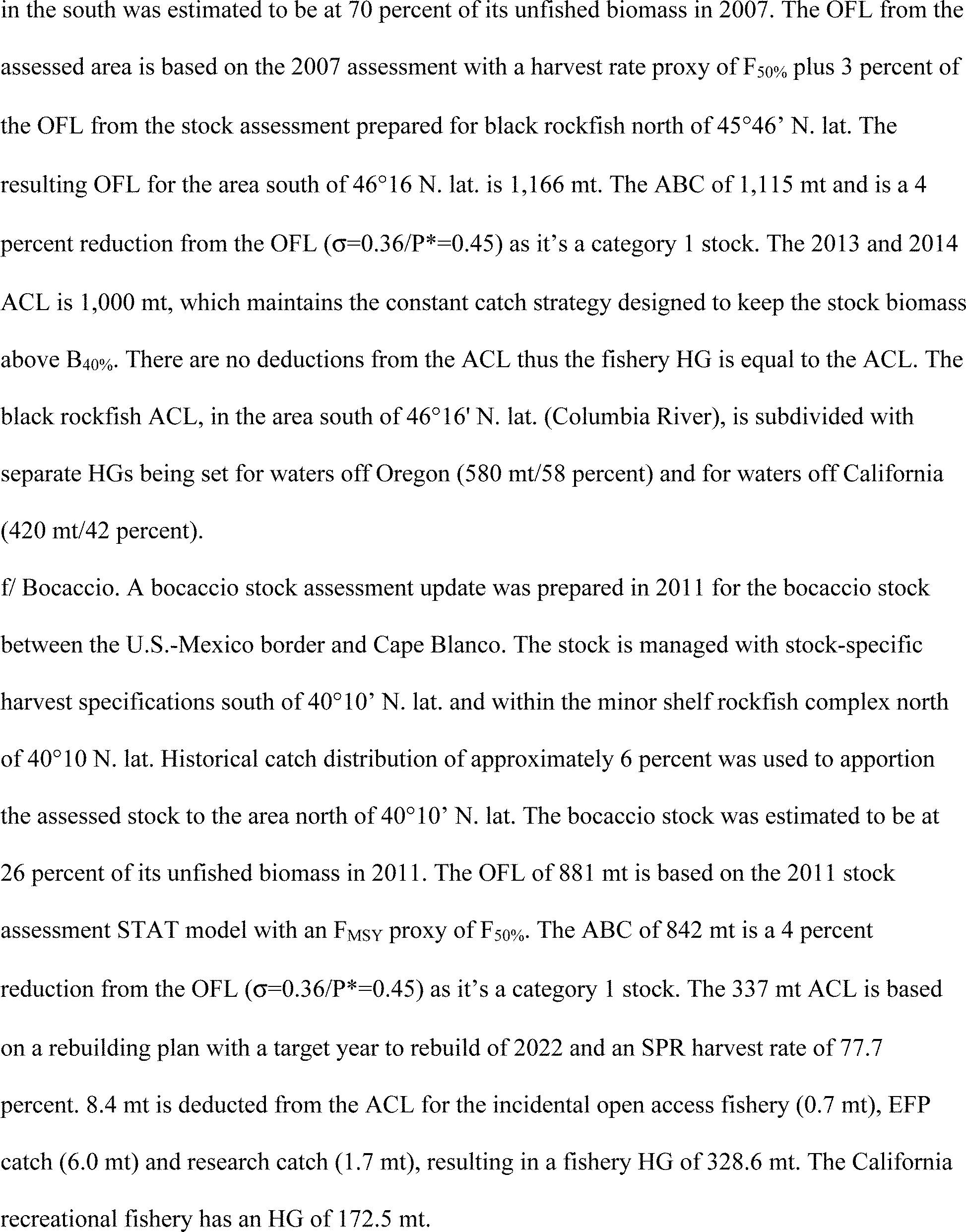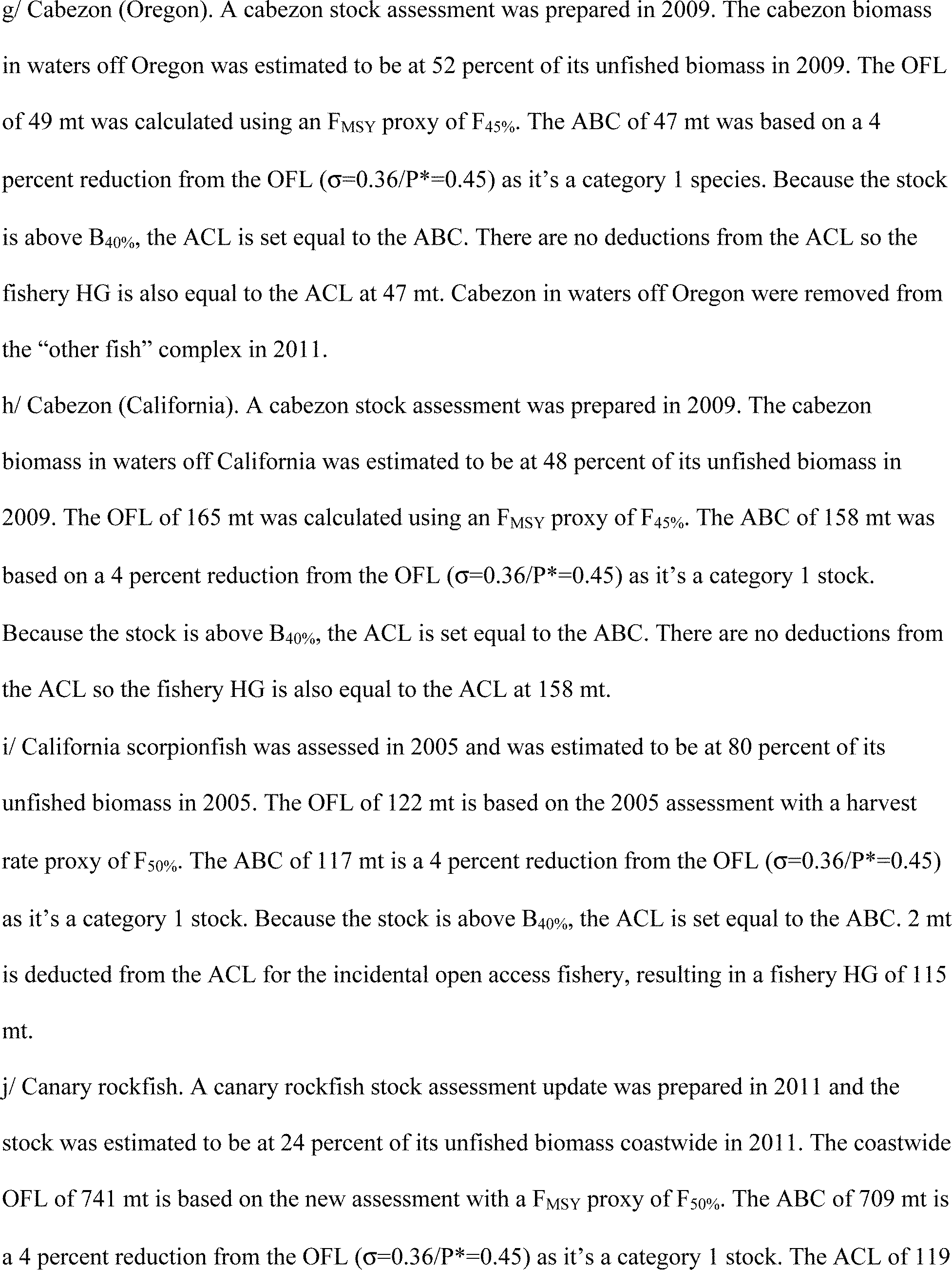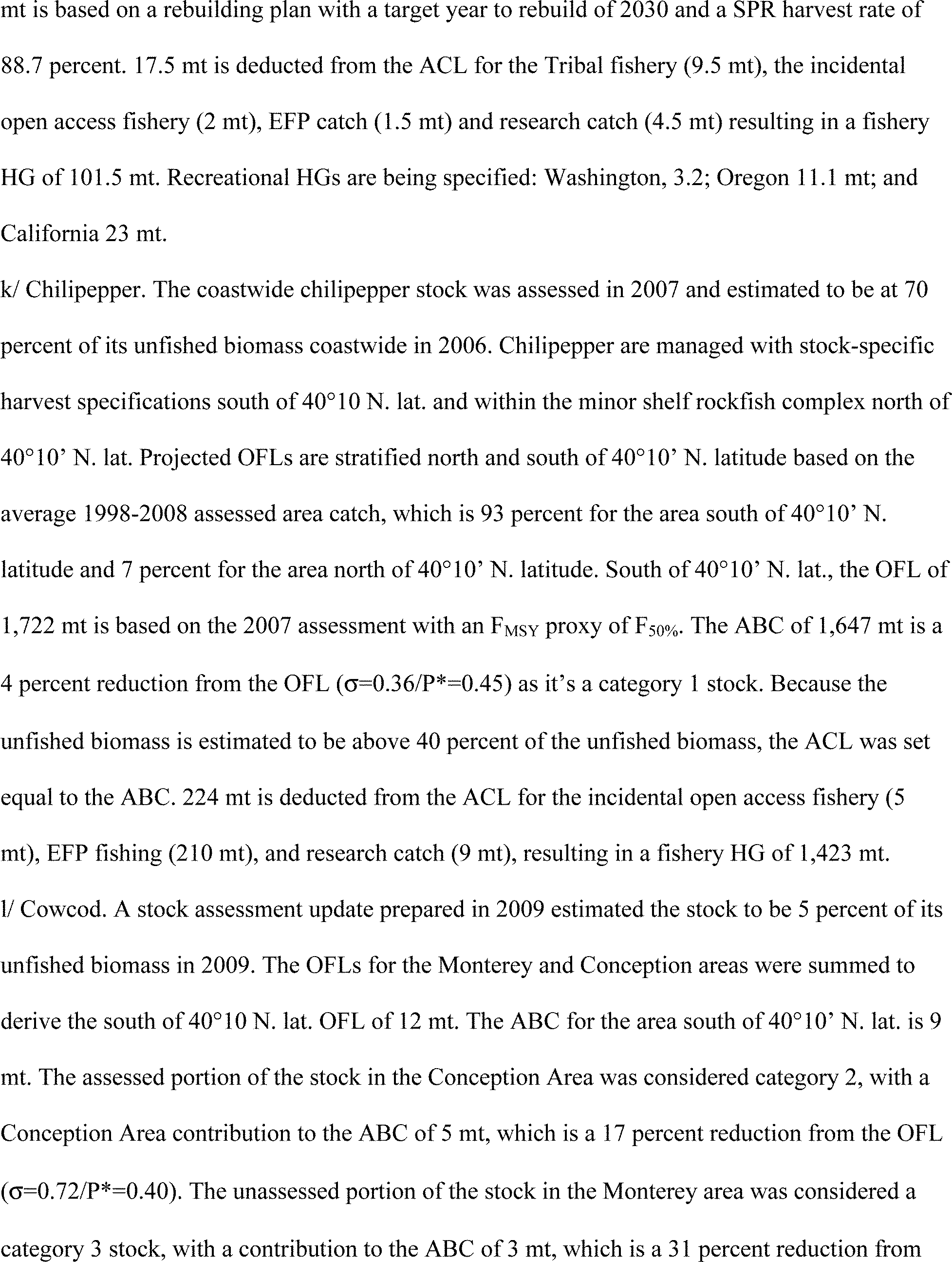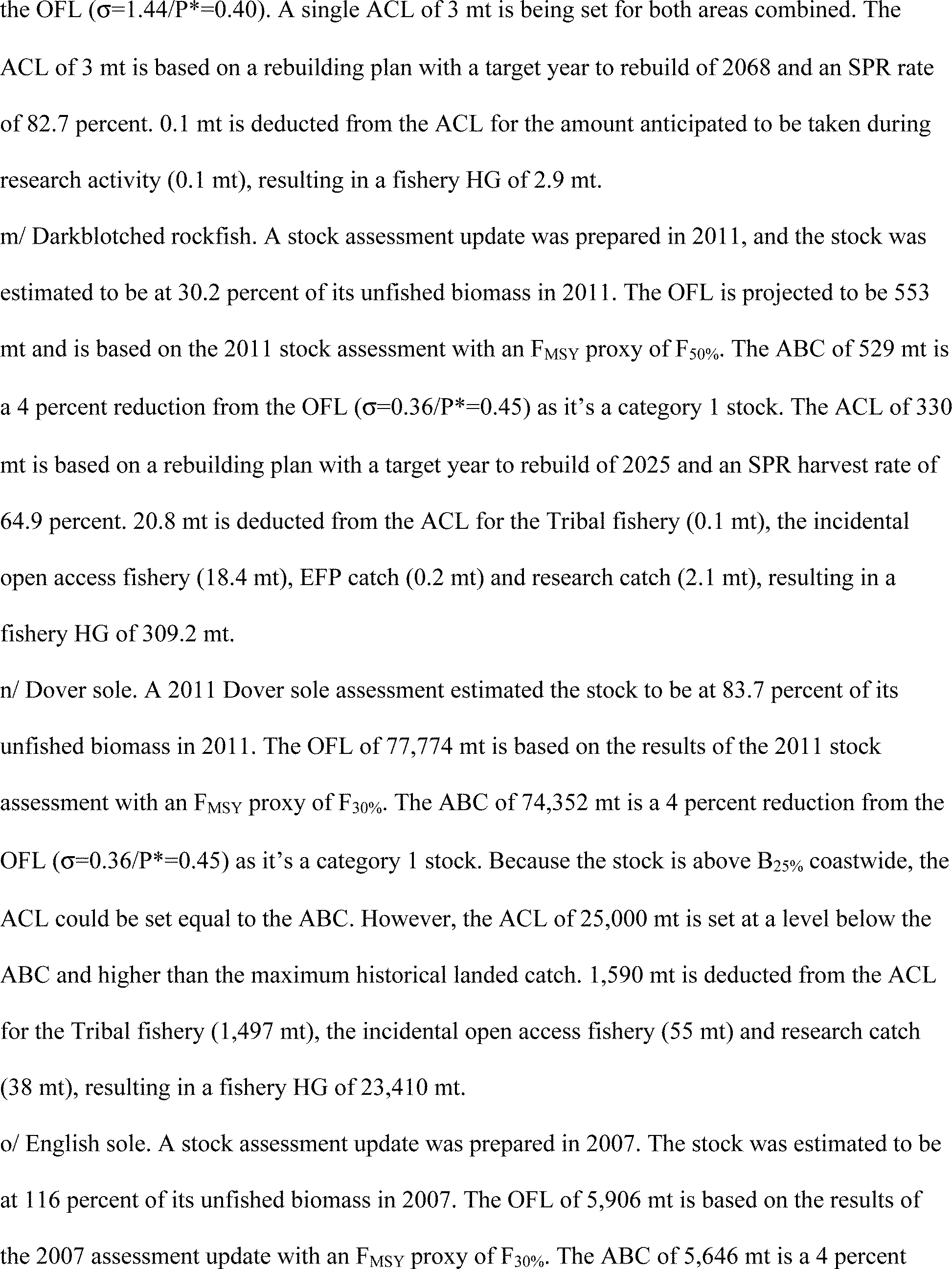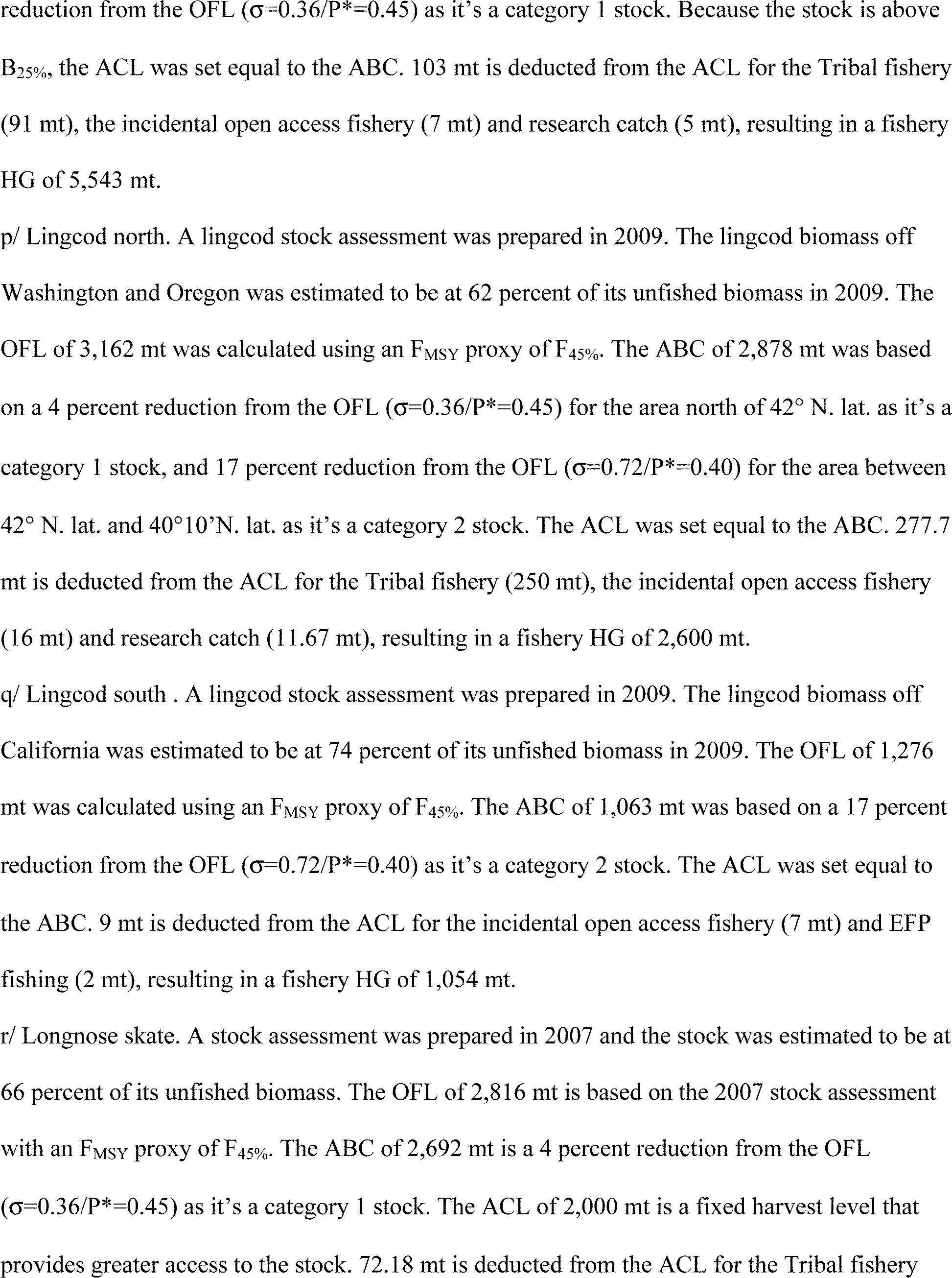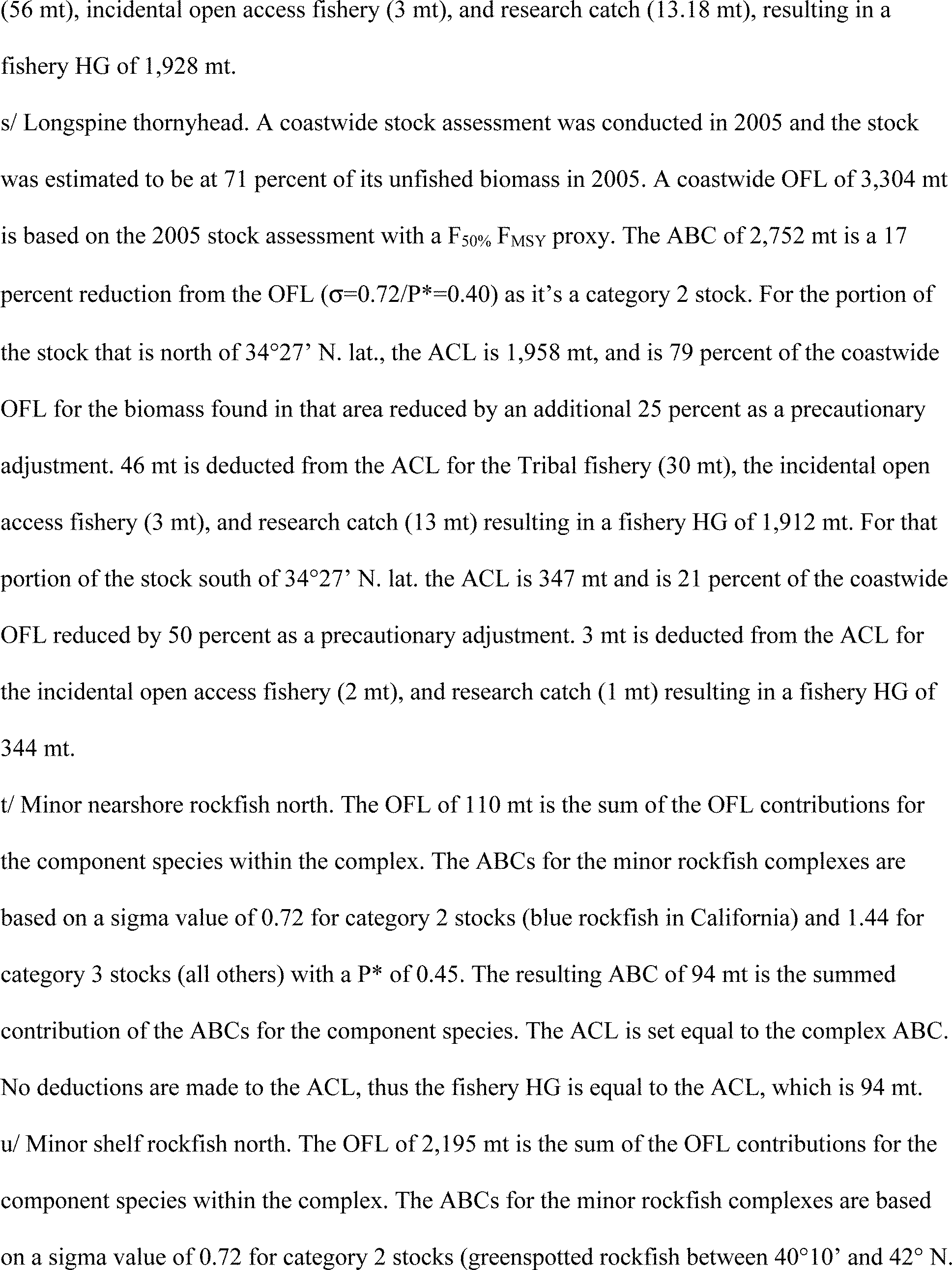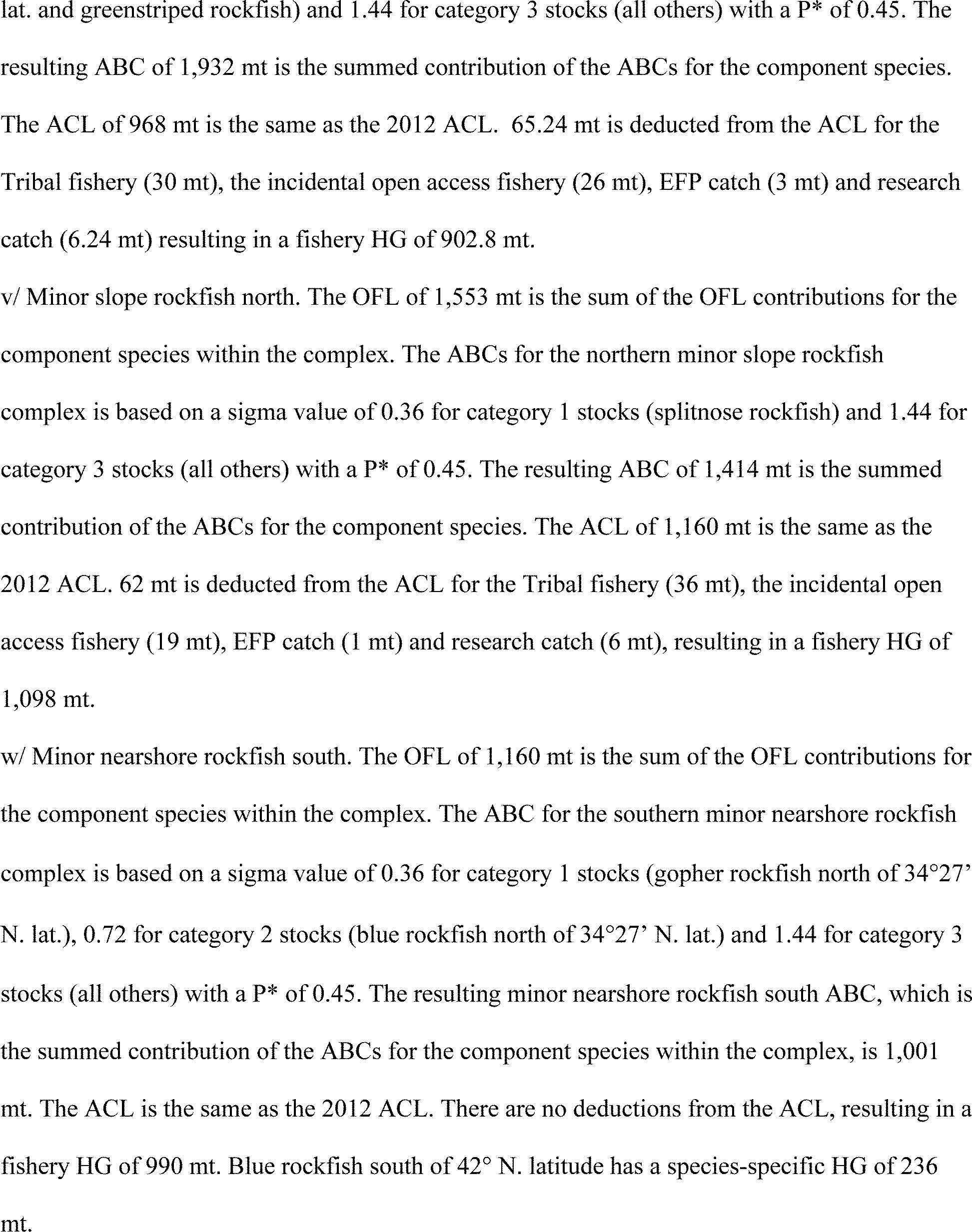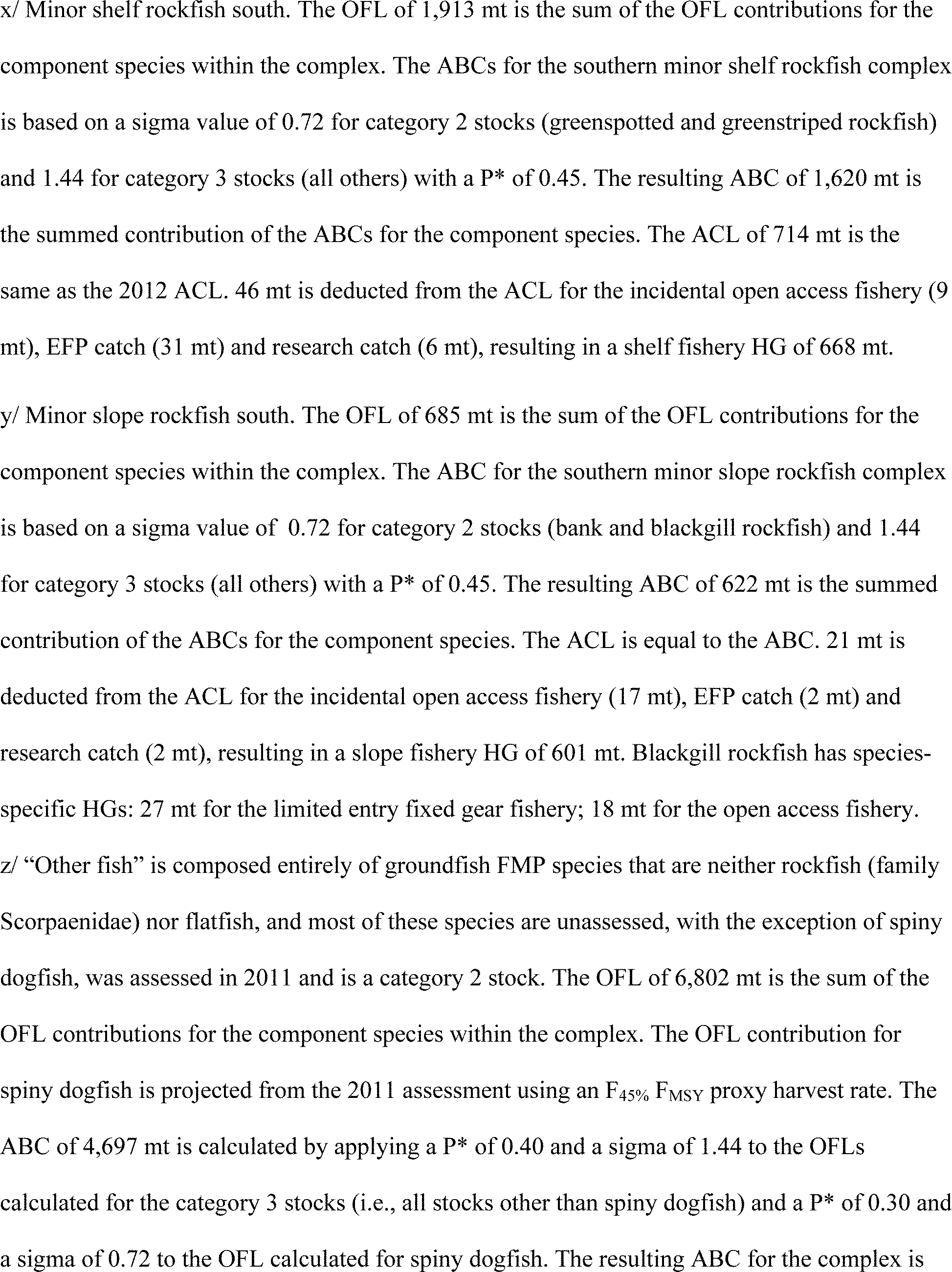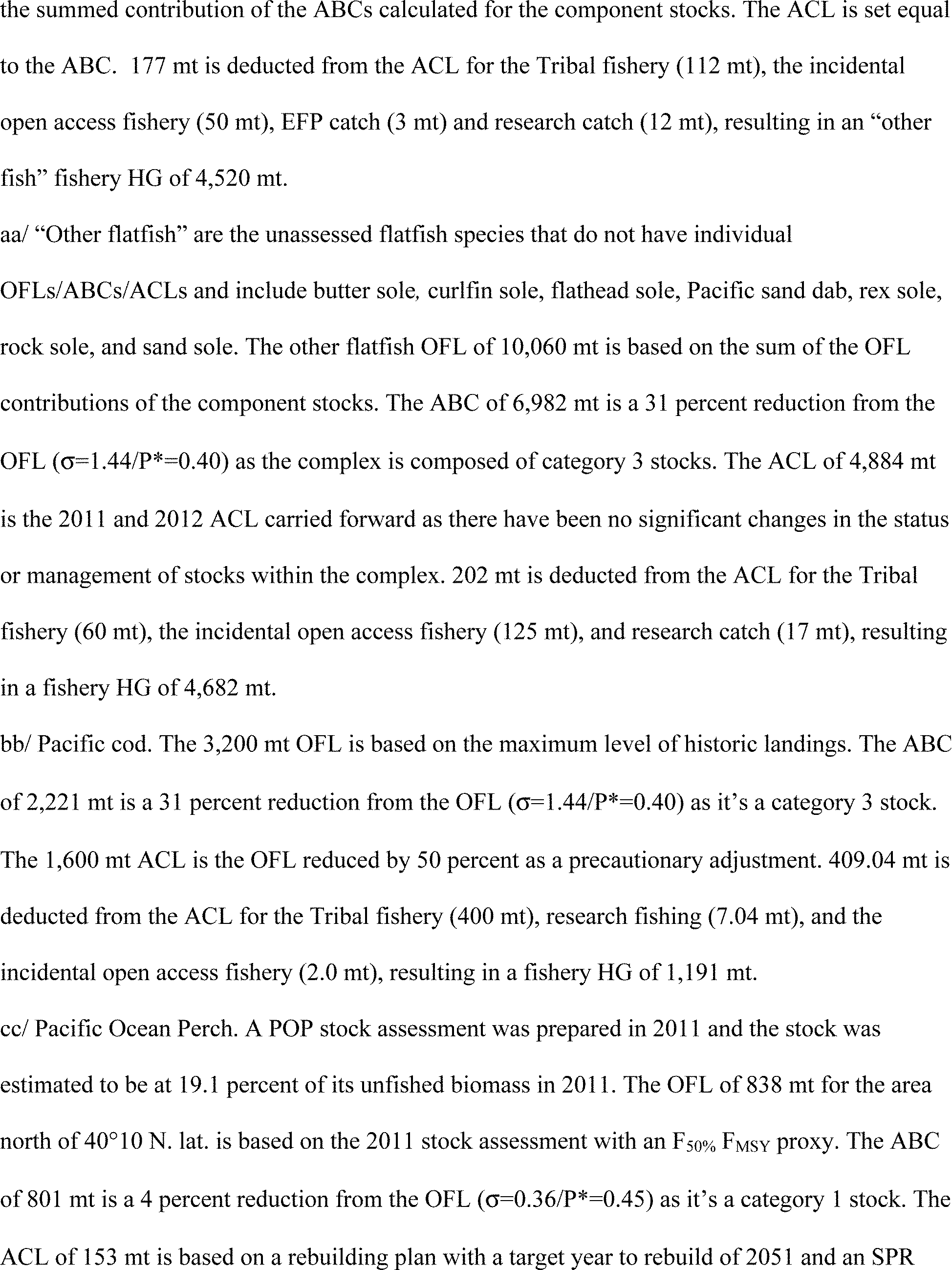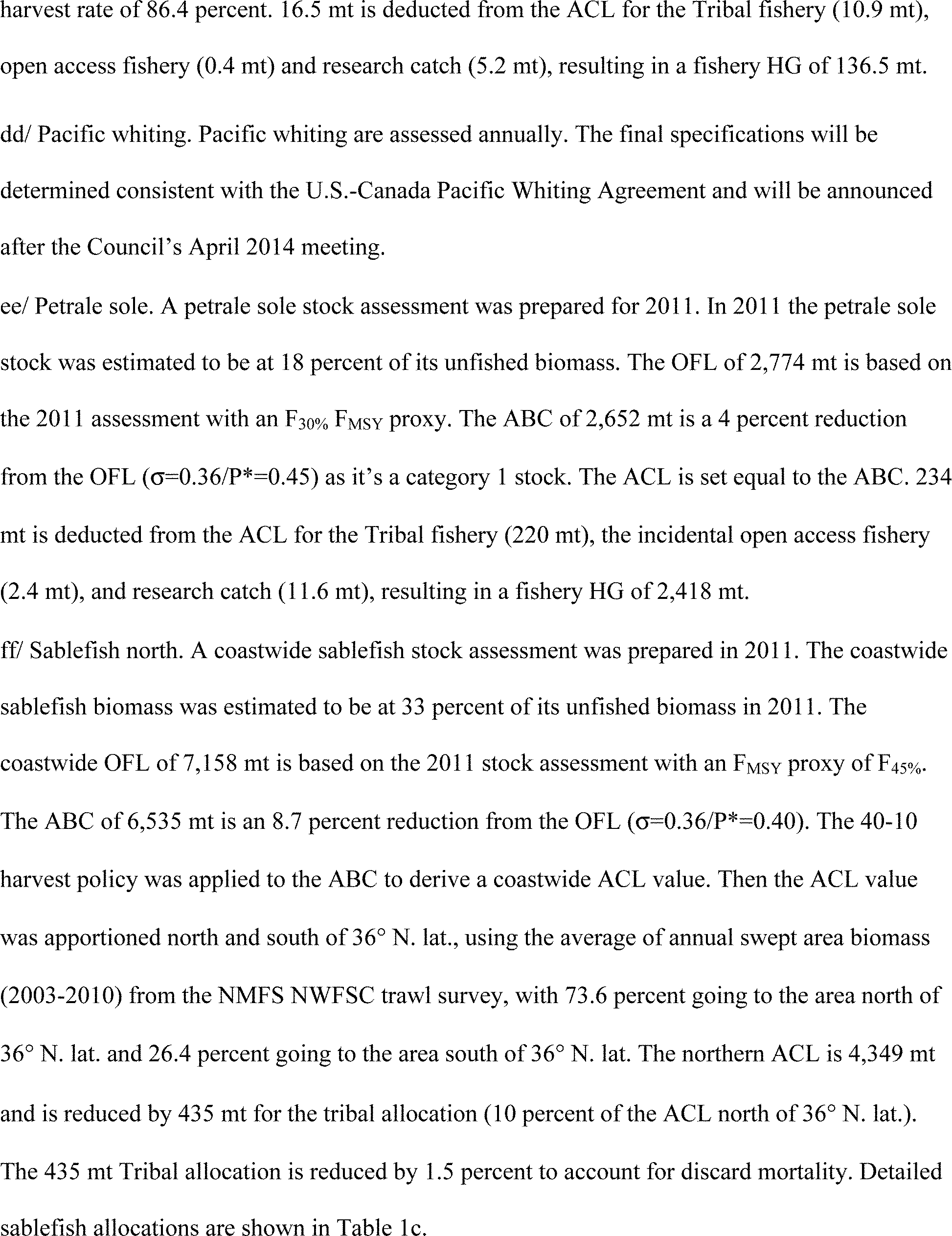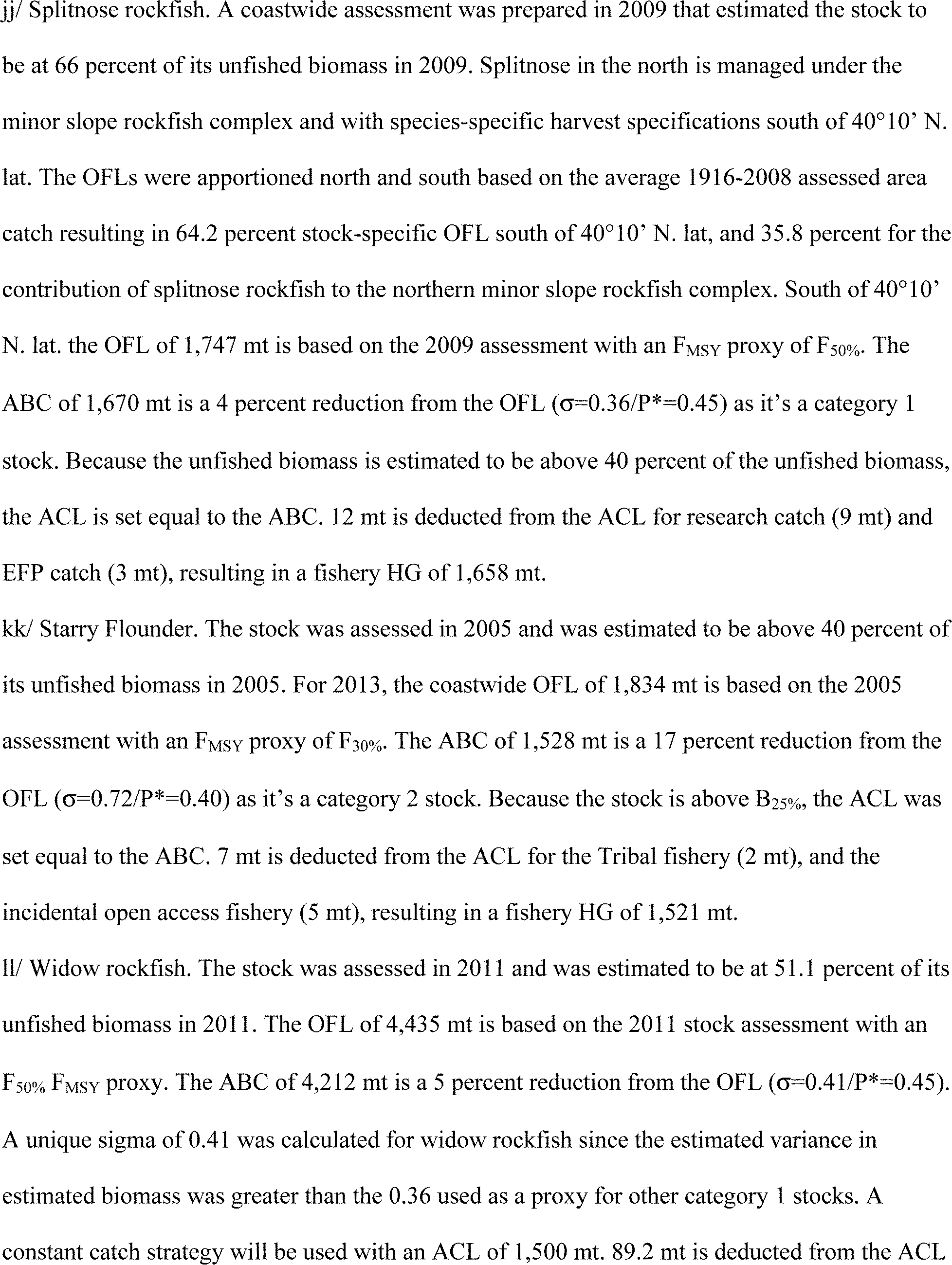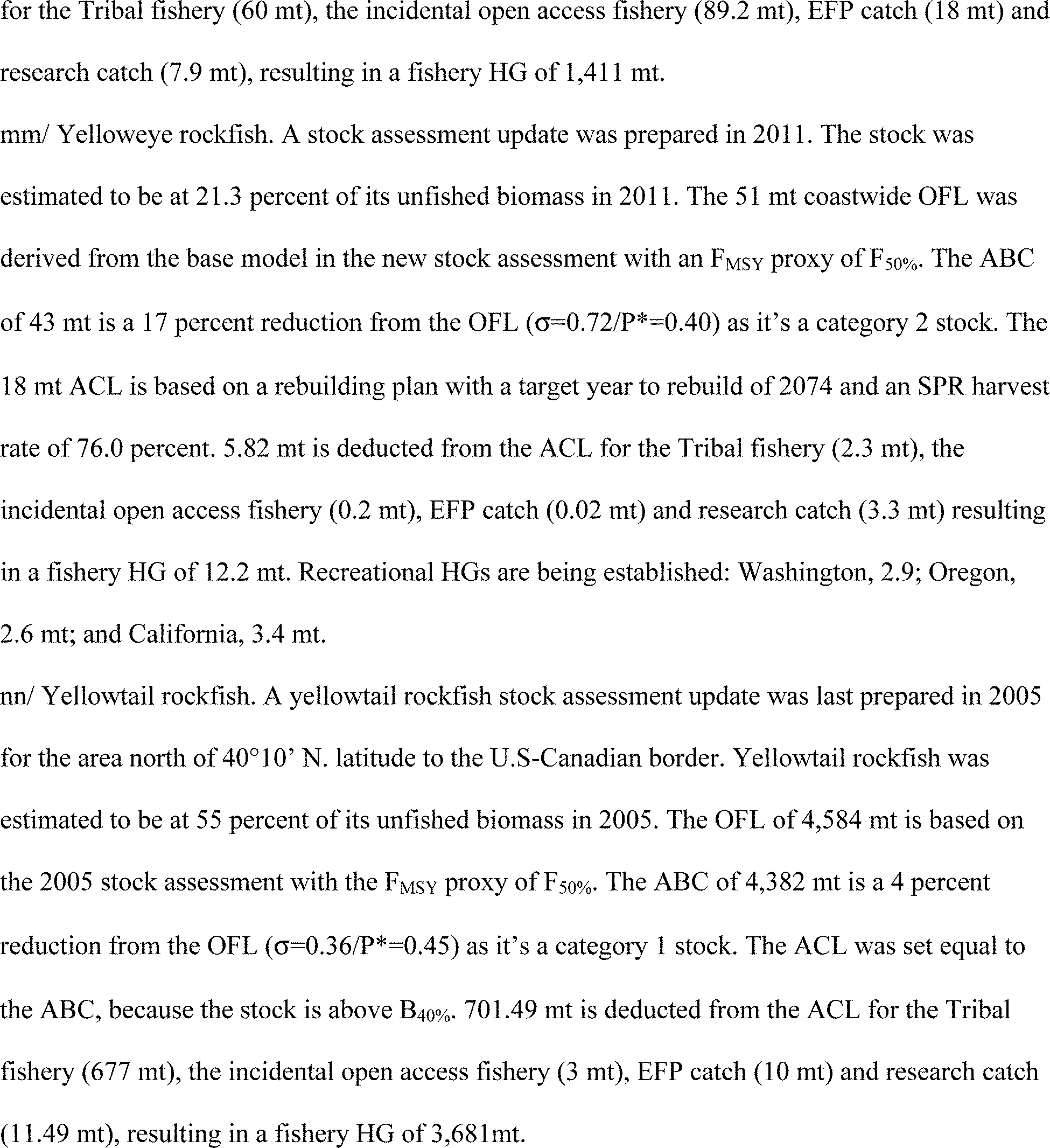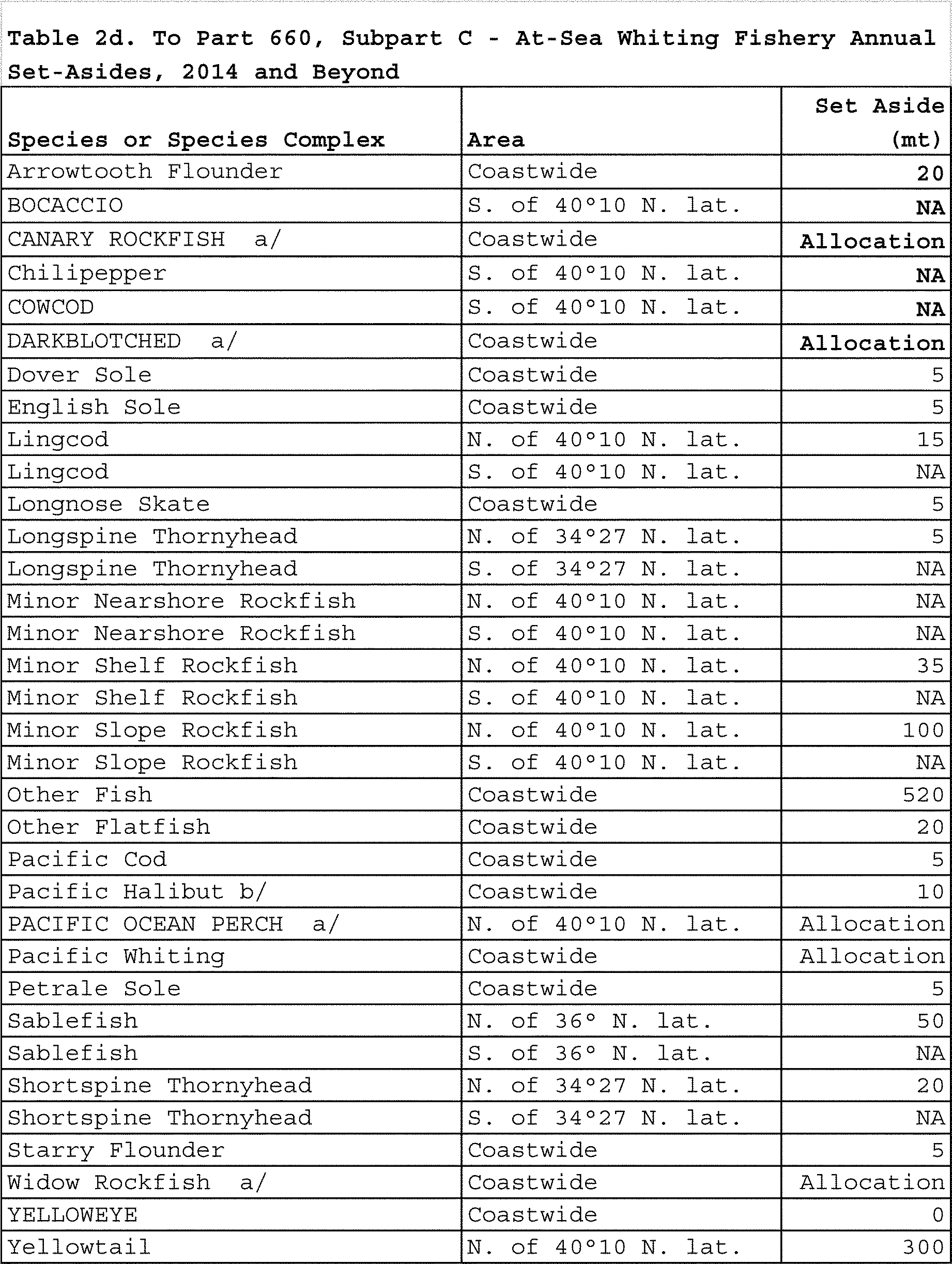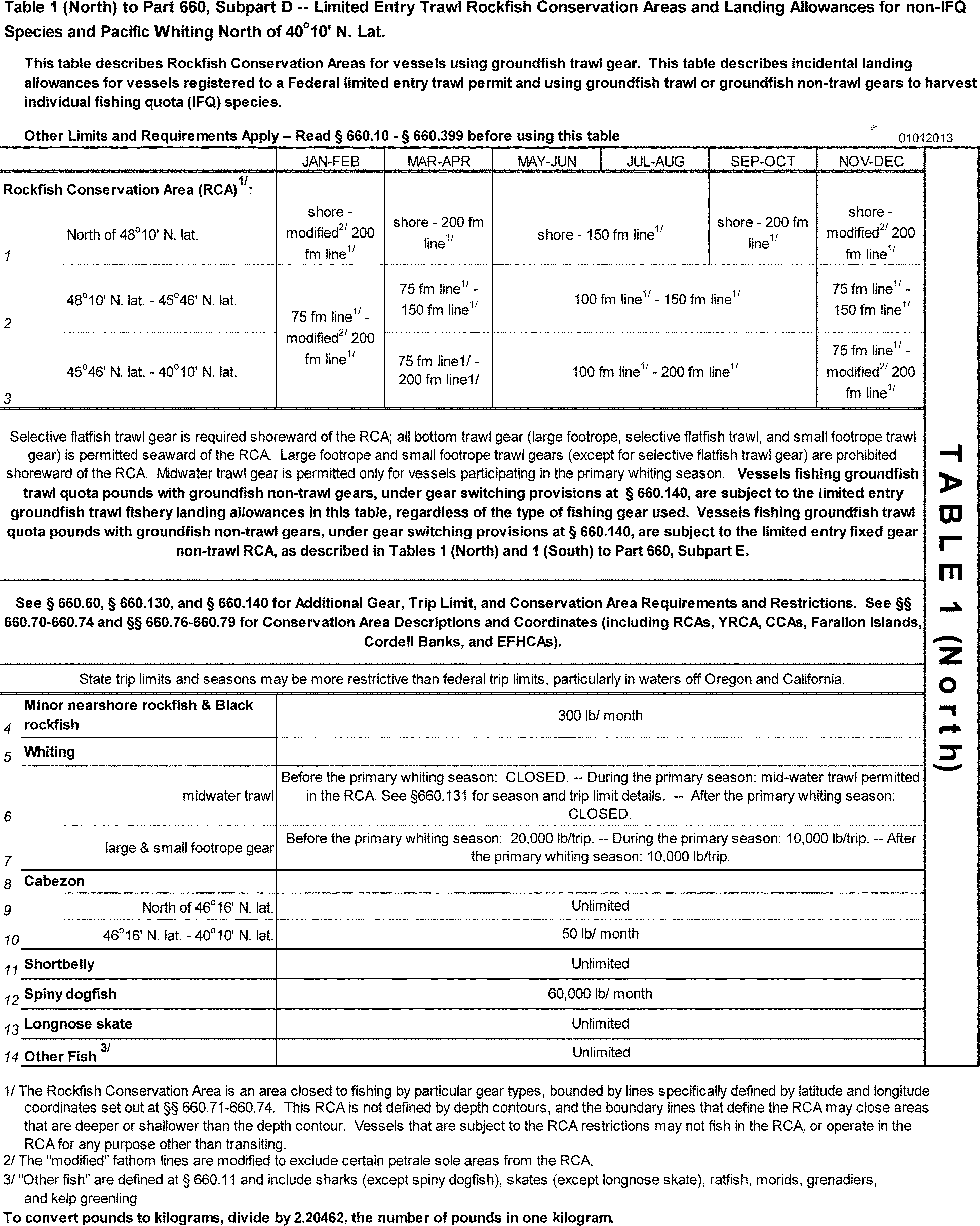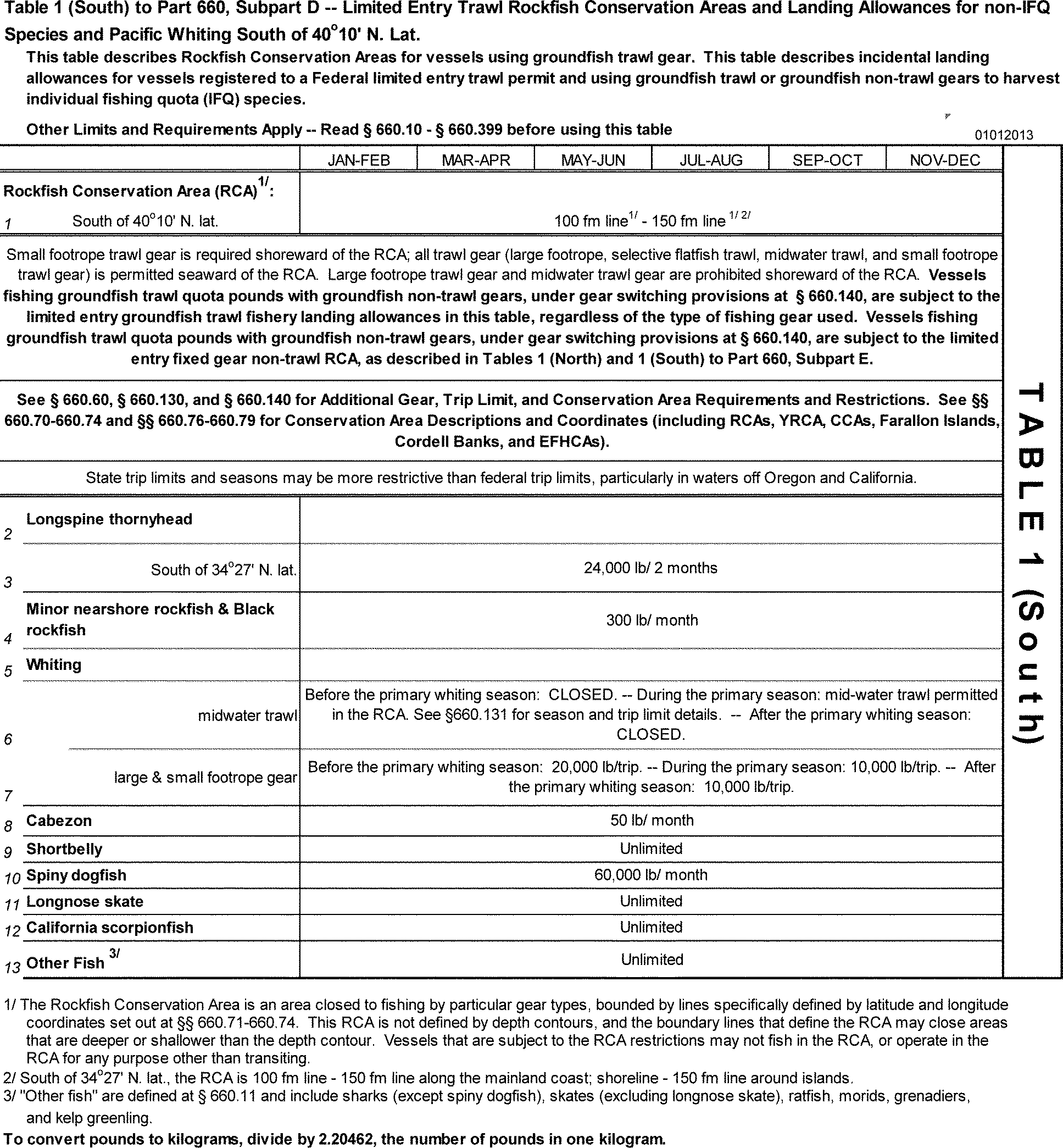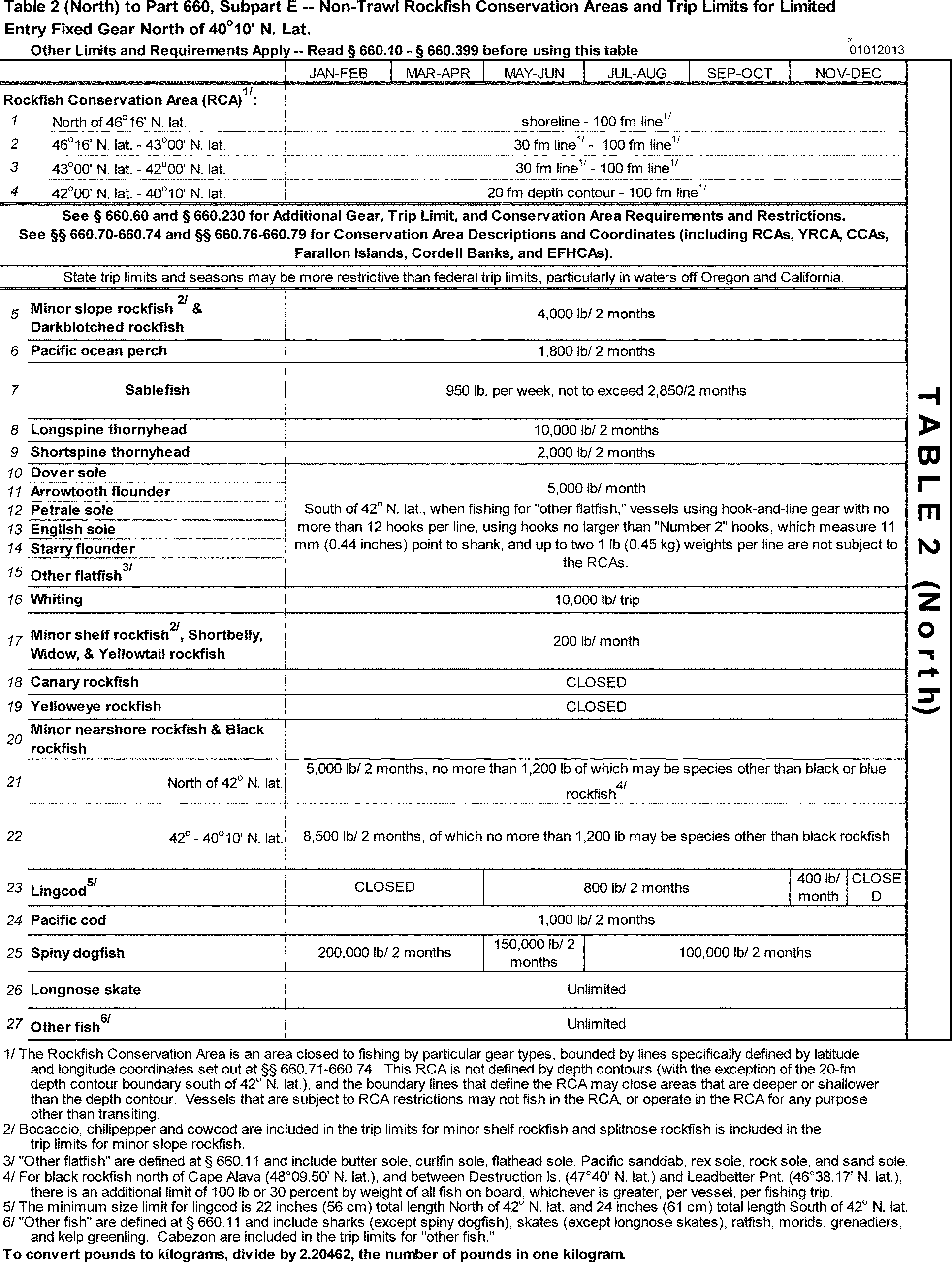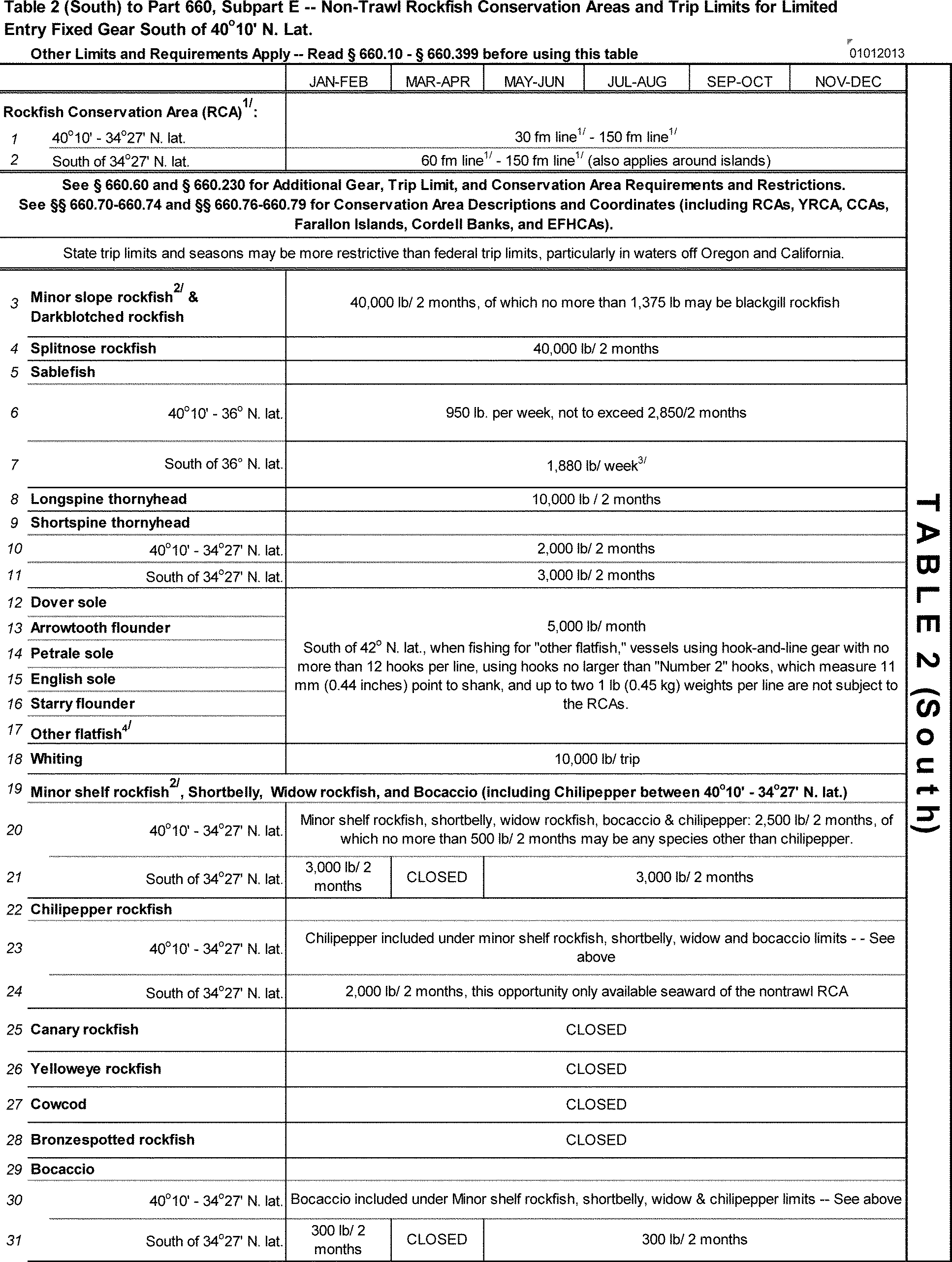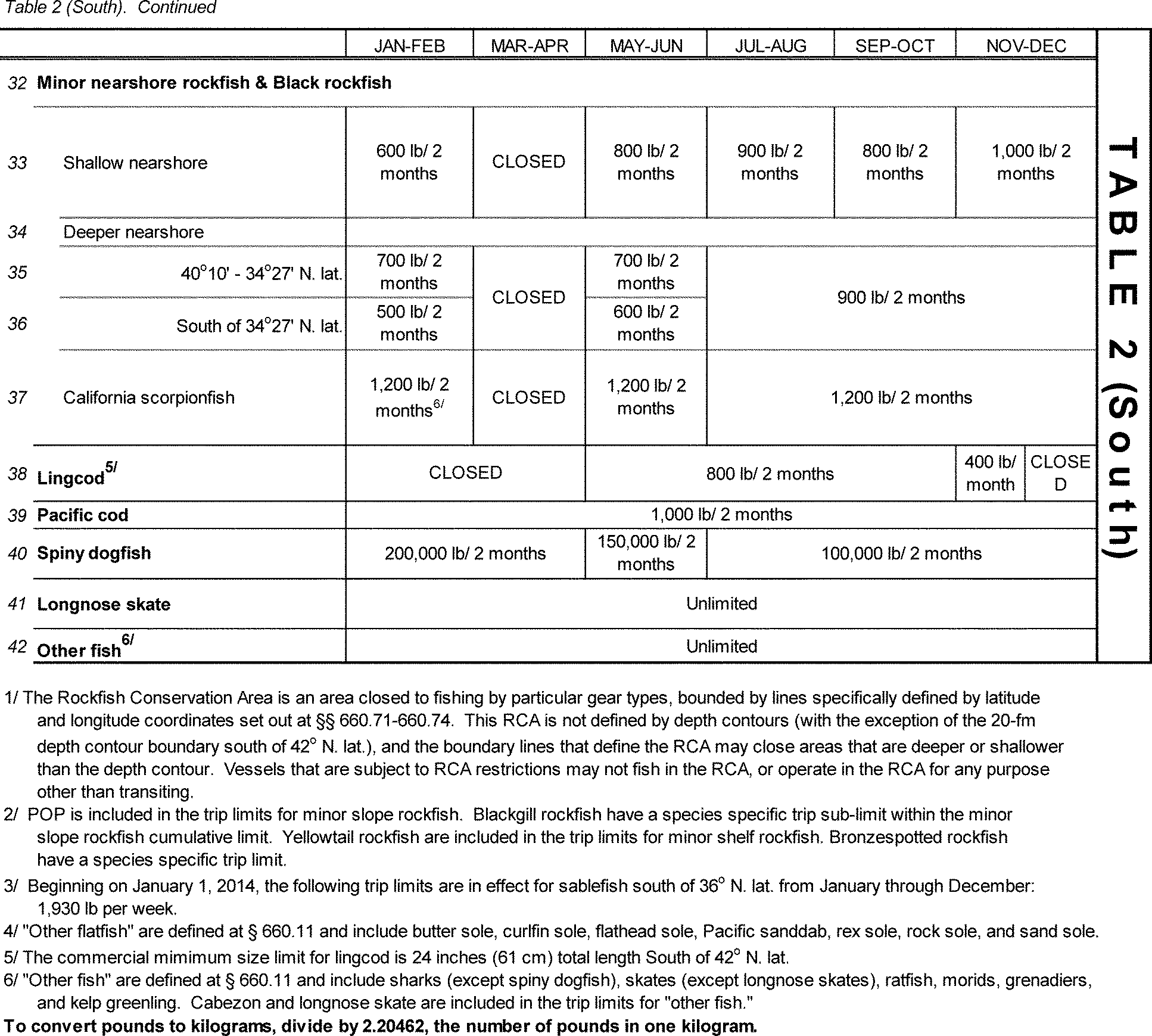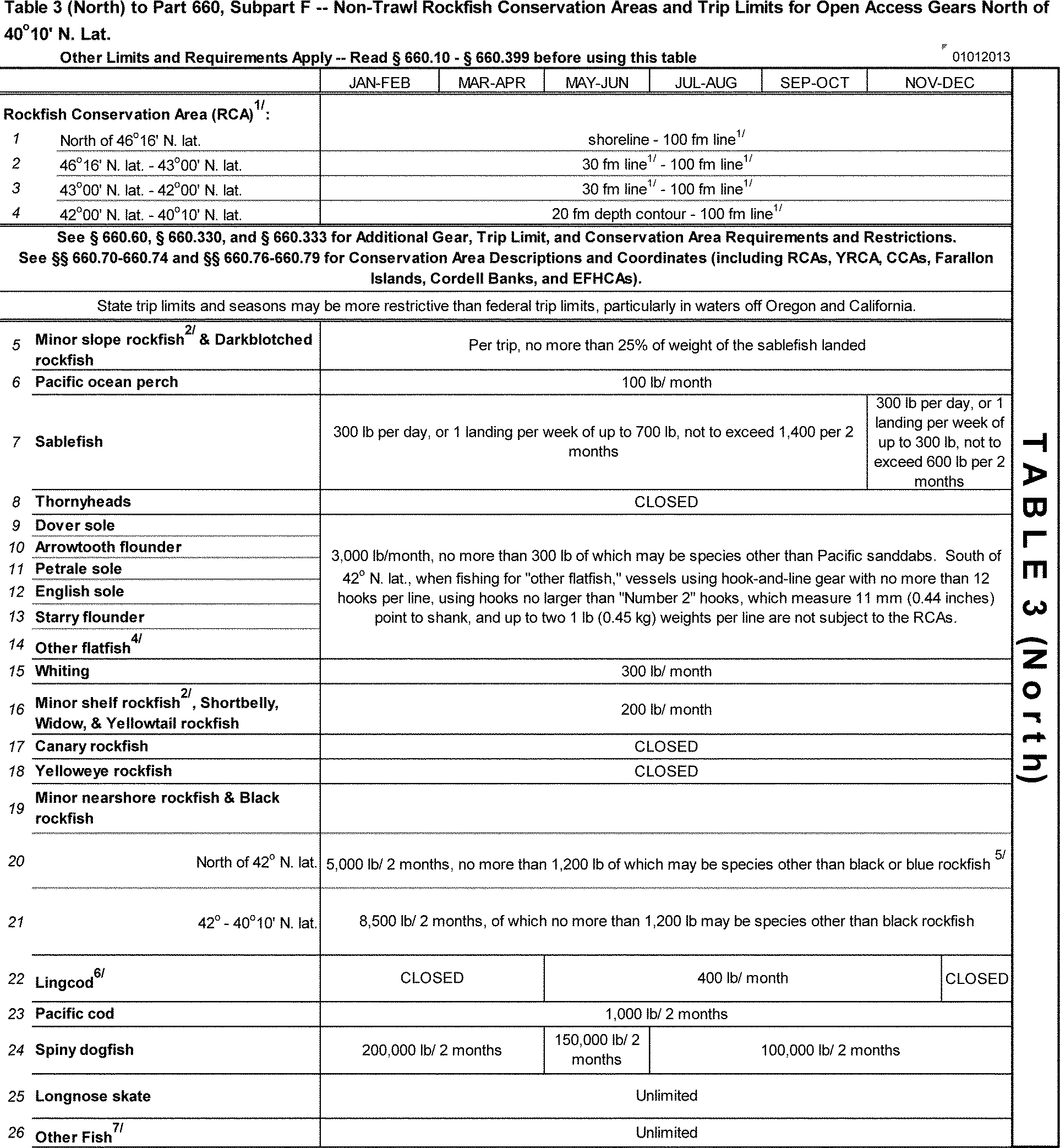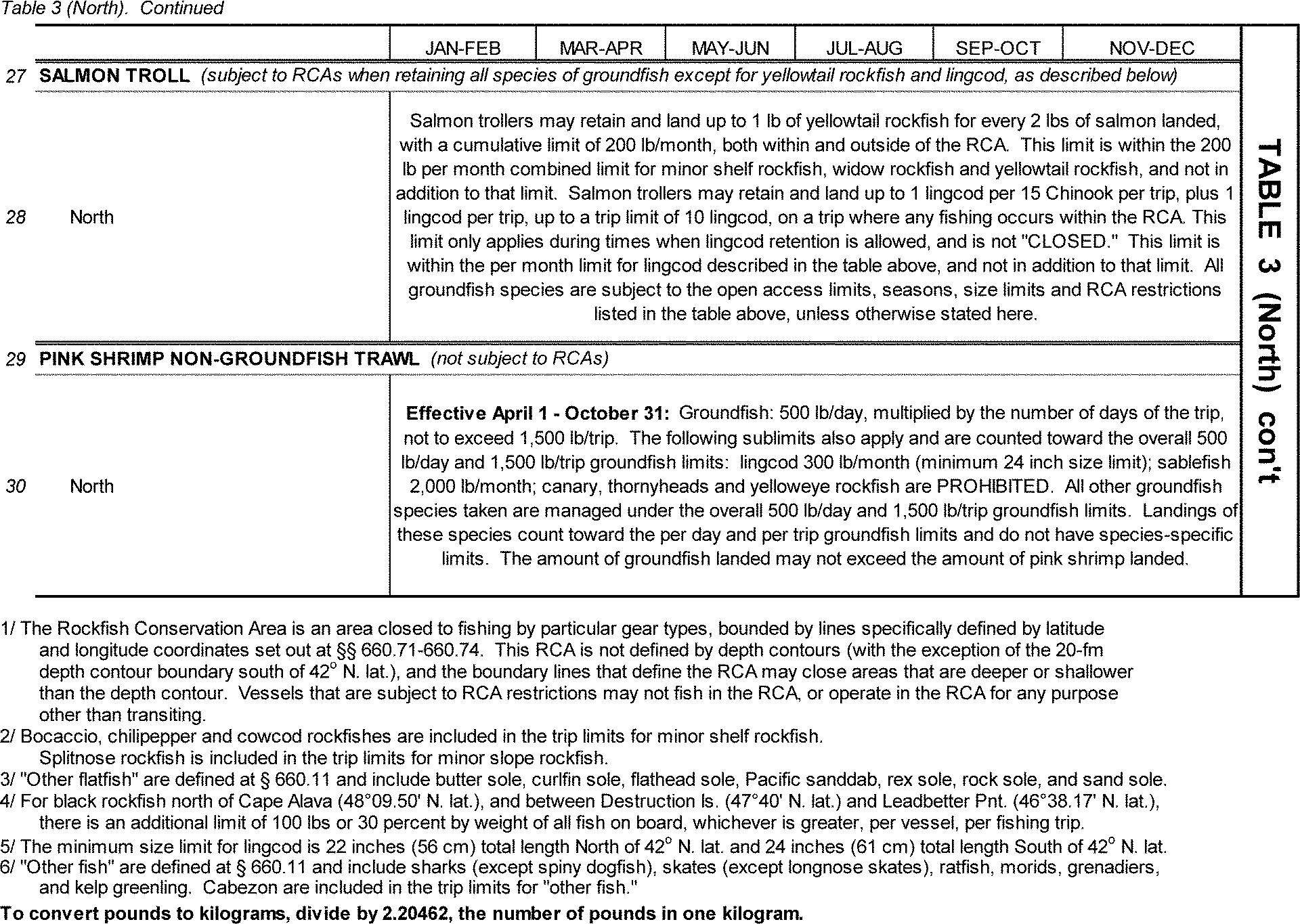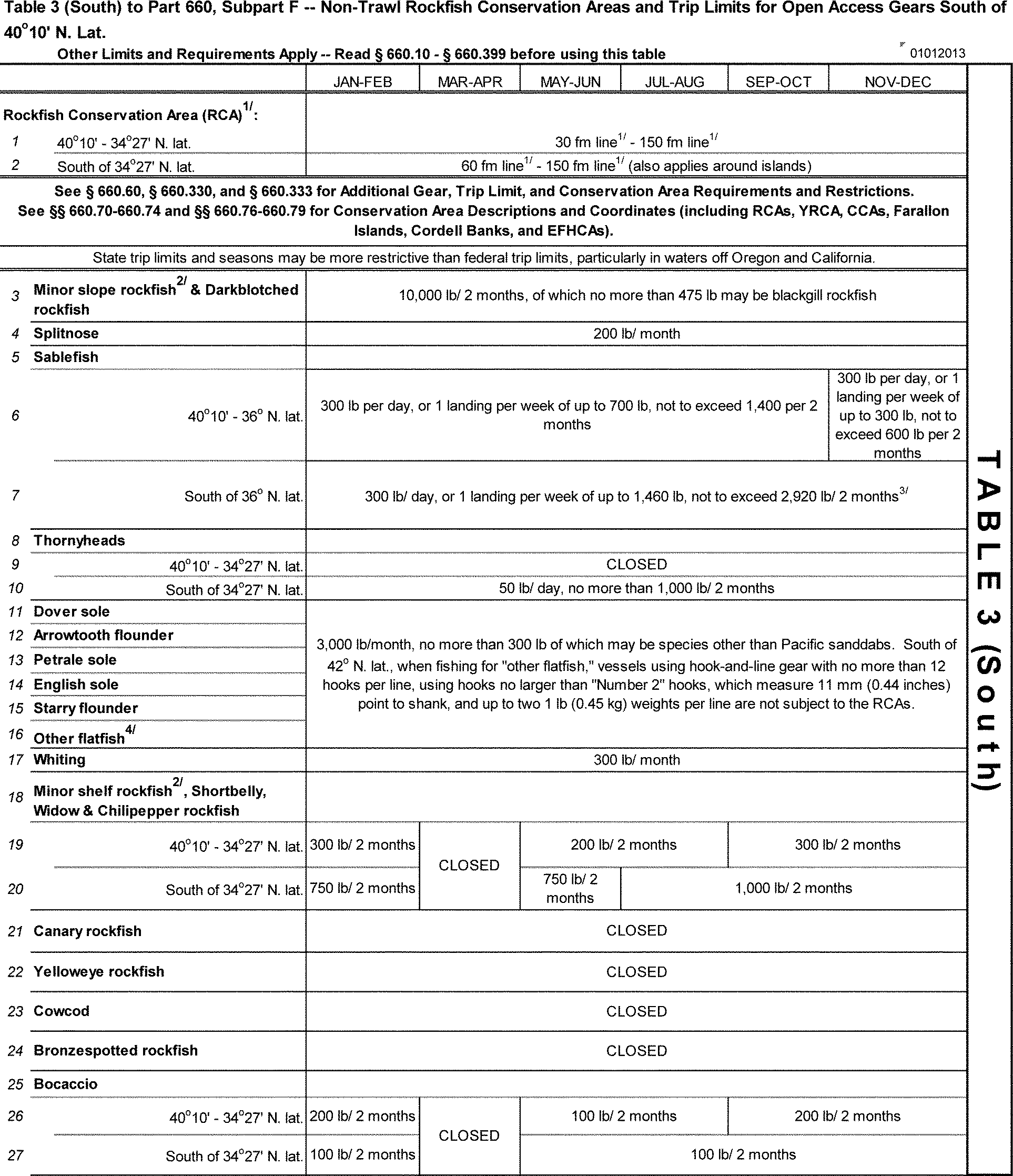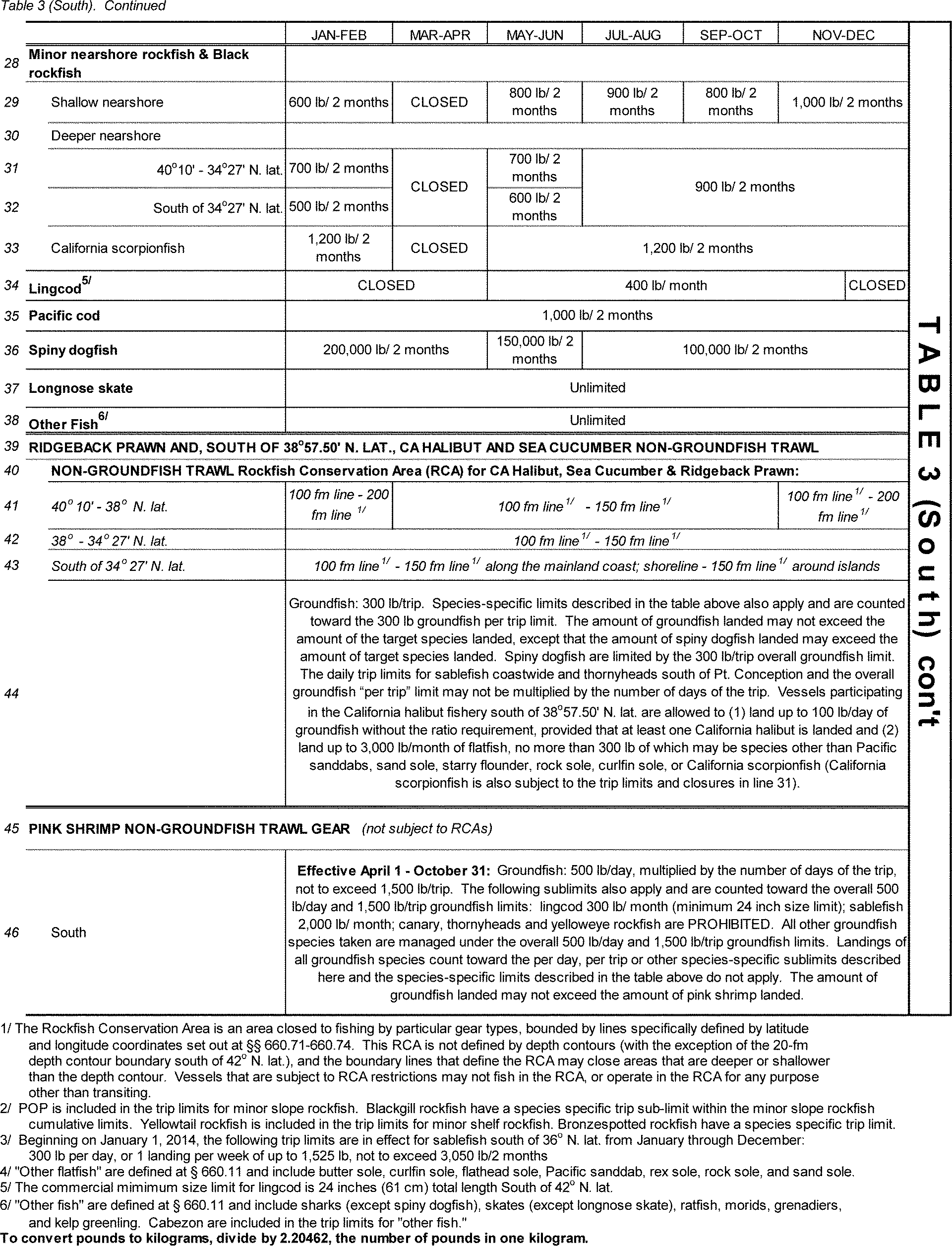2012-31134. Magnuson-Stevens Act Provisions; Fisheries Off West Coast States; Pacific Coast Groundfish Fishery; 2013-2014 Biennial Specifications and Management Measures
-
Start Preamble
Start Printed Page 580
AGENCY:
National Marine Fisheries Service (NMFS), National Oceanic and Atmospheric Administration (NOAA), Commerce.
ACTION:
Final rule.
SUMMARY:
This final rule establishes the 2013-2014 harvest specifications and management measures for groundfish taken in the U.S. exclusive economic zone off the coasts of Washington, Oregon, and California consistent with the Magnuson-Stevens Fishery Conservation and Management Act (MSA) and the Pacific Coast Groundfish Fishery Management Plan (PCGFMP). This final rule also revises the collection of management measures in the groundfish fishery regulations that are intended to keep the total catch of each groundfish species or species complex within the harvest specifications.
DATES:
This rule is effective January 1, 2013.
ADDRESSES:
Information relevant to this final rule, which includes a final environmental impact statement (EIS), the Record of Decision (ROD), a regulatory impact review (RIR), and a final regulatory flexibility analysis (FRFA) are available from William Stelle, Regional Administrator, Northwest Region, NMFS, 7600 Sand Point Way NE., Seattle, WA 98115-0070. Electronic copies of this final rule are also available at the NMFS Northwest Region Web site: http://www.nwr.noaa.gov.
Start Further InfoFOR FURTHER INFORMATION CONTACT:
Sarah Williams, phone: 206-526-4646, fax: 206-526-6736, or email: sarah.williams@noaa.gov.
End Further Info End Preamble Start Supplemental InformationSUPPLEMENTARY INFORMATION:
Electronic Access
This rule is accessible via the Internet at the Office of the Federal Register Web site at https://www.federalregister.gov. Background information and documents are available at the NMFS Northwest Region Web site at http://www.nwr.noaa.gov/Groundfish-Halibut/Groundfish-Fishery-Management/index.cfm and at the Pacific Fishery Management Council's Web site at http://www.pcouncil.org.
Executive Summary
I. Purpose of the Regulatory Action
This final rule implements the 2013-2014 harvest specifications and management measures for groundfish species taken in the U.S. exclusive economic zone off the coasts of Washington, Oregon, and California. The purpose of this action is to conserve and manage Pacific Coast groundfish fishery resources to prevent overfishing, to rebuild overfished stocks, to ensure conservation, to facilitate long-term protection of essential fish habitats (EFH), and to realize the full potential of the Nation's fishery resources. The need for this action is to set catch limit specifications and management measures for 2013-2014 that are consistent with existing or revised overfished species target rebuilding years and harvest control rules for all stocks. These harvest specifications are set consistent with the optimum yield (OY) harvest management framework described in Chapter 4 of the PCGFMP. This rule is authorized by 16 U.S.C. 1854-55 and by the PCGFMP.
II. Major Provisions
This final rule contains two types of major provisions. The first are the harvest specifications for all groundfish species and species complexes (overfishing limits (OFLs), acceptable biological catches (ABCs), and annual catch limits (ACLs)), and the second are management measures designed to keep fishing mortality within the ACLs. The harvest specifications (OFLs, ABCs, ACLs) in this rule have been developed through a rigorous scientific review and decision-making process, which is described in detail in the proposed rule for this action (77 FR 67974, November 14, 2012) and not repeated here.
In summary, the OFL is the maximum sustainable yield (MSY) harvest level and is an estimate of the catch level above which overfishing is occurring. The ABC is an annual catch specification that is the stock or stock complex's OFL reduced by an amount associated with scientific uncertainty. The ACL is a harvest specification set equal to or below the ABC. The ACLs are decided in a manner to achieve OY from the fishery, which is the amount of fish that will provide the greatest overall benefit to the Nation, particularly with respect to food production and recreational opportunities and taking into account the protection of marine ecosystems. The ACLs are based on consideration of conservation objectives, socio-economic concerns, management uncertainty and other factors. All known sources of fishing and research catch are counted against the ACL.
This final rule includes ACLs for the seven overfished species managed under the PCGFMP. For the 2013-2014 biennium two species, canary rockfish and Pacific ocean perch (POP), require rebuilding plan changes. These changes are necessary because the rebuilding analyses showed that even in the absence of fishing, these two species were unlikely to rebuild by the current target rebuilding year (TTARGET) in their rebuilding plans. Because of the multispecies nature of the groundfish fishery (the ACL of one species can influence the ACL and/or access to another species), the choice of canary rockfish and POP harvest rates, and the resulting ACLs and TTARGETS, were carefully considered by the Pacific Fishery Management Council (Council). In its final recommendation the Council weighed many factors including rebuilding progress, biology of the stock, economic impacts, allocations, and the need for new or more restrictive management measures. Ultimately, the Council recommended maintaining the harvest rate in the existing rebuilding plans for POP and canary rockfish and establishing revised TTARGETS.
In order to keep mortality of the species managed under the PCGFMP within the ACLs the Council also recommended management measures. Generally speaking, management measures are intended to rebuild overfished species, prevent ACLs from being exceeded, and allow for the harvest of healthy stocks. Management measures include time and area restrictions, gear restrictions, trip or bag limits, size limits, and other management tools. Management measures may vary by fishing sector because different fishing sectors require different types of management to control catch. Most of the management measures the Council recommended for 2013-2014 were slight variations to existing management measures and do not represent a change from current management practices. These types of changes include changes to trip limits, bag limits, closed areas, etc. However, several new management measures were recommended by the Council and proposed by NMFS. Those measures are described in detail in the proposed rule for this action.
This final rule implements the same regulations that were described in the proposed rule with a few exceptions. Start Printed Page 581All of these changes are discussed in detail below in Changes from the Proposed Rule.
Background
The Pacific Coast Groundfish fishery is managed under the PCGFMP. The PCGFMP was prepared by the Council, approved on July 30, 1984, and has been amended numerous times. Regulations at 50 CFR part 660, subparts C through G, implement the provisions of the PCGFMP. The PCGFMP requires the harvest specifications and management measures for groundfish to be set at least biennially. This final rule is based on the Council's final recommendations that were made at its June 2012 meeting, with slight modifications to reflect the Council's inseason management recommendations made at its November 2012 meeting, which are described below along with other minor changes from the proposed rule.
The Notice of Availability for the FEIS for this action was published on October 12, 2012 (77 FR 62235). The final preferred alternative in the FEIS is the same as the Council's preferred alternative that was described in the proposed rule for this action. See the preamble to the proposed rule for additional background information on the fishery and on this final rule.
Comments and Responses
NMFS published a proposed rule on November 14, 2012 (77 FR 67974) with a comment period that closed on December 5, 2012. NMFS received six letters of comment on the proposed rule. Three letters of comment came from industry requesting reconsideration of trip limits that are proposed to be lower in 2013-2014 than they were in 2012. One commenter requested that a two-month seasonal closure of the nearshore fishery be lifted, and opened under trip limits during that time of year. California Department of Fish and Game (CDFG) requested that NMFS reconsider the regulations that would clarify that landing and offloads must be completed prior to beginning a new fishing trip. CDFG also noted a few mistakes in the preamble of the proposed rule. One commenter also requested further consideration of a limited access program for the open access fishery. NMFS also received a letter of no comment from the Department of the Interior.
Comment 1: NMFS should not drastically reduce the trip limits for sablefish in the open access fishery north of 36° N. lat. such that they attempt to eliminate the open access fishery and simultaneously raise the trip limits for sablefish south of 36° N. lat. NMFS should reconsider the open access sablefish trip limits.
Response: Trip limits for sablefish are based on the harvest specifications and area allocations for each year. These specifications are based on stock assessment information and reflect the best available science. The changes to harvest specifications for sablefish were discussed in the proposed rule. Specifically, the proposed rule described how the 2013 and 2014 coastwide OFLs and ABCs, ACLs, and allocations for the areas north and south of 36° N. lat. were derived.
The sablefish trip limits in this final rule are developed to keep catch within the new sablefish ACLs. The sablefish ACL for the area north of 36° N. lat. is decreasing from 5,347 mt in 2012 to 4,012 mt in 2013 and this is the primary reason for the decreased sablefish trip limits. The sablefish ACL for the area north of 36° N. lat. is allocated among the various sectors of the groundfish fishery consistent with PCGFMP Amendment 6 and Amendment 21; these allocations are unchanged from previous specifications cycles. Sablefish trip limits for each sector of the groundfish fishery are derived to achieve, but not exceed, the sablefish allocations for those sectors. Conversely, the sablefish ACL for the area south of 36° N. lat. is increasing from 1,258 mt in 2012 to 1,439 mt in 2013. The increase in the ACL is the primary reason for the increased sablefish trip limits for the area south of 36° N. lat.
The trip limits for sablefish are anticipated to keep catch below the 2013 and 2014 sablefish ACLs. NMFS disagrees with the commenter that differential trip limits north and south of 36° N. lat. are designed to eliminate the open access fishery. Based on updated information from the stock assessment, the distribution of the sablefish ACLs north and south of 36° N. lat differs slightly from that in 2012, and the SSC also advised the Council that a fuller time series of trawl survey and catch data informing stock biomass in the Conception area reduced the scientific uncertainty, making the added 50 percent reduction previously taken south of 36° N. lat. unnecessary. Sablefish trip limits for the open access fishery north of 36° N. lat. are 300 lb per day, or one landing per week of up to 700 lb, not to exceed 1,400 lb per two months in January-October (Periods 1-5) and are 300 lb per day, or one landing per week of up to 300 lb, not to exceed 600 lb per two months in November-December (Period 6). Sablefish trip limits for the open access fishery south of 36° N. lat., are 300 lb per day, or one landing per week of up to 1,460 lb, not to exceed 2,920 lb per two months in January-December (Periods 1-6). The trip limits described above include modifications that the Council recommended at its November meeting, as discussed in Changes from the Proposed Rule section.
Comment 2: Two commenters requested that NMFS reconsider the new, lower trip limits for blackgill rockfish in the open access fishery south of 40°10′ N. lat. Both commenters stated that they made investments in their gear and fishing vessels because of little observed fishing effort in their areas and an abundance of fish. They state that the much lower blackgill rockfish trip limits would not provide a viable targeting opportunity and will force fishers to target sablefish instead. Both commenters also stated that they had very little warning of the proposed change to blackgill rockfish trip limits.
Response: In June 2010, the Council initiated the public process for making changes to fishing regulations in the 2013-2014 biennial management cycle, beginning with the adoption of the schedule for new and updated groundfish stock assessments. Since June 2010, NMFS and the Council have solicited public input on the development of 2013-2014 harvest specifications and management measures, including changes to blackgill rockfish trip limits. All public comments were considered by the Council prior to their final recommendations in June 2012. NMFS and the Council also solicited public comment on the Draft Environmental Impact Statement (Notice of Availability, 77 FR 35961, June 15, 2012), and no comments were received regarding the proposed changes to blackgill rockfish trip limits.
In 2011, blackgill rockfish was assessed for the first time since 2005. The 2011 assessment base model estimates that depletion in spawning output was 30 percent at the start of 2011, putting the stock in the precautionary zone (above the 25 percent minimum stock size threshold but below the 40 percent management target). Compared to the 2005 assessment, which estimated that depletion had never dropped below 50 percent, the new stock assessment indicates a significantly more pessimistic view. The new harvest specifications for blackgill rockfish, including their contribution to the minor slope rockfish complex, are discussed in the preamble to the proposed rule (77 FR 67974, 67977-80, November 14, 2012). To keep harvest of blackgill rockfish within the new species-specific harvest guidelines Start Printed Page 582(HGs) for the area south of 40°10′ N. lat., of 106 mt and 110 mt in 2013 and 2014, respectively, changes to fishery management measures were necessary in the non-IFQ fisheries.
There are two primary measures used to control catch of groundfish in the non-IFQ fisheries: Area closures and trip limits. Appendix C of the EIS for the 2013-2014 harvest specifications and management measures indicates that reductions in bi-monthly trip limits would provide an effective tool to reduce harvest of blackgill rockfish south of 40°10′ N. lat. The Council considered a range of blackgill rockfish trip limits for both the limited entry fixed gear fishery and the open access fishery. For the open access fishery south of 40°10′ N. lat., available information on average catch of blackgill rockfish from 2008-2010 indicated that a bi-monthly limit between approximately 400 lb (181 kg) and 500 lb (227 kg) per two months would keep harvest of blackgill rockfish within the open access portion of the non-trawl allocation. Analyses also indicated that as long as the blackgill rockfish trip limit was higher than 400 lb per 2 months, less than 10 percent of open access vessels would see their catch of blackgill rockfish reduced in order to comply with the proposed bi-monthly limit (475 lb (215 kg) per 2 months).
The trip limits for blackgill rockfish are anticipated to keep catch below the new 2013 and 2014 blackgill rockfish HGs. For the limited entry fixed gear fishery south of 40°10′ N. lat., this final rule establishes a species-specific sublimit within the minor slope rockfish limit, for blackgill rockfish of 1,375 lb (653 kg) per two months, which is consistent with the proposed rule. For the open access fishery south of 40°10′ N. lat., this final rule establishes a species-specific sub-limit within the minor slope rockfish limit, for blackgill rockfish of 475 lb (215 kg) per two months, which is also consistent with the proposed rule.
Comment 3: The closure of the California nearshore groundfish fishery during March and April has a negative effect on groundfish fishermen because market demand for fresh fish during those months must be met by other sources. NMFS should adjust the nearshore fishery trip limits to eliminate this two-month closure and to allow the nearshore fishery to operate year round.
Response: Trip limits for nearshore species are designed to keep fishing mortality within nearshore species harvest specifications while providing year-round fishing opportunity, if possible, consistent with Management Goal 3, Utilization in section 2.1, and the guidance on trip landing limits in section 6.7.2, of the PCGFMP. Since at least 2002, there has been a two-month closure in the nearshore fisheries south of 40°10′ N. lat. Beginning in 2002, some commercial fishing opportunities were restricted to reduce harvest of overfished rockfish species. Seasonal closures were implemented in the limited entry fixed gear and open access commercial nearshore fisheries during the closed seasons for recreational fisheries in the same areas. The Council and NMFS took this action to reduce overall targeting of rockfish using hook and line gears, both commercial and recreational, to achieve lower mortality on overfished species (67 FR 1555, 1574, January 11, 2002). NMFS will forward this request to the Council for consideration and additional analysis and encourages the commenter to follow up with their representatives on the Council and its advisory bodies; however, based on the recommendations of the Council, this final rule does not eliminate the two month closure.
Comment 4: CDFG does not support applying the requirement for a full offload of fish prior to the commencement of a new fishing trip to the limited entry fixed gear and open access fisheries. Also, CDFG stated they had concerns about conflicting information in the EIS relative to the fiscal impacts of this requirement.
Response: Existing regulations essentially require a full offload before the start of a new fishing trip; these regulations include the definition of landing at § 660.11, and specifications and management measures on landings at § 660.60(h)(2), which apply to the limited entry fixed gear and open access fisheries. Specifically, the regulations require that once transfer of fish begins at an offload, all fish onboard are counted as part of that landing and must be recorded as such. While this implies that all fish must be off the vessel before starting the next fishing trip, a prohibition would make it clearer. The new prohibition in § 660.12 corresponds to these existing provisions, makes the requirement explicit, and mirrors the existing prohibitions for the limited entry trawl fisheries at § 660.112(b)(1)(xv) and (d)(8). Therefore, as discussed in the EIS, the impacts of the new prohibition in § 660.12 are not expected to be considerable because current practices already comply with the existing regulations. Because the changes to regulations in this rule essentially correspond to existing regulations and to current practices, no changes are made in response to this comment.
CDFG expressed concerns about fiscal impacts and statements in the EIS that CDFG considered to be conflicting, but NMFS notes that one statement concerns the presence of costs while the other the magnitude of the costs. The quoted text states this measure would “increase costs” and would result in “no considerable change in impacts”. NMFS believes a small increase in costs, like the one anticipated in this case, could result in no considerable change in impacts.
CDFG also stated that it was unclear whether the current practice of split deliveries would still be permissible. NMFS points out that split deliveries are allowed under current federal regulations, although a state may have more restrictive state regulations. This final rule does not change that. In the limited entry fixed gear and open access fisheries, how the landing is delivered and recorded on a state fish receiving ticket is addressed under state regulation and should comply with federal requirements.
Regarding the need for the change in regulations, NMFS notes that during the development of the trawl rationalization program, a prohibition was added to make it explicit that the requirements at § 660.11 and § 660.60(h)(2) require all fish to be offloaded before starting a new fishing trip. However, the same prohibition was not implemented for the limited entry fixed gear and open access fisheries through that rule because that rule focused on the limited entry trawl fisheries. Therefore, the prohibition is added as part of this rule and applies to the limited entry fixed gear and open access fisheries in addition to the limited entry trawl fisheries (except for processing vessels in the mothership and catcher/processor sectors). The requirements at § 660.11, § 660.60(h)(2), and now the prohibition at § 660.12(a)(11) support catch accounting and provide for enforcement of harvest limits by making it clear which fishery information (such as vessel monitoring system data, fishery declaration data, observer data, logbook data (if applicable), per trip limits, etc.) applies to the fish being reported as part of that landing.
Finally, NMFS specifically requested comments on this issue in the proposed rule for this action and only CDFG submitted comments regarding the matter. No comments were received on this issue during the comment period on the draft EIS or the final EIS.
Comment 5: CDFG noted several inconsistencies between numbers in the preamble of the proposed rule with Start Printed Page 583numbers in the proposed regulations; the numbers in regulation were all correct but some incorrect numbers published in the preamble text.
Response: NMFS acknowledges the errors in the preamble of the proposed rule. NMFS has thoroughly reviewed the regulations that are implemented in this final rule and has found no errors requiring correction from what was proposed in the regulatory text.
Comment 6: NMFS should reconsider the 2007 proposal for a license limitation program for the open access fishery.
Response: At its March 2009 meeting, the Council voted for a registration only program for the open access fishery, and did not choose to implement a Federally-permitted limited access program in the commercial open access groundfish fishery. Deciding whether or not to implement a program that limits participation in the open access fishery was not discussed in the proposed rule and is not part of this final rule.
Comment 7: The United States Department of the Interior stated they have no comments.
Response: NMFS appreciates the Department of the Interior submitting its no comment conclusion.
Changes From the Proposed Rule
This final rule contains some modifications to the proposed rule to reflect the Council's inseason recommendations made at its November 2012 meeting. This rule also includes changes to the deficit carryover provisions as a consequence of the geographic split of lingcod in the shorebased IFQ fishery. NMFS made these minor adjustments to the 2013-2014 harvest specifications and management measures in response to updated fishery information and to further refine regulations consistent with the intent of the proposed regulations.
The Council reviews the most recent and best available scientific information at each of its meetings to determine whether potential changes to routine management measures are appropriate. These changes have the intent to achieve, to the extent possible, but not exceed, ACLs of target species, while fostering the rebuilding of overfished stocks. At its November 3-7 meeting in Costa Mesa, CA, the Council, in consultation with Pacific Coast Treaty Indian Tribes and the States of Washington, Oregon, and California, recommended changes to the 2013-2014 proposed groundfish management measures based upon updated fishery information and subsequent inseason management needs. These changes: (1) Decrease sablefish limits in the Limited Entry Daily Trip Limit (DTL) fishery North of 36° N. lat.; (2) Modify trip limits for sablefish in the Open Access fishery North of 36° N. lat.; and, (3) revise Washington State recreational groundfish fishery management measures in Marine areas 3 and 4 to be more precautionary.
Limited Entry (LE) Fixed Gear Fishery Management Measures
Sablefish Daily Trip Limit (DTL) Trip Limits North of 36° N. lat.
To ensure that harvest opportunities for this stock do not exceed the LE fixed gear sablefish DTL allocation north of 36° N. lat., the Council considered decreases to 2013 trip limits and the potential impacts on overall catch levels from trip limits in the proposed rule. Since publication of the proposed rule, model-based landings projections of the LE fixed gear sablefish DTL fishery north of 36° N. lat. were made for 2013 by the Council's Groundfish Management Team (GMT). These projections were made based on the most recent information available under the current 2012 trip limit scenario, and predicted a harvest attainment of 129 percent to 158 percent, depending on the range of possible fuel prices which would subsequently affect fishing effort, in excess of this fishery's harvest guideline under the status quo trip limits. An overage by the northern LE fixed gear sablefish DTL fishery could result in an overage of the northern sablefish ACL.
Therefore, the Council recommended and NMFS is implementing trip limit changes for the LE fixed gear sablefish DTL fishery in 2013 north of 36° N. lat. that decrease LE fixed gear sablefish DTL fishery limits from those suggested in the proposed rule from “1,100 lb (499 kg) per week, not to exceed 4,200 lb (1,905 kg) per 2 months” to “950 lb (431 kg) per week, not to exceed 2,850 lb (1293 kg) per 2 months” for periods 1-6. This change in trip limits is not anticipated to increase projected impacts to overfished species and is anticipated to help maintain mortality levels within the northern sablefish ACL.
Open Access (OA) Fixed Gear Fishery Management Measures
Sablefish Daily Trip Limit (DTL) Trip Limits North of 36° N. lat.
To ensure harvest opportunities for the OA fixed gear sablefish DTL fishery, and that its harvest guideline north of 36° N. lat. is attained without being exceeded, the Council considered decreases to trip limits for sablefish in this fishery and the potential impacts on overall catch levels. The Council's GMT made model-based landings projections of the OA fixed gear sablefish DTL fishery north of 36° N. lat. for 2013. These projections were based on the most recent information available under the current 2012 trip limit scenario, and projected a harvest of 88 percent (257 mt) of this fishery's harvest guideline (291 mt in 2013) under the status quo trip limits. At the November Council meeting, the Groundfish Advisory Sub-panel (GAP) requested an alternative trip limit structure for the Open Access North fishery to facilitate more viable fishing opportunities throughout the season when participants are more active in the fishery, largely due to weather considerations. The approach the Council recommended was to reduce trip limits in Period 6, in order to increase the limits for Periods 1 through 5.
Therefore, the Council recommended and NMFS is implementing trip limit changes for the OA fixed gear sablefish DTL fishery north of 36° N. lat. that adjust OA fixed gear sablefish DTL fishery limits from “300 lb per day (136 kg), or one landing per week of up to 610 lb (277 kg), not to exceed 1,220 lb (553 kg) per two months” for periods 1-6 as suggested in the proposed rule to “300 lb (136 kg) per day, or one landing per week of up to 700 lb (318 kg), not to exceed 1,400 lb (635 kg) per 2 months” for periods 1-5 and “300 lb (136 kg) per day or one landing per week up to 300 lb (136 kg), not to exceed 600 lbs (272 kg) per two months” for period 6 in 2013.
Washington Recreational Groundfish Fishery Management Measures
The Washington State Department of Fish and Wildlife (WDFW) briefed the Council at its September and November meetings that the recreational bottomfish fishery would exceed its yelloweye rockfish harvest guideline, and that the state had taken emergency action to close the fishery in Neah Bay and La Push beginning on September 4 for the remainder of the year. In order to prevent the Washington recreational bottomfish fishery from exceeding its harvest guideline in 2013 and 2014, WDFW requested more precautionary management measures for the Washington north coast area (Marine Areas 3 and 4), which the Council approved for 2013 and 2014 during its consideration of inseason management measures at its November meeting.
Management measures approved for the north coast for 2011-2012 restrict the recreational bottomfish fishery to the area shoreward of 20 fathoms from Start Printed Page 584June 1 to September 30, except on days open to the halibut fishery. Management measures approved for the north coast for 2013-2014 now restrict the recreational bottomfish fishery to the area shoreward of 20 fathoms from May 1 to September 30, except on days open to the halibut fishery. On days that the halibut fishery is open, no bottomfish except lingcod, Pacific cod, and sablefish can be retained seaward of 20 fathoms. The proposed changes to the recreational management measures from the proposed rule are specific to the north coast (Marine Areas 3 and 4) as the majority of Washington states' yelloweye encounters occur in this area. Restricting the bottomfish fishery to shallower water, and starting at a more precautionary earlier date, will reduce encounters with yelloweye rockfish and improve survivability of released fish. These more restrictive management measures are anticipated to allow Washington to stay within their 2013-2014 harvest guideline of 2.9 mt.
Therefore, the Council recommended and NMFS is implementing changes to the Washington recreational fisheries for 2013-2014 for Marine Areas 3 and 4, to restrict the recreational bottomfish fishery to the area shoreward of 20 fathoms from May 1 to September 30, except on days open to the halibut fishery, in which no bottomfish except lingcod, Pacific cod, and sablefish can be retained seaward of 20 fathoms. These adjustments to recreational fishery management measures are not expected to result in greater impacts to overfished species than originally projected through the end of 2013 or 2014.
Geographic Split of Lingcod in the Shorebased IFQ Program
Consistent with what was proposed, NMFS is dividing lingcod management north and south of 40°10′ N. lat. beginning in 2013. Regulations at § 660.140(c)(3)(vii)(A)(1) specify how to reallocate quota share (QS) for an IFQ species getting subdivided by area, which would be done for QS permits and their associated QS accounts beginning in 2013. In the proposed rule, NMFS proposed subdivided accumulation limits in the tables that describe QS control limits at § 660.140(d)(4)(i)(C) and the quota pound (QP) vessel limits at § 660.140(e)(4)(i), but did not propose a methodology for subdividing accumulation limits in regulation at § 660.140(c)(3)(vii) for use in future reallocations. Since the proposed rule published, NMFS has noted that the regulations also do not specify how to address carryover in the shorebased IFQ program when there is an area subdivision either within the carryover provisions at § 660.140(e)(5), or within the provisions addressing changes in management areas or subdivision of a species group as specified at § 660.140(c)(3)(vii). The Council and NMFS will need to consider how reallocations affect surplus carryover, QS control limits (including aggregate non-whiting groundfish species), vessel limits (including aggregate non-whiting groundfish species), and potentially, a different solution to deficit carryover. However, for deficit carryover an immediate solution is necessary because deficit carryover of the previously coastwide lingcod QP could occur on January 1, 2013. The addition of provisions addressing deficit carryover in this context is a logicial extension of what was proposed. Accordingly NMFS is implementing changes with this final rule at § 660.140(e)(5)(ii) to not allow carryover of a deficit into the following year for an IFQ species that has had a change in management areas or subdivision of a species group as specified at § 660.140(c)(3)(vii). In 2013, for any vessel account with a negative balance of coastwide lingcod QP that would have been carried over from 2012, NMFS will assume a balance of zero rather than a negative balance prior to any 2013 QP transfers of lingcod into that vessel account. This change is expected to impact very few, if any, vessel accounts in 2013. Any biological or socioeconomic impacts are expected to be minimal and within the range previously considered.
Classification
The Administrator, Northwest Region, NMFS, has determined that the 2013-2014 groundfish harvest specifications and management measures, which this final rule implements, are consistent with the national standards of the Magnuson-Stevens Act and other applicable laws.
NMFS finds good cause to waive the 30-day delay in effectiveness pursuant to 5 U.S.C. 553(d)(3), so that this final rule may become effective on January 1, 2013. Leaving the 2012 harvest specifications and management measures in place could cause harm to some stocks because those management measures are not based on the most current scientific information; in addition, it could cause drastic management changes later in the year to prevent exceeding some lower 2013 harvest specifications once they are implemented. For example, the sablefish ACL and commercial trip limits for the area north of 36° N. lat. are lower in 2013 than in 2012. If changes to reduce sablefish trip limits are delayed, higher sablefish trip limits will remain in place. If those higher trip limits are caught in these commercial fisheries early in the year, it could cause severe restrictions and potential closures later in the year. Additionally, if changes to management measures that could reduce catch of sablefish are delayed it could increase the risk of exceeding the lower 2013 ACL. Because this final rule also increases the catch limits for several species for 2013, leaving 2012 harvest specifications in place could unnecessarily delay fishing opportunities until later in the year, potentially reducing the total catch for these species in 2013. Thus, a delay in effectiveness could ultimately cause economic harm to the fishing industry and associated fishing communities or result in harvest levels inconsistent with the best available scientific information. As a result of the potential harm to fish stocks and fishing communities that could be caused by delaying the effectiveness of this final rule, NMFS finds good cause to waive the 30-day delay in effectiveness.
NMFS also finds good cause to waive prior public notice and comment on the changes to the proposed rule in response to the Council's inseason recommendations for revisions to groundfish fishery management measures. NMFS finds good cause under 5 U.S.C. 553(b) because notice and comment would be impracticable and contrary to the public interest.
Providing prior notice and opportunity to comment on the Council's inseason recommendations would be impracticable because managing the fishery pursuant to the best scientific information available requires that these changes be in place by January 1, 2013. Because the Council met in November 2012, there was not sufficient time after receiving the Council's recommendations to issue a proposed rule and allow for public comment before these actions needed to be in effect. Affording the time for prior notice and opportunity for public comment would have prevented NMFS from managing fisheries using the best available science to approach, without exceeding, the ACLs for federally managed species in accordance with the FMP and applicable law. The Council's recommendations are modifications to routine management measures that adaptively respond to updated fishery information. If the harvest specifications contained in this rule become final prior to the Council's recommend inseason modifications, then harvesting at the beginning of 2013 could occur in a manner inconsistent with the most Start Printed Page 585recent scientific information, which would be contrary to NMFS' legal mandate under the MSA.
In addition, delaying the implementation of the Council's inseason recommendations to allow for prior notice and public comment would be contrary to the public interest. Delaying implementation could result in potential harm to both fish stocks and fishing communities. For example, the Council's review of the best available information indicated that reduced limited entry commercial trip limits are necessary for sablefish in the area north of 36° N. lat. These reduced limits must be in place at the beginning of period 1 (January-February) to reduce the likelihood of exceeding the sablefish ACL and minimize the need for drastic reductions in harvest later in the year, which could cause significant economic harm to fishing communities that rely on this fishery. The increased opportunities earlier in the year for the OA fixed gear fishery are also important to fishing communities and it would be contrary to the public interest to not allow these fishermen access to harvest limits that are based on the best scientific information available. Similarly, reducing the potential for yelloweye rockfish mortality to exceed the recreational groundfish yelloweye rockfish harvest guideline is important for rebuilding overfished stocks. A delay in implementation of the Council's recommendations would impair achievement of the PCGFMP goals and objectives of managing for appropriate harvest levels while providing for fishing and marketing opportunities. Ultimately, taking the time necessary for full notice and comment rulemaking and a delay in effectiveness could cause economic harm to the fishing industry and associated fishing communities, in addition to adversely affecting fish stocks.
Accordingly, for the reasons stated above, NMFS also finds good cause to waive prior notice and comment on the changes from the proposed rule.
NMFS prepared an FEIS for the 2013-2014 groundfish harvest specifications and management measures. The Environmental Protection Agency published a notice of availability for the FEIS on October 12, 2012 (77 FR 622325.) A copy of the FEIS is available online at http://www.pcouncil.org/. In approving the 2013-2014 groundfish harvest specifications and management measures, NMFS issued a Record of Decision (ROD) identifying the selected alternatives. A copy of the ROD is available from NMFS (see ADDRESSES).
This final rule has been determined to be not significant for purposes of Executive Order 12866.
A final regulatory flexibility analysis (FRFA) was prepared. The FRFA incorporates the IRFA, a summary of the significant issues raised by the public comments in response to the IRFA, NMFS' responses to those comments, and a summary of the analyses completed to support the action. A copy of the FRFA is available from NMFS (see ADDRESSES) and a summary of the FRFA, per the requirements of 5 U.S.C. 604(a), follows:
NMFS received no comments to the RIR/IRFA. While none of the comments specifically addressed the IRFA, the first four comments discussed in the final rule concerned direct socio-economic implications of this rule on small commercial entities. There were requests for trip limit adjustments for open access sablefish (Comment 1) and for blackgill rockfish (Comment 2), for changes in the nearshore California groundfish season (Comment 3), and clarification that existing regulations essentially require a full offload before the start of a fishing trip (Comment 4). Comments 1-3 reflect requests for changes that may positively affect one set of small entities, but negatively affect others. Trip limits and seasons are designed to keep catch below 2013-2014 ACLs and reflect changes in stock assessment data, current allocation formulas among the fleets, and striving to achieve the goal of a year-round fishery. To keep within the ACLs, increases in bimonthly trip limits or increasing a season by two months in the beginning of the year would need to be balanced against decreasing trip limits later in the year or ending the season earlier in the year. The impacts of the new clarifying regulations on offloading (Comment 4) are not expected to be considerable because current practices already comply with the existing regulations which were clarified in this rule. The new regulations in this rule do not create new requirements but rather clarify existing practices.
NMFS agrees that the Council's choice of preferred alternatives would best achieve the Council's objectives while minimizing, to the extent practicable, the adverse effects on harvesters, processors, fishing support industries, and associated communities. The preamble above provides a statement and need for, and objective of this rule. The MSA provides the statutory basis for this rule. No duplicative, overlapping, or conflicting Federal rules have been identified. This final rule would not introduce any changes to current reporting, recordkeeping, and other complicance requirements.
This rule regulates businesses that harvest groundfish. This rule directly affects limited entry fixed gear permit holders, trawl QS and whiting catch history endorsed permit holders (which includes shorebased whiting processors), tribal vessels, charterboat vessels, and open access vessels. QS holders are directly affected because the amount of QP they receive based on their QS are affected by the ACLs. Vessels that fish under the trawl rationalization program receive their QP from the QS holders, and thus are indirectly affected if they only own vessel accounts rather than QS. Similarly, mothership processors are indirectly affected as they receive the fish they process from limited entry permits that are endorsed with whiting catch history assignments. According to the Small Business Administration (SBA), a small commercial harvesting business is one that has annual receipts under $4.0 million, a small charter boat business is one that has annual receipts under $7.0 million, and a small processor is one that employs 500 employees or fewer. To determine the number of small entities potentially affected by this rule, NMFS reviewed analyses of fish ticket data and limited entry permit data. NMFS also reviewed the EIS associated with this rulemaking. The EIS includes information on charterboat, tribal, and open access fleets, available cost-earnings data developed by Northwest Fisheries Science Center (NWFSC). NMFS also reviewed responses associated with the permitting process for the trawl rationalization program—applicants were asked if they considered themselves a small business based on SBA definitions. This rule would regulate businesses that harvest groundfish.
NMFS makes the following conclusions based primarily on analyses associated with fish ticket data and limited entry permit data, available employment data provided by processors, information on the charterboat and tribal fleets, available industry responses to on-going surveys on ownership, current permit information, and the EIS associated with this rulemaking. As part of the permitting process for the trawl rationalization program, applicants were asked if they considered themselves a small business. QS were initially allocated to 166 limited entry trawl permit holders (permits held by catcher processors did not receive QS, while one limited entry trawl permit did not Start Printed Page 586apply to receive QS) and to 10 whiting processors. 36 limited entry permits also have mothership/catcher vessel endorsements and catch history assignments. Because many of these permits were owned by the same entity, these initial allocations were consolidated into 138 QS permits/accounts. Of the 166 limited entry permits that received QS, 25 limited entry trawl permits are either owned or closely associated with a “large” shorebased processing company or with a non-profit organization that considers itself a “large” organization. Nine other permit owners indicated that they were “large” companies. Almost all of these large companies are associated with the shorebased and mothership whiting fisheries. The remaining 132 limited entry trawl permits are likely held by “small” companies. Of the 10 shorebased processing companies (whiting first receivers/processors) that received whiting QS, three are “small” entities.
There are 222 fixed gear limited entry permits with 164 of these permits endorsed for sablefish. Currently 105 of these sablefish permits are stacked onto 42 vessels. Open access vessels are not federally permitted so counts based on landings can provide an estimate of the fleet. In 2011, 682 directed open access vessels fished while 284 incidental open access vessels fished for a total of 966 vessels. Over the 2005-2010 period, 1,583 different directed open access vessels fished and 837 different incidental open access vessels fished for a total of 2,420 different vessels. According to the EIS, over the 2008-2010 period, 447 to 470 charterboats participated in the groundfish fishery. The four tribal fleets sum to a total of 54 longline vessels, 5 whiting trawlers, and 5 non-whiting trawlers, for a grand total of 64 vessels. Available information on average revenue per vessel suggests that all the entities in these groups can be considered small. The above analysis suggests that there are approximately 1,400 small entities involved in the fishery.
These regulations implement the Council's preferred alternative. The key economic effects of the Council's alternatives and the other alternatives were described in detail in the proposed rule for this action. The economic effects of the Council's preferred alternative were compared with the no action alternative where the no action alternative reflects maintaining 2011-2012 harvest specifications and management measures into 2013-2014. Compared with no action, under the Council's preferred alternative, total shoreside ex-vessel revenue is projected to decline by $9.174 million (−9.8 percent) and accounting net revenues by $4.510 (−14.7 percent). The nearshore open access fleet would see projected revenues increase by $0.539 million (+12.8 percent). All other shoreside directed groundfish sectors would experience ex-vessel revenue decreases from no action under the Council's preferred alternative: whiting trawl by $0.278 million (−1.2 percent), non-whiting trawl by $3.175 million (−11.8 percent), limited entry fixed gear by $3.782 million (−19.8 percent), non-nearshore open access by $1.436 million (−18.7 percent), and Tribal groundfish by $1.042 million (−8.8 percent). Ex-vessel revenues for limited entry fixed gear, non-nearshore open access and Tribal sectors do not vary across the action alternatives. Under the preferred alternative and alternative 1, angler trips coastwide are projected to increase by 1,700 (+0.3 percent) over no action, with all of the increase occurring in the Mendocino and Sonoma County (Fort Bragg—Bodega Bay) region of California. No change in angler effort is expected in Washington or Oregon. Alternative 1 shows the greatest increase in angler trips under the action.
Compared to the status quo as measured by the no action alternative, total ex-vessel revenue under the final regulations is projected to decline by about 10 percent ($9.2 million) and accounting net revenues (vessel “profits”) by 15 percent ($4.5 million). This is primarily due to the decline in the sablefish ACLs, which under no action/status quo alternative sum to 6,813 mt, versus 5,451 mt under the proposed regulations. This is a 20 percent decline in the ACL. Based on sablefish prices used in the analysis, declining sablefish revenues account for about 80 percent of the projected decline of $9 million. Under the proposed regulations, angler trips coastwide are projected to increase by 1,700 (+0.3 percent) compared to no action. Under the final regulations, income from commercial groundfish fishing is projected to decline by $9.274 million (−10.3 percent). Income impacts from recreational groundfish are expected to increase by $0.136 million (+0.2 percent). Combined coastwide commercial plus recreational income impacts are expected to decrease by $9.138 million (−5.6 percent) compared to the no action alternative. (Note that for Pacific whiting, the 2011 total allowable catch (TAC) was used for analysis purposes. The values of the Pacific whiting TACs will be determined in April 2013 and again in 2014. Similarly, the analysis used the 2011 Pacific halibut specifications. Pacific halibut specifications will be known in early 2013 and early 2014.)
There are no additional projected reporting, record-keeping, and other compliance requirements of this rule not already envisioned within the scope of current requirements. References to collections-of-information made in this action are intended to properly cite those collections in Federal regulations, and not to alter their effect in any way.
No Federal rules have been identified that duplicate, overlap, or conflict with this action. NMFS issued Biological Opinions under the Endangered Species Act (ESA) on August 10, 1990, November 26, 1991, August 28, 1992, September 27, 1993, May 14, 1996, and December 15, 1999 pertaining to the effects of the PCGFMP fisheries on Chinook salmon (Puget Sound, Snake River spring/summer, Snake River fall, upper Columbia River spring, lower Columbia River, upper Willamette River, Sacramento River winter, Central Valley spring, California coastal), coho salmon (Central California coastal, southern Oregon/northern California coastal), chum salmon (Hood Canal summer, Columbia River), sockeye salmon (Snake River, Ozette Lake), and steelhead (upper, middle and lower Columbia River, Snake River Basin, upper Willamette River, central California coast, California Central Valley, south/central California, northern California, southern California). These biological opinions have concluded that implementation of the PCGFMP is not expected to jeopardize the continued existence of any endangered or threatened species under the jurisdiction of NMFS, or result in the destruction or adverse modification of critical habitat.
NMFS issued a Supplemental Biological Opinion on March 11, 2006 concluding that neither the higher observed bycatch of Chinook in the 2005 whiting fishery nor new data regarding salmon bycatch in the groundfish bottom trawl fishery required a reconsideration of its prior “no jeopardy” conclusion. NMFS also reaffirmed its prior determination that implementation of the PCGFMP is not likely to jeopardize the continued existence of any of the affected ESUs. Lower Columbia River coho (70 FR 37160, June 28, 2005) and Oregon Coastal coho (73 FR 7816, February 11, 2008) were recently relisted as threatened under the ESA. The 1999 biological opinion concluded that the bycatch of salmonids in the Pacific whiting fishery were almost entirely Chinook salmon, with little or no Start Printed Page 587bycatch of coho, chum, sockeye, and steelhead.
On December 7, 2012, NMFS completed a biological opinion concluding that the groundfish fishery is not likely to jeopardize non-salmonid marine species including listed eulachon, green sturgeon, humpback whales, Steller sea lions, and leatherback sea turtles. The opinion also concludes that the fishery is not likely to adversely modify critical habitat for green sturgeon and leatherback sea turtles. An analysis included in the same document as the opinion concludes that the fishery is not likely to adversely affect green sea turtles, olive ridley sea turtles, loggerhead sea turtles, sei whales, North Pacific right whales, blue whales, fin whales, sperm whales, Southern Resident killer whales, Guadalupe fur seals, or the critical habitat for Steller sea lions.
As Steller sea lions and humpback whales are also protected under the Marine Mammal Protection Act, incidental take of these species from the groundfish fishery must be addressed under MMPA section 101(a)(5)(E). On February 27, 2012, NMFS published notice that the incidental taking of Steller sea lions in the West Coast groundfish fisheries is addressed in NMFS' December 29, 2010 Negligible Impact Determination (NID) and this fishery has been added to the list of fisheries authorized to take Steller sea lions. 77 FR 11493 (Feb. 27, 2012). NMFS is currently developing MMPA authorization for the incidental take of humpback whales in the fishery.
On November 21, 2012, the U.S. Fish and Wildlife Service (FWS) issued a biological opinion concluding that the groundfish fishery will not jeopardize the continued existence of the short-tailed albatross. The (FWS) also concurred that the fishery is not likely to adversely affect the marbled murrelet, California least tern, southern sea otter, bull trout, nor bull trout critical habitat.
Pursuant to Executive Order 13175, this final rule was developed after meaningful consultation and collaboration with Tribal officials from the area covered by the FMP. Under the Magnuson-Stevens Act at 16 U.S.C. 1852(b)(5), one of the voting members of the Pacific Council must be a representative of an Indian Tribe with Federally recognized fishing rights from the area of the Council's jurisdiction. In addition, regulations implementing the FMP establish a procedure by which the Tribes with treaty fishing rights in the area covered by the FMP request new allocations or regulations specific to the Tribes, in writing, before the first of the two meetings at which the Council considers groundfish management measures. The regulations at 50 CFR 660.50(d)(2) further state “the Secretary will develop Tribal allocations and regulations under this paragraph in consultation with the affected Tribe(s) and, insofar as possible, with Tribal consensus.” The Tribal management measures in this final rule have been developed following these procedures.
Start List of SubjectsList of Subjects in 50 CFR Part 660
- Fisheries
- Fishing, and Indian Fisheries
End SignatureDated: December 20, 2012.
Alan D. Risenhoover,
Director, Office of Sustainable Fisheries, performing the functions and duties of the Deputy Assistant Administrator for Regulatory Programs, National Marine Fisheries Service.
For the reasons set out in the preamble, 50 CFR part 660 is amended as follows:
Start PartPART 660—FISHERIES OFF WEST COAST STATES
End Part Start Amendment Part1. The authority citation for part 660 continues to read as follows:
End Amendment PartSubpart C—West Coast Groundfish Fisheries
Start Amendment Part2. In § 660.11, revise the definitions for “Conservation area(s)” paragraph (1), and “Fishery harvest guideline” as follows:
End Amendment PartStart Amendment PartGeneral definitions.* * * * *Conservation area(s) * * *
(1) Groundfish Conservation Area or GCA means a geographic area defined by coordinates expressed in degrees latitude and longitude, wherein fishing by a particular gear type or types may be prohibited. Regulations at § 660.60(c)(3) describe the various purposes for which these GCAs may be implemented. Regulations at § 660.70 define coordinates for these polygonal GCAs: Yelloweye Rockfish Conservation Areas, Cowcod Conservation Areas, waters encircling the Farallon Islands, and waters encircling the Cordell Banks. GCAs also include Bycatch Reduction Areas or BRAs and Rockfish Conservation Areas or RCAs, which are areas closed to fishing by particular gear types, bounded by lines approximating particular depth contours. RCA boundaries may and do change seasonally according to conservation needs. Regulations at §§ 660.70 through 660.74 define RCA boundary lines with latitude/longitude coordinates; regulations at Tables 1 (North) and 1 (South) of subpart D, Tables 2 (North) and 2 (South) of subpart E, and Tables 3 (North) and 3 (South) of subpart F set RCA seasonal boundaries. Fishing prohibitions associated with GCAs are in addition to those associated with EFH Conservation Areas.
* * * * *Fishery harvest guideline means the harvest guideline or quota after subtracting from the TAC, ACL, or ACT when specified, any allocation or projected catch for the Pacific Coast treaty Indian Tribes, projected research catch, deductions for fishing mortality in non-groundfish fisheries, and deductions for EFPs.
* * * * *3. In § 660.12, paragraphs (a)(11) through (a)(13) are redesignated as (a)(12) through (a)(14) and new paragraph (a)(11) is added to read as follows:
End Amendment PartStart Amendment PartGeneral groundfish prohibitions.* * * * *(a) * * *
(11) Fail to remove all fish from the vessel at landing (defined in § 660.11) and prior to beginning a new fishing trip, except for processing vessels in the catcher/processor or mothership sectors of the Pacific whiting fishery.
* * * * *4. In § 660.40, the introductory text and paragraphs (b), (e) and (f) are revised, paragraph (g) is removed, and paragraph (h) is redesignated as paragraph (g) to read as follows:
End Amendment PartOverfished species rebuilding plans.For each overfished groundfish stock with an approved rebuilding plan, this section contains the standards to be used to establish annual or biennial ACLs, specifically the target date for rebuilding the stock to its MSY level and the harvest control rule to be used to rebuild the stock. The harvest control rule may be expressed as a “Spawning Potential Ratio” or “SPR” harvest rate.
* * * * *(b) Canary rockfish. Canary rockfish was declared overfished in 2000. The target year for rebuilding the canary rockfish stock to BMSY is 2030. The harvest control rule to be used to rebuild the canary rockfish stock is an annual SPR harvest rate of 88.7 percent.
* * * * *(e) Pacific Ocean Perch (POP). POP was declared overfished in 1999. The target year for rebuilding the POP stock to BMSY is 2051. The harvest control rule to be used to rebuild the POP stock is Start Printed Page 588an annual SPR harvest rate of 86.4 percent.
(f) Petrale Sole. Petrale sole was declared overfished in 2010. The target year for rebuilding the petrale sole stock to BMSY is 2016. The harvest control rule is the 25-5 default adjustment.
* * * * *5. In § 660.50, paragraphs (f) introductory text, (f)(2)(ii), (f)(4), (g) introductory text, and (g)(5) through (7) are revised and paragraphs (f)(6) and (f)(7) are added to read as follows:
Start Amendment PartPacific Coast treaty Indian fisheries.* * * * *(f) Pacific Coast treaty Indian fisheries allocations, harvest guidelines, and set-asides. Catch amounts may be specified in this section and in Tables 1a and 2a to subpart C of this part. Trip limits for certain species were recommended by the tribes and the Council and are specified in paragraph (g) of this section.
* * * * *(2) * * *
(ii) The Tribal allocation is 401 mt in 2013 and 435 in 2014 per year. This allocation is, for each year, 10 percent of the Monterey through Vancouver area (North of 36° N. lat.) ACL. The Tribal allocation is reduced by 1.5 percent for estimated discard mortality.
* * * * *(4) Pacific whiting. The tribal allocation for 2012 is 48,556 mt. The tribal allocations will be announced annually in the Federal Register.
* * * * *(6) Petrale sole. For petrale sole, treaty fishing vessels are restricted to a fleetwide harvest target of 220 mt each year.
(7) Yellowtail rockfish. Yellowtail rockfish taken in the directed tribal mid-water trawl fisheries are subject to a catch limit of 677 mt for the entire fleet.
(g) Pacific Coast treaty Indian fisheries management measures. Trip limits for certain species were recommended by the tribes and the Council and are specified here.
* * * * *(5) Yellowtail and widow rockfish. The Makah Tribe will manage the midwater trawl fisheries as follows: Landings of widow rockfish must not exceed 10 percent of the weight of yellowtail rockfish landed, for a given vessel, throughout the year. These limits may be adjusted by the tribe inseason to minimize the incidental catch of canary rockfish and widow rockfish, provided the catch of yellowtail rockfish does not exceed the fleetwide catch limit specified in paragraph (f) of this section.
(6) Other rockfish—(i) Minor nearshore rockfish. Minor nearshore rockfish are subject to a 300-lb (136-kg) trip limit per species or species group, or to the non-tribal limited entry trip limit for those species if those limits are less restrictive than 300 lb (136 kg) per trip. Limited entry trip limits for waters off Washington are specified in Table 1 (North) to subpart D, and Table 2 (North) to subpart E of this part.
(ii) Minor shelf rockfish and minor slope rockfish. Redstripe rockfish are subject to an 800 lb (363 kg) trip limit. Minor shelf (excluding redstripe rockfish), and minor slope rockfish groups are subject to a 300 lb (136 kg) trip limit per species or species group, or to the non-tribal limited entry fixed gear trip limit for those species if those limits are less restrictive than 300 lb (136 kg) per trip. Limited entry fixed gear trip limits are specified in Table 2 (North) to subpart E of this part.
(iii) Other rockfish. All other rockfish, not listed specifically in paragraph (g) of this section, are subject to a 300 lb (136 kg) trip limit per species or species group, or to the non-tribal limited entry trip limit for those species if those limits are less restrictive than 300 lb (136 kg) per trip. Limited entry trip limits for waters off Washington are specified in Table1 (North) to subpart D, and Table 2 (North) to subpart E of this part.
(7) Flatfish and other fish. Trawl vessels are restricted to using small footrope trawl gear. Treaty fishing vessels using bottom trawl gear are subject to the following limits: For Dover sole, English sole, other flatfish 110,000 lbs (49,895 kg) per 2 months; and for arrowtooth flounder 150,000 lbs (68,039 kg) per 2 months. The Dover sole and arrowtooth flounder limits in place at the beginning of the season will be combined across periods and the fleet to create a cumulative harvest target. The limits available to individual vessels will then be adjusted inseason to stay within the overall harvest target as well as estimated impacts to overfished species.
* * * * *6. In § 660.55, paragraph (k) is removed and reserved, and paragraphs (b) introductory text and (j) are revised to read as follows:
End Amendment PartStart Amendment PartAllocations.* * * * *(b) Fishery harvest guidelines and reductions made prior to fishery allocations. Prior to the setting of fishery allocations, the TAC, ACL, or ACT when specified, is reduced by the Pacific Coast treaty Indian Tribal harvest (allocations, set-asides, and estimated harvest under regulations at § 660.50); projected scientific research catch of all groundfish species, estimates of fishing mortality in non-groundfish fisheries and, as necessary, deductions for EFPs. The remaining amount after these deductions is the fishery harvest guideline or quota. (note: recreational estimates are not deducted here).
* * * * *(j) Fishery set-asides. Annual set-asides are not formal allocations but they are amounts which are not available to the other fisheries during the fishing year. For Pacific Coast treaty Indian fisheries, set-asides will be deducted from the TAC, OY, ACL, or ACT when specified. For the catcher/processor and mothership sectors of the at-sea Pacific whiting fishery, set-asides will be deducted from the limited entry trawl fishery allocation. Set-aside amounts will be specified in Tables 1a through 2d of this subpart and may be adjusted through the biennial harvest specifications and management measures process.
(k) [Reserved]
* * * * *7. In § 660.60, paragraphs (c) introductory text, (c)(1)(i) introductory text, (c)(3), (d)(1)(ii), (d)(1)(vi), and (h)(2) are revised and paragraph (c)(1)(v) is added to read as follows:
End Amendment PartStart Amendment PartSpecifications and management measures.* * * * *(c) Routine management measures. Catch restrictions that are likely to be adjusted on a biennial or more frequent basis may be imposed and announced by a single notification in the Federal Register if good cause exists under the APA to waive notice and comment, and if they have been designated as routine through the two-meeting process described in the PCGFMP. Routine management measures that may be revised during the fishing year, via this process, are implemented in paragraph (h) of this section, and in subparts C through G of this part, including Tables 1a through 1c, and 2a through 2c to subpart C, Tables 1 (North) and 1 (South) of subpart D, Tables 2 (North) and 2 (South) of subpart E, Tables 3 (North) and 3 (South) of subpart F. Most trip, bag, and size limits, and area closures in the groundfish fishery have been designated “routine,” which means they may be changed rapidly after a single Council meeting. Council meetings are held in the months of March, April, June, September, and November. Inseason changes to routine management measures are announced in Start Printed Page 589the Federal Register pursuant to the requirements of the Administrative Procedure Act (APA). Changes to trip limits are effective at the times stated in the Federal Register. Once a change is effective, it is illegal to take and retain, possess, or land more fish than allowed under the new trip limit. This means that, unless otherwise announced in the Federal Register, offloading must begin before the time a fishery closes or a more restrictive trip limit takes effect. The following catch restrictions have been designated as routine:
(1) * * *
(i) Trip landing and frequency limits, size limits, all gear. Trip landing and frequency limits have been designated as routine for the following species or species groups: widow rockfish, canary rockfish, yellowtail rockfish, Pacific ocean perch, yelloweye rockfish, black rockfish, blue rockfish, splitnose rockfish, blackgill rockfish in the area south of 40°10' N. lat., chilipepper, bocaccio, cowcod, minor nearshore rockfish or shallow and deeper minor nearshore rockfish, shelf or minor shelf rockfish, and minor slope rockfish; DTS complex which is composed of Dover sole, sablefish, shortspine thornyheads, longspine thornyheads; petrale sole, rex sole, arrowtooth flounder, Pacific sanddabs, and the other flatfish complex, which is composed of those species plus any other flatfish species listed at § 660.11; Pacific whiting; lingcod; Pacific cod; spiny dogfish; longnose skate; cabezon in Oregon and California and “other fish” as a complex consisting of all groundfish species listed at § 660.11 and not otherwise listed as a distinct species or species group. In addition to the species and species groups listed above, sub-limits or aggregate limits may be specified, specific to the Shorebased IFQ Program, for the following species: big skate, California skate, California scorpionfish, leopard shark, soupfin shark, finescale codling, Pacific rattail (grenadier), ratfish, kelp greenling, shortbelly, and cabezon in Washington. Size limits have been designated as routine for sablefish and lingcod. Trip landing and frequency limits and size limits for species with those limits designated as routine may be imposed or adjusted on a biennial or more frequent basis for the purpose of keeping landings within the harvest levels announced by NMFS, and for the other purposes given in paragraphs (c)(1)(i)(A) and (B) of this section.
* * * * *(v) Shorebased IFQ Program surplus carryover percentage. As specified at § 660.140(e)(5)(i), a percentage of surplus QP or IBQ pounds in a vessel account may be carried over from one year to the next. The percentage of surplus QP or IBQ pounds, that may be carried over may be modified on a biennial or more frequent basis, and may not be higher than 10 percent.
* * * * *(3) All fisheries, all gear types—(i) Depth-based management measures. Depth-based management measures, particularly the setting of closed areas known as Groundfish Conservation Areas, may be implemented in any fishery that takes groundfish directly or incidentally. Depth-based management measures are set using specific boundary lines that approximate depth contours with latitude/longitude waypoints found at §§ 660.70 through 660.74. Depth-based management measures and the setting of closed areas may be used: to protect and rebuild overfished stocks, to prevent the overfishing of any groundfish species by minimizing the direct or incidental catch of that species, to minimize the incidental harvest of any protected or prohibited species taken in the groundfish fishery, to extend the fishing season; for the commercial fisheries, to minimize disruption of traditional fishing and marketing patterns; for the recreational fisheries, to spread the available catch over a large number of anglers; to discourage target fishing while allowing small incidental catches to be landed; and to allow small fisheries to operate outside the normal season. BRAs may be implemented in the Pacific whiting fishery: as an automatic action for species with a sector specific allocation, consistent with paragraph (d)(1) of this section; or as a routine action consistent with the purposes for implementing depth based management and the setting of closed areas as described in paragraph (c)(3)(i) of this section.
(ii) Non-tribal deductions from the ACL. Changes to the non-tribal amounts deducted from the TAC, ACLs, or ACT when specified, described at § 660.55 (b)(2) through (4) and specified in the footnotes to Tables 1a through 1c, and 2a through 2c, to subpart C, have been designated as routine to make fish that would otherwise go unharvested available to other fisheries during the fishing year. Adjustments may be made to provide additional harvest opportunities in groundfish fisheries when catch in scientific research activities, non-groundfish fisheries, and EFPs are lower than the amounts that were initially deducted off the TAC, ACL, or ACT when specified, during the biennial specifications. When recommending adjustments to the non-tribal deductions, the Council shall consider the allocation framework criteria outlined in the PCGFMP and the objectives to maintain or extend fishing and marketing opportunities taking into account the best available fishery information on sector needs.
(d) * * *
(1) * * *
(ii) Close one or more at-sea sectors of the fishery when a non-whiting groundfish species with allocations is reached or projected to be reached.
* * * * *(vi) Implement Pacific Whiting Bycatch Reduction Areas, described at § 660.131(c)(4), when NMFS projects a sector-specific allocation will be reached before the sector's whiting allocation.
* * * * *(h) * * *
(2) Landing. As stated at § 660.11 (in the definition of “Land or landing”), once the offloading of any species begins, all fish aboard the vessel are counted as part of the landing and must be reported as such. All fish from a landing must be removed from the vessel before a new fishing trip begins, except for processing vessels fishing in the catcher/processor or mothership sectors of the Pacific whiting fishery. Transfer of fish at sea is prohibited under § 660.12, unless a vessel is participating in the primary whiting fishery as part of the mothership or catcher/processor sectors, as described at § 660.131(a). Catcher vessels in the mothership sector must transfer all catch from a haul to the same vessel registered to an MS permit prior to the gear being set for a subsequent haul. Catch may not be transferred to a tender vessel.
* * * * *8. In § 660.72, paragraph (j)(2475) is redesignated as (j)(247).
End Amendment Part Start Amendment Part9. Section 660.73 is amended as follows:
End Amendment Part Start Amendment Parta. Remove paragraphs (h)(58) and (h)(59),
End Amendment Part Start Amendment Partb. Redesignate paragraphs (h)(187) through (h)(191) as (h)(192) through (h)(196), (h)(60) through (h)(186) as (h)(61) through (h)(187), and (h)(192) through (h)(301) as (h)(200) through (h)(309),
End Amendment Part Start Amendment Partc. Add paragraphs (h)(58) through (h)(60), (h)(188) through (h)(191), (h)(197) through (h)(199), and paragraph (l) to read as follows:
End Amendment PartStart Amendment PartLatitude/longitude coordinates defining the 100 fm (183 m) through 150 fm (274 m) depth contours.* * * * *(h) * * *Start Printed Page 590
(58) 46°58.36′ N. lat., 124°59.82′ W. long.;
(59) 46°56.80′ N. lat., 125°00.00′ W. long.;
(60) 46°56.62′ N. lat., 125°00.00′ W. long.;
* * * * *(188) 39°49.10′ N. lat., 124°06.00′ W. long.;
(189) 39°48.94′ N. lat., 124°04.74′ W. long.;
(190) 39°48.60′ N. lat., 124°04.50′ W. long.;
(191) 39°47.95′ N. lat., 124°05.22′ W. long.;
* * * * *(197) 39°31.64′ N. lat., 123°56.16′ W. long.;
(198) 39°31.40′ N. lat., 123°56.70′ W. long.;
(199) 39°32.35′ N. lat., 123°57.42′ W. long.;
* * * * *(l) The 150 fm (274 m) depth contour used between the U.S. border with Canada and 40°10′ N. lat., modified to allow fishing in petrale sole areas, is defined by straight lines connecting all of the following points in the order stated:
(1) 48°14.96′ N. lat., 125°41.24′ W. long.;
(2) 48°12.89′ N. lat., 125°37.83′ W. long.;
(3) 48°11.49′ N. lat., 125°39.27′ W. long.;
(4) 48°10.00′ N. lat., 125°40.65′ W. long.;
(5) 48°08.72′ N. lat., 125°41.84′ W. long.;
(6) 48°07.00′ N. lat., 125°45.00′ W. long.;
(7) 48°06.13′ N. lat., 125°41.57′ W. long.;
(8) 48°05.00′ N. lat., 125°39.00′ W. long.;
(9) 48°04.15′ N. lat., 125°36.71′ W. long.;
(10) 48°03.00′ N. lat., 125°36.00′ W. long.;
(11) 48°01.65′ N. lat., 125°36.96′ W. long.;
(12) 48°01.00′ N. lat., 125°38.50′ W. long.;
(13) 47°57.50′ N. lat., 125°36.50′ W. long.;
(14) 47°56.53′ N. lat., 125°30.33′ W. long.;
(15) 47°57.28′ N. lat., 125°27.89′ W. long.;
(16) 47°59.00′ N. lat., 125°25.50′ W. long.;
(17) 48°01.77′ N. lat., 125°24.05′ W. long.;
(18) 48°02.08′ N. lat., 125°22.98′ W. long.;
(19) 48°03.00′ N. lat., 125°22.50′ W. long.;
(20) 48°03.46′ N. lat., 125°22.10′ W. long.;
(21) 48°04.29′ N. lat., 125°20.37′ W. long.;
(22) 48°02.00′ N. lat., 125°18.50′ W. long.;
(23) 48°00.01′ N. lat., 125°19.90′ W. long.;
(24) 47°58.75′ N. lat., 125°17.54′ W. long.;
(25) 47°53.50′ N. lat., 125°13.50′ W. long.;
(26) 47°48.88′ N. lat., 125°05.91′ W. long.;
(27) 47°48.50′ N. lat., 125°05.00′ W. long.;
(28) 47°45.98′ N. lat., 125°04.26′ W. long.;
(29) 47°45.00′ N. lat., 125°05.50′ W. long.;
(30) 47°42.11′ N. lat., 125°04.74′ W. long.;
(31) 47°39.00′ N. lat., 125°06.00′ W. long.;
(32) 47°35.53′ N. lat., 125°04.55′ W. long.;
(33) 47°30.90′ N. lat., 124°57.31′ W. long.;
(34) 47°29.54′ N. lat., 124°56.50′ W. long.;
(35) 47°29.50′ N. lat., 124°54.50′ W. long.;
(36) 47°28.57′ N. lat., 124°51.50′ W. long.;
(37) 47°25.00′ N. lat., 124°48.00′ W. long.;
(38) 47°23.95′ N. lat., 124°47.24′ W. long.;
(39) 47°23.00′ N. lat., 124°47.00′ W. long.;
(40) 47°21.00′ N. lat., 124°46.50′ W. long.;
(41) 47°18.20′ N. lat., 124°45.84′ W. long.;
(42) 47°18.50′ N. lat., 124°49.00′ W. long.;
(43) 47°19.17′ N. lat., 124°50.86′ W. long.;
(44) 47°18.07′ N. lat., 124°53.29′ W. long.;
(45) 47°17.78′ N. lat., 124°51.39′ W. long.;
(46) 47°16.81′ N. lat., 124°50.85′ W. long.;
(47) 47°15.96′ N. lat., 124°53.15′ W. long.;
(48) 47°14.31′ N. lat., 124°52.62′ W. long.;
(49) 47°11.87′ N. lat., 124°56.90′ W. long.;
(50) 47°12.39′ N. lat., 124°58.09′ W. long.;
(51) 47°09.50′ N. lat., 124°57.50′ W. long.;
(52) 47°09.00′ N. lat., 124°59.00′ W. long.;
(53) 47°06.06′ N. lat., 124°58.80′ W. long.;
(54) 47°03.62′ N. lat., 124°55.96′ W. long.;
(55) 47°02.89′ N. lat., 124°56.89′ W. long.;
(56) 47°01.04′ N. lat., 124°59.54′ W. long.;
(57) 46°58.47′ N. lat., 124°59.08′ W. long.;
(58) 46°58.36′ N. lat., 124°59.82′ W. long.;
(59) 46°56.80′ N. lat., 125°00.00′ W. long.;
(60) 46°56.62′ N. lat., 125°00.00′ W. long.;
(61) 46°57.09′ N. lat., 124°58.86′ W. long.;
(62) 46°55.95′ N. lat., 124°54.88′ W. long.;
(63) 46°54.79′ N. lat., 124°54.14′ W. long.;
(64) 46°58.00′ N. lat., 124°50.00′ W. long.;
(65) 46°54.50′ N. lat., 124°49.00′ W. long.;
(66) 46°54.53′ N. lat., 124°52.94′ W. long.;
(67) 46°49.52′ N. lat., 124°53.41′ W. long.;
(68) 46°42.24′ N. lat., 124°47.86′ W. long.;
(69) 46°39.50′ N. lat., 124°42.50′ W. long.;
(70) 46°38.17′ N. lat., 124°41.50′ W. long.;
(71) 46°37.50′ N. lat., 124°41.00′ W. long.;
(72) 46°36.50′ N. lat., 124°38.00′ W. long.;
(73) 46°33.85′ N. lat., 124°36.99′ W. long.;
(74) 46°33.50′ N. lat., 124°29.50′ W. long.;
(75) 46°32.00′ N. lat., 124°31.00′ W. long.;
(76) 46°30.53′ N. lat., 124°30.55′ W. long.;
(77) 46°25.50′ N. lat., 124°33.00′ W. long.;
(78) 46°23.00′ N. lat., 124°35.00′ W. long.;
(79) 46°21.05′ N. lat., 124°37.00′ W. long.;
(80) 46°20.64′ N. lat., 124°36.21′ W. long.;
(81) 46°20.36′ N. lat., 124°37.85′ W. long.;
(82) 46°19.48′ N. lat., 124°38.35′ W. long.;
(83) 46°17.87′ N. lat., 124°38.54′ W. long.;
(84) 46°16.15′ N. lat., 124°25.20′ W. long.;
(85) 46°16.00′ N. lat., 124°23.00′ W. long.;
(86) 46°14.87′ N. lat., 124°26.15′ W. long.;
(87) 46°13.37′ N. lat., 124°31.36′ W. long.;
(88) 46°12.08′ N. lat., 124°38.39′ W. long.;
(89) 46°09.46′ N. lat., 124°40.64′ W. long.;Start Printed Page 591
(90) 46°07.29′ N. lat., 124°40.89′ W. long.;
(91) 46°02.76′ N. lat., 124°44.01′ W. long.;
(92) 46°01.22′ N. lat., 124°43.47′ W. long.;
(93) 45°51.82′ N. lat., 124°42.89′ W. long.;
(94) 45°46.00′ N. lat., 124°40.88′ W. long.;
(95) 45°45.95′ N. lat., 124°40.72′ W. long.;
(96) 45°45.21′ N. lat., 124°41.70′ W. long.;
(97) 45°42.72′ N. lat., 124°41.22′ W. long.;
(98) 45°34.50′ N. lat., 124°30.28′ W. long.;
(99) 45°21.10′ N. lat., 124°23.11′ W. long.;
(100) 45°20.25′ N. lat., 124°22.92′ W. long.;
(101) 45°09.69′ N. lat., 124°20.45′ W. long.;
(102) 45°03.83′ N. lat., 124°23.30′ W. long.;
(103) 44°56.41′ N. lat., 124°27.65′ W. long.;
(104) 44°44.47′ N. lat., 124°37.85′ W. long.;
(105) 44°37.17′ N. lat., 124°38.60′ W. long.;
(106) 44°35.55′ N. lat., 124°39.27′ W. long.;
(107) 44°31.81′ N. lat., 124°39.60′ W. long.;
(108) 44°31.48′ N. lat., 124°43.30′ W. long.;
(109) 44°12.67′ N. lat., 124°57.87′ W. long.;
(110) 44°08.30′ N. lat., 124°57.84′ W. long.;
(111) 44°07.38′ N. lat., 124°57.87′ W. long.;
(112) 43°57.42′ N. lat., 124°57.20′ W. long.;
(113) 43°52.52′ N. lat., 124°49.00′ W. long.;
(114) 43°51.55′ N. lat., 124°37.49′ W. long.;
(115) 43°47.83′ N. lat., 124°36.43′ W. long.;
(116) 43°31.79′ N. lat., 124°36.80′ W. long.;
(117) 43°29.34′ N. lat., 124°36.77′ W. long.;
(118) 43°26.37′ N. lat., 124°39.53′ W. long.;
(119) 43°20.83′ N. lat., 124°42.39′ W. long.;
(120) 43°16.15′ N. lat., 124°44.36′ W. long.;
(121) 43°09.33′ N. lat., 124°45.35′ W. long.;
(122) 43°08.77′ N. lat., 124°49.82′ W. long.;
(123) 43°08.83′ N. lat., 124°50.93′ W. long.;
(124) 43°05.89′ N. lat., 124°51.60′ W. long.;
(125) 43°04.60′ N. lat., 124°53.02′ W. long.;
(126) 43°02.64′ N. lat., 124°52.01′ W. long.;
(127) 43°00.39′ N. lat., 124°51.77′ W. long.;
(128) 42°58.00′ N. lat., 124°52.99′ W. long.;
(129) 42°57.56′ N. lat., 124°54.10′ W. long.;
(130) 42°53.93′ N. lat., 124°54.60′ W. long.;
(131) 42°53.26′ N. lat., 124°53.94′ W. long.;
(132) 42°52.31′ N. lat., 124°50.76′ W. long.;
(133) 42°50.00′ N. lat., 124°48.97′ W. long.;
(134) 42°47.78′ N. lat., 124°47.27′ W. long.;
(135) 42°46.31′ N. lat., 124°43.60′ W. long.;
(136) 42°41.63′ N. lat., 124°44.07′ W. long.;
(137) 42°40.50′ N. lat., 124°43.52′ W. long.;
(138) 42°38.83′ N. lat., 124°42.77′ W. long.;
(139) 42°35.36′ N. lat., 124°43.22′ W. long.;
(140) 42°32.78′ N. lat., 124°44.68′ W. long.;
(141) 42°32.02′ N. lat., 124°43.00′ W. long.;
(142) 42°30.54′ N. lat., 124°43.50′ W. long.;
(143) 42°28.16′ N. lat., 124°48.38′ W. long.;
(144) 42°18.26′ N. lat., 124°39.01′ W. long.;
(145) 42°13.66′ N. lat., 124°36.82′ W. long.;
(146) 42°00.00′ N. lat., 124°35.99′ W. long.;
(147) 41°47.80′ N. lat., 124°29.41′ W. long.;
(148) 41°41.67′ N. lat., 124°29.46′ W. long.;
(149) 41°22.80′ N. lat., 124°29.10′ W. long.;
(150) 41°13.29′ N. lat., 124°23.31′ W. long.;
(151) 41°06.23′ N. lat., 124°22.62′ W. long.;
(152) 40°55.60′ N. lat., 124°26.04′ W. long.;
(153) 40°53.97′ N. lat., 124°26.16′ W. long.;
(154) 40°53.94′ N. lat., 124°26.10′ W. long.;
(155) 40°50.31′ N. lat., 124°26.16′ W. long.;
(156) 40°49.82′ N. lat., 124°26.58′ W. long.;
(157) 40°49.62′ N. lat., 124°26.57′ W. long.;
(158) 40°45.72′ N. lat., 124°30.00′ W. long.;
(159) 40°40.56′ N. lat., 124°32.11′ W. long.;
(160) 40°38.87′ N. lat., 124°30.18′ W. long.;
(161) 40°38.38′ N. lat., 124°30.18′ W. long.;
(162) 40°37.33′ N. lat., 124°29.27′ W. long.;
(163) 40°35.60′ N. lat., 124°30.49′ W. long.;
(164) 40°37.38′ N. lat., 124°37.14′ W. long.;
(165) 40°36.03′ N. lat., 124°39.97′ W. long.;
(166) 40°31.58′ N. lat., 124°40.74′ W. long.;
(167) 40°30.30′ N. lat., 124°37.63′ W. long.;
(168) 40°28.22′ N. lat., 124°37.23′ W. long.;
(169) 40°24.86′ N. lat., 124°35.71′ W. long.;
(170) 40°23.01′ N. lat., 124°31.94′ W. long.;
(171) 40°23.39′ N. lat., 124°28.64′ W. long.;
(172) 40°22.29′ N. lat., 124°25.25′ W. long.;
(173) 40°21.90′ N. lat., 124°25.18′ W. long.;
(174) 40°22.02′ N. lat., 124°28.00′ W. long.;
(175) 40°21.34′ N. lat., 124°29.53′ W. long.;
(176) 40°19.74′ N. lat., 124°28.95′ W. long.;
(177) 40°18.13′ N. lat., 124°27.08′ W. long.;
(178) 40°17.45′ N. lat., 124°25.53′ W. long.;
(179) 40°17.97′ N. lat., 124°24.12′ W. long.;
(180) 40°15.96′ N. lat., 124°26.05′ W. long.;
(181) 40°16.90′ N. lat., 124°34.20′ W. long.;
(182) 40°16.29′ N. lat., 124°34.50′ W. long.;
(183) 40°14.91′ N. lat., 124°33.60′ W. long.; and
(184) 40°10.00′ N. lat., 124°22.96′ W. long.
10. Section 660.74 is amended as follows:
End Amendment Part Start Amendment Parta. Remove paragraph (g)(87),
End Amendment Part Start Amendment Partb. Redesignate paragraphs (g)(88) through (g)(257) as (g)(89) through (g)(258),
End Amendment Part Start Amendment Partc. Add paragraphs (g)(87) through (g)(88), to read as follows:
End Amendment PartStart Printed Page 592 Start Amendment PartLatitude/longitude coordinates defining the 180 fm (329 m) through 250 fm (457 m) depth contours.* * * * *(g) * * *
(87) 44°21.73′ N. lat., 124°49.82′ W. long.;
(88) 44°17.57′ N. lat., 124°55.04′ W. long.;
* * * * *11a. Tables 1a through 1d, Subpart C, are revised to read as follows:
End Amendment Part Start Printed Page 593 Start Printed Page 594 Start Printed Page 595 Start Printed Page 596 Start Printed Page 597 Start Printed Page 598 Start Printed Page 599 Start Printed Page 600 Start Printed Page 601 Start Printed Page 602 Start Printed Page 603 Start Printed Page 604 Start Printed Page 605 Start Printed Page 606 Start Printed Page 607 Start Printed Page 608 Start Printed Page 609 Start Printed Page 610 Start Amendment Part11b. Tables 2a through 2d, Subpart C, are revised to read as follows
End Amendment Part Start Printed Page 611 Start Printed Page 612 Start Printed Page 613 Start Printed Page 614 Start Printed Page 615 Start Printed Page 616 Start Printed Page 617 Start Printed Page 618 Start Printed Page 619 Start Printed Page 620 Start Printed Page 621 Start Printed Page 622 Start Printed Page 623 Start Printed Page 624 Start Printed Page 625 Start Printed Page 626 Start Printed Page 627 Start Printed Page 628 Start Printed Page 629 Start Amendment Part12. In § 660.112, the introductory text and paragraph (b)(1)(xv) are revised to read as follows:
End Amendment PartStart Amendment PartTrawl fishery—prohibitions.These prohibitions are specific to the limited entry trawl fisheries. General groundfish prohibitions are defined at § 660.12. In addition to the general prohibitions specified in § 600.725 of this chapter, it is unlawful for any person or vessel to:
* * * * *(b) * * *
(1) * * *
(xv) Begin a new fishing trip until all fish from an IFQ landing have been offloaded from the vessel, consistent with § 660.12(a)(11).
* * * * *13. In § 660.130, paragraphs (d) introductory text, (d)(1)(iii), and (e) introductory text are revised to read as follows:
End Amendment PartStart Amendment PartTrawl fishery—management measures.* * * * *(d) Sorting. In addition to the requirements at § 660.12(a)(8), the States of Washington, Oregon, and California may also require that vessels record their landings as sorted on their state landing receipt. Sector-specific sorting requirements and exceptions are listed at paragraphs (d)(2) and (d)(3) of this section.
(1) * * *
(iii) South of 40°10′ N. lat. Minor shallow nearshore rockfish, minor deeper nearshore rockfish, California scorpionfish, chilipepper, bocaccio, splitnose rockfish, Pacific sanddabs, cowcod, bronzespotted rockfish, blackgill rockfish and cabezon.
* * * * *(e) Groundfish conservation areas (GCAs) applicable to trawl vessels. A GCA, a type of closed area, is a geographic area defined by coordinates expressed in degrees of latitude and longitude. The latitude and longitude coordinates of the GCA boundaries are specified at §§ 660.70 through 660.74. A vessel that is fishing within a GCA listed in this paragraph (e) with trawl gear authorized for use within a GCA may not have any other type of trawl gear on board the vessel. The following GCAs apply to vessels participating in the limited entry trawl fishery. Additional closed areas that specifically apply to the Pacific whiting fisheries are described at § 660.131(c).
* * * * *14. In § 660.140, paragraphs (c)(1) table, (d)(1)(ii) introductory text, (d)(1)(ii)(D), (d)(3)(ii)(B)( 3), (d)(4)(i)(C), (e)(4)(i), (e)(5) introductory text, (e)(5)(i), and (e)(5)(ii) introductory text are revised and paragraphs (d)(1)(ii)(A)(3), (d)(1)(ii)(B)(3) and (d)(1)(ii)(B)(4) are added to read as follows:
End Amendment PartStart Amendment PartShorebased IFQ Program.* * * * *(c) * * *
(1) * * *
IFQ Species
Roundfish Lingcod N. of 40°10′ N. lat. Lingcod S. of 40°10′ N. lat. Pacific cod Pacific whiting Sablefish N. of 36° N. lat. Sablefish S. of 36° N. lat. Flatfish Arrowtooth flounder Dover sole English sole Other flatfish stock complex Petrale sole Starry flounder Pacific halibut (IBQ) N. of 40°10′ N. lat. Rockfish Bocaccio S. of 40°10′ N. lat. Canary rockfish Chilipepper S. of 40°10′ N. lat. Cowcod S. of 40°10′ N. lat. Darkblotched rockfish Longspine thornyhead N. of 34°27′ N. lat. Minor shelf rockfish complex N. of 40°10′ N. lat. Minor shelf rockfish complex S. of 40°10′ N. lat. Minor slope rockfish complex N. of 40°10′ N. lat. Minor slope rockfish complex S. of 40°10′ N. lat. Pacific ocean perch N. of 40°10′ N. lat. Shortspine thornyhead N. of 34°27′ N. lat. Shortspine thornyhead S. of 34°27′ N. lat. Splitnose rockfish S. of 40°10′ N. lat. Widow rockfish Yelloweye rockfish Yellowtail rockfish N. of 40°10′ N. lat. * * * * *(d) * * *
(1) * * *
(ii) Annual QP and IBQ pound allocations. QP and IBQ pounds will be deposited into QS accounts annually. QS permit owners will be notified of QP deposits via the IFQ Web site and their QS account. QP and IBQ pounds will be issued to the nearest whole pound using standard rounding rules (i.e., decimal amounts less than 0.5 round down and 0.5 and greater round up), except that in the first year of the Shorebased IFQ Program, issuance of QP for overfished species greater than zero but less than one pound will be rounded up to one pound. Rounding rules may affect distribution of the entire shorebased trawl allocation. NMFS will distribute such allocations to the maximum extent practicable, not to exceed the total allocation. QS permit owners must transfer their QP and IBQ pounds from their QS account to a vessel account in order for those QP and IBQ pounds to be fished. QP and IBQ pounds must be transferred in whole pounds (i.e., no fraction of a QP or IBQ pound can be transferred). All QP and IBQ pounds in a QS account must be transferred to a vessel account by September 1 of each year in order to be fished, unless there is a reapportionment of Pacific whiting consistent with § 660.131(h) and paragraph (d)(3) of this section or a release of additional QP consistent with § 660.60(c) and paragraph (d)(3)(ii)(B)(3) of this section.
(A) * * *
(3) In years where the non-tribal deductions from the TAC, ACL, or ACT when specified, described at § 660.55(b), were too high and would go unharvested, NMFS may increase the shorebased trawl allocation, consistent with § 660.60(c), and issue additional QP to QS accounts.
(B) * * *Start Printed Page 630
(3) In years where the non-tribal deductions from the TAC, ACL, or ACT when specified, described at § 660.55(b), were too high and would go unharvested, NMFS may increase the shorebased trawl allocation, consistent with § 660.60(c), and issue additional QP to QS accounts.
(4) In years where there is reapportionment of Pacific whiting, specified at § 660.131(h), to the Shorebased IFQ Program, NMFS will increase the shorebased trawl allocation and issue additional QP to QS accounts as described at paragraph (d)(3)(ii)(B)(3) of this section.
* * * * *(D) For the trawl fishery, NMFS will issue QP based on the following shorebased trawl allocations:
Shorebased Trawl Allocations
IFQ species Management area 2013 shorebased trawl allocation (mt) 2014 shorebased trawl allocation (mt) Arrowtooth flounder 3,846.13 3,467.08 BOCACCIO South of 40°10′ N. lat. 74.90 79.00 CANARY ROCKFISH 39.90 41.10 Chilipepper South of 40°10′ N. lat. 1,099.50 1,067.25 COWCOD South of 40°10′ N. lat. 1.00 1.00 DARKBLOTCHED ROCKFISH 266.70 278.41 Dover sole 22,234.50 22,234.50 English sole 6,365.03 5,255.59 Lingcod North of 40°10′ N. lat. 1,222.57 1,151.68 Lingcod South of 40°10′ N. lat. 494.41 472.88 Longspine thornyhead North of 34°27′ N. lat. 1,859.85 1,811.40 Minor shelf rockfish complex North of 40°10′ N. lat. 508.00 508.00 Minor shelf rockfish complex South of 40°10′ N. lat. 81.00 81.00 Minor slope rockfish complex North of 40°10′ N. lat. 776.93 776.93 Minor slope rockfish complex South of 40°10′ N. lat. 376.11 378.63 Other flatfish complex 4,189.61 4,189.61 Pacific cod 1,125.29 1,125.29 PACIFIC OCEAN PERCH North of 40°10′ N. lat. 109.43 112.28 Pacific Whiting PETRALE SOLE 2,318.00 2,378.00 Sablefish North of 36° N. lat. 1,828.00 1,988.00 Sablefish South of 36° N. lat. 602.28 653.10 Shortspine thornyhead North of 34°27′ N. lat. 1,385.35 1,371.12 Shortspine thornyhead South of 34°27′ N. lat. 50.00 50.00 Splitnose rockfish South of 40°10′ N. lat. 1,518.10 1,575.10 Starry flounder 751.50 755.50 Widow rockfish 993.83 993.83 YELLOWEYE ROCKFISH 1.00 1.00 Yellowtail rockfish North of 40°10′ N. lat. 2,635.33 2,638.85 * * * * *(3) * * *
(ii) * * *
(B) * * *
(3) Transfer of QP or IBQ pounds from a QS account to a vessel account. QP or IBQ pounds must be transferred in whole pounds (i.e. no fraction of a QP can be transferred). QP or IBQ pounds must be transferred to a vessel account in order to be used. Transfers of QP or IBQ pounds from a QS account to a vessel account are subject to vessel accumulation limits and NMFS' approval. Once QP or IBQ pounds are transferred from a QS account to a vessel account (accepted by the transferee/vessel owner), they cannot be transferred back to a QS account and may only be transferred to another vessel account. QP or IBQ pounds may not be transferred from one QS account to another QS account. All QP or IBQ pounds from a QS account must be transferred to one or more vessel accounts by September 1 each year. If, after September 1 in any year, the Regional Administrator makes a decision to reapportion Pacific whiting from the tribal to the non-tribal fishery or NMFS releases additional QP consistent with § 660.60(c) and paragraph (d)(1)(ii) of this section, the following actions will be taken.
(i) NMFS will credit QS accounts with additional QP proportionally, based on the QS percent for a particular QS permit owner and the increase in the shorebased trawl allocation specified at paragraph (d)(1)(ii)(D) of this section.
(ii) The QS account transfer function will be reactivated by NMFS from the date that QS accounts are credited with additional QP to allow permit holders to transfer QP to vessel accounts only for those IFQ species with additional QP.
(iii) After December 15, the transfer function in QS accounts will again be inactivated.
* * * * *(4) * * *
(i) * * *
(C) The Shorebased IFQ Program accumulation limits are as follows:
Accumulation Limits
Species category QS and IBQ control limit (in percent) Arrowtooth flounder 10 Bocaccio S. of 40°10′ N. lat. 13.2 Canary rockfish 4.4 Chilipepper S. of 40°10′ N. lat. 10 Cowcod S. of 40°10′ N. lat. 17.7 Darkblotched rockfish 4.5 Dover sole 2.6 English sole 5 Lingcod: N. of 40°10′ N. lat. 2.5 S. of 40°10′ N. lat. 2.5 Longspine thornyhead: N. of 34°27′ N. lat. 6 Minor rockfish complex N. of 40°10′ N. lat.: Shelf species 5 Slope species 5 Start Printed Page 631 Minor rockfish complex S. of 40°10′ N. lat.: Shelf species 9 Slope species 6 Other flatfish stock complex 10 Pacific cod 12 Pacific halibut (IBQ) N. of 40°10′ N. lat. 5.4 Pacific ocean perch N. of 40°10′ N. lat. 4 Pacific whiting (shoreside) 10 Petrale sole 3 Sablefish: N. of 36° N. lat. (Monterey north) 3 S. of 36° N. lat. (Conception area) 10 Shortspine thornyhead: N. of 34°27′ N. lat. 6 S. of 34°27′ N. lat. 6 Splitnose rockfish S. of 40°10′ N. lat. 10 Starry flounder 10 Widow rockfish 5.1 Yelloweye rockfish 5.7 Yellowtail rockfish N. of 40°10′ N. lat. 5 Non-whiting groundfish species 2.7 * * * * *(e) * * *
(4) * * *
(i) Vessel limits. For each IFQ species or species group specified in this paragraph, vessel accounts may not have QP or IBQ pounds in excess of the QP Vessel Limit (Annual Limit) in any year, and, for species covered by Unused QP Vessel Limits (Daily Limit), may not have QP or IBQ pounds in excess of the Unused QP Vessel Limit at any time. The QP Vessel Limit (Annual Limit) is calculated as unused available QPs plus used QPs (landings and discards) plus any pending outgoing transfer of QPs. The Unused QP Vessel Limits (Daily Limit) is calculated as unused available QPs plus any pending outgoing transfer of QPs. These vessel limits are as follows:
Vessel Limits
Species category QP vessel limit (annual limit) (in percent) Unused QP vessel limit (daily limit) (in percent) Arrowtooth flounder 20 Bocaccio S. of 40°10′ N. lat. 15.4 13.2 Canary rockfish 10 4.4 Chilipepper S. of 40°10′ N. lat. 15 Cowcod S. of 40°10′ N. lat. 17.7 17.7 Darkblotched rockfish 6.8 4.5 Dover sole 3.9 English sole 7.5 Lingcod: N. of 40°10′ N. lat. 5.3 S. of 40°10′ N. lat. 13.3 Longspine thornyhead: N. of 34°27′ N. lat. 9 Minor rockfish complex N. of 40°10′ N. lat.: Shelf species 7.5 Slope species 7.5 Minor rockfish complex S. of 40°10′ N. lat.: Shelf species 13.5 Slope species 9 Other flatfish complex 15 Pacific cod 20 Pacific halibut (IBQ) N. of 40°10′ N. lat. 14.4 5.4 Pacific ocean perch N. of 40°10′ N. lat. 6 4 Pacific whiting (shoreside) 15 Petrale sole 4.5 Sablefish: N. of 36° N. lat. (Monterey north) 4.5 S. of 36° N. lat. (Conception area) 15 Shortspine thornyhead: N. of 34°27′ N. lat. 9 S. of 34°27′ N. lat. 9 Splitnose rockfish S. of 40°10′ N. lat. 15 Starry flounder 20 Widow rockfish 8.5 5.1 Yelloweye rockfish 11.4 5.7 Yellowtail rockfish N. of 40°10′ N. lat. 7.5 Non-whiting groundfish species 3.2 * * * * *(5) Carryover. The carryover provision allows a limited amount of surplus QP or IBQ pounds in a vessel account to be carried over from one year to the next or allows a deficit in a vessel account in one year to be covered with QP or IBQ pounds from a subsequent year, up to a carryover limit. The carryover limit is calculated by multiplying the carryover percentage by the cumulative total of QP or IBQ pounds (used and unused) in a vessel account for the base year, less any transfers out of the vessel account, any QP resulting from reapportionment of whiting specified at § 660.60(d) or release of additional QP during the year specified at § 660.60(c)(3)(ii), or any Start Printed Page 632previous carryover amounts. The percentage used for the carryover provision may be changed during the biennial specifications and management measures process, and, for the surplus carryover provision specified in paragraph (e)(5)(i) of this section, the percentage is designated as a “routine management measure” at § 660.60(c)(1)(v) and may be changed through an inseason action, but may not exceed 10 percent.
(i) Surplus QP or IBQ pounds. A vessel account with a surplus of QP or IBQ pounds (unused QP or IBQ pounds) for any IFQ species at the end of the fishing year may carryover for use in the immediately following year an amount of unused QP or IBQ pounds up to its carry over limit. The carryover limit for the surplus is calculated as 10 percent of the cumulative total QP or IBQ pounds (used and unused, less any transfers or any previous carryover amounts) in the vessel account at the end of the year. Based on a Council recommendation, NMFS will credit the carryover amount to the vessel account in the immediately following year once NMFS has completed its end-of-the-year account reconciliation. If NMFS disagrees with all or part of the Council recommendation, NMFS will not credit the vessel accounts, as appropriate, and will notify the Council in writing, describing the basis for the decision. NMFS will notify vessel account owners through the online IFQ system of any additional QP or IBQ pounds resulting from a carryover of surplus pounds, and will not issue those pounds above the vessel limits (specified at paragraph (e)(4) of this section). If there is a decline in the ACL between the base year and the following year in which the QP or IBQ pounds would be carried over, the carryover amount will be reduced in proportion to the reduction in the ACL. When surplus QP or IBQ pounds are issued, those pounds are deposited directly into the vessel accounts and do not increase the shorebased trawl allocation. Surplus QP or IBQ pounds may not be carried over for more than one year. Any amount of QP or IBQ pounds in a vessel account and in excess of the carryover amount will expire on December 31 each year and will not be available for any future use.
(ii) Deficit QP or IBQ pounds. If an IFQ species is reallocated between the base year and the following year due to changes in management areas or subdivision of a species group as specified at paragraph (c)(3)(vii) of this section, a vessel account will not carryover the deficit for that IFQ species into the following year. A vessel account with a deficit (negative balance) of QP or IBQ pounds for any IFQ species in the current year may cover that deficit with QP or IBQ pounds from the following year without incurring a violation if all of the following conditions are met:
* * * * *15. Table 1 (North) and Table 1 (South) to part 660, subpart D, are revised to read as follows:
End Amendment Part Start Printed Page 633 Start Printed Page 634 Start Amendment Part16. In § 660.230, paragraphs (c)(1), (c)(2) introductory text, (c)(2)(ii) and (c)(2)(iii) are revised to read as follows:
End Amendment PartStart Amendment PartFixed gear fishery—management measures.* * * * *(c) * * *
(1) In addition to the requirements at § 660.12(a)(8) the States of Washington, Oregon, and California may also require that vessels record their landings as sorted on their state landing receipts.
(2) For limited entry fixed gear vessels, the following species must be sorted:
* * * * *(ii) North of 40°10′ N. lat.—POP, yellowtail rockfish, cabezon (Oregon and California);
(iii) South of 40°10′ N. lat.—minor shallow nearshore rockfish, minor deeper nearshore rockfish, California scorpionfish, chilipepper, bocaccio, splitnose rockfish, Pacific sanddabs, cowcod, bronzespotted rockfish, blackgill rockfish and cabezon.
* * * * *17. In § 660.231, the introductory text and paragraph (b)(3)(i) are revised to read as follows:
End Amendment PartStart Amendment PartLimited entry fixed gear sablefish primary fishery.This section applies to the sablefish primary fishery for the limited entry fixed gear fishery north of 36° N. lat. Limited entry and open access fixed gear sablefish fishing outside of the sablefish primary season north of 36° N. lat. is governed by management measures imposed under §§ 660.230, 660.232, 660.330 and 660.332.
* * * * *Start Printed Page 635(b) * * *
(3) * * *
(i) A vessel participating in the primary season will be constrained by the sablefish cumulative limit associated with each of the permits registered for use with that vessel. During the primary season, each vessel authorized to fish in that season under paragraph (a) of this section may take, retain, possess, and land sablefish, up to the cumulative limits for each of the permits registered for use with that vessel (i.e., stacked permits). If multiple limited entry permits with sablefish endorsements are registered for use with a single vessel, that vessel may land up to the total of all cumulative limits announced in this paragraph for the tiers for those permits, except as limited by paragraph (b)(3)(ii) of this section. Up to 3 permits may be registered for use with a single vessel during the primary season; thus, a single vessel may not take and retain, possess or land more than 3 primary season sablefish cumulative limits in any one year. A vessel registered for use with multiple limited entry permits is subject to per vessel limits for species other than sablefish, and to per vessel limits when participating in the daily trip limit fishery for sablefish under § 660.232. In 2013, the following annual limits are in effect: Tier 1 at 34,513lb (15,665 kg), Tier 2 at 15,688 lb (7,116 kg), and Tier 3 at 8,964 lb (4,066 kg). For 2014 and beyond, the following annual limits are in effect: Tier 1 at 37,441 lb (16,983 kg), Tier 2 at 17,019 lb (7,720 kg), and Tier 3 at 9,725 lb (4,411 kg).
* * * * *18. In § 660.232, paragraphs (a)(2) and (a)(3) are revised to read as follows:
End Amendment PartStart Amendment PartLimited entry daily trip limit (DTL) fishery for sablefish.(a) * * *
(2) Following the start of the primary season, all landings made by a vessel authorized by § 660.231(a) to fish in the primary season will count against the primary season cumulative limit(s) associated with the permit(s) registered for use with that vessel. A vessel that is eligible to fish in the sablefish primary season may fish in the DTL fishery for sablefish once that vessels' primary season sablefish limit(s) have been taken, or after the close of the primary season, whichever occurs earlier. A vessel's primary season cumulative limit(s) are considered to be taken when the total amount remaining is less than the daily trip limit for sablefish north of 36° N. lat., if one is specified, in Table 2 (North) and Table 2 (South) to this subpart. If no daily limit is specified, the primary season cumulative limit(s) are considered to be taken when the total amount remaining is less than 300 pounds. Any subsequent sablefish landings by that vessel will be subject to the restrictions and limits of the limited entry DTL fishery for sablefish for the remainder of the fishing year.
(3) No vessel may land sablefish against both its primary season cumulative sablefish limits and against the DTL fishery limits within the same 24 hour period of 0001 hours local time to 2400 hours local time.
* * * * *19. Table 2 (North) and Table 2 (South) to part 660, subpart E are revised to read as follows:
End Amendment Part Start Printed Page 636 Start Printed Page 637 Start Printed Page 638 Start Amendment Part20. In § 660.330, paragraph (c) is revised to read as follows:
End Amendment PartStart Amendment PartOpen access fishery—management measures.* * * * *(c) Sorting requirements. (1) In addition to the requirements at § 660.12(a)(8) the States of Washington, Oregon, and California may also require that vessels record their landings as sorted on their state landing receipts.
(2) For open access vessels, the following species must be sorted:
(i) Coastwide—widow rockfish, canary rockfish, darkblotched rockfish, yelloweye rockfish, shortbelly rockfish, black rockfish, blue rockfish, minor nearshore rockfish, minor shelf rockfish, minor slope rockfish, shortspine and longspine thornyhead, Dover sole, arrowtooth flounder, petrale sole, starry flounder, English sole, other flatfish, lingcod, sablefish, Pacific cod, spiny dogfish, longnose skate, other fish, Pacific whiting, and Pacific sanddabs;
(ii) North of 40°10′ N. lat.—POP, yellowtail rockfish, cabezon (Oregon and California);
(iii) South of 40°10′ N. lat.—minor shallow nearshore rockfish, minor deeper nearshore rockfish, chilipepper, bocaccio, splitnose rockfish, cowcod, bronzespotted rockfish, blackgill rockfish and cabezon.
* * * * *21. In § 660.332, paragraphs (a) and (b) are revised to read as follows:
End Amendment PartStart Amendment PartOpen access daily trip limit (DTL) fishery for sablefish.(a) Open access DTL fisheries both north and south of 36° N. lat. Open access vessels may fish in the open access, daily trip limit fishery for as long as that fishery is open during the year, subject to the routine management measures imposed under § 660.60.
(b) Trip limits. (1) Daily and/or weekly trip limits for the open access fishery north and south of 36° N. lat. are provided in Tables 3 (North) and 3 (South) of this subpart.
(2) Trip and/or frequency limits may be imposed in the limited entry fishery on vessels that are not participating in the primary season under § 660.60.
(3) Trip and/or size limits to protect juvenile sablefish in the limited entry or open access fisheries also may be imposed at any time under § 660.60.
(4) Trip limits may be imposed in the open access fishery at any time under § 660.60.
22. Tables 3 (North) and 3 (South), to part 660, subpart F, are revised to read as follows:
End Amendment Part Start Printed Page 639 Start Printed Page 640 Start Printed Page 641 Start Printed Page 642 Start Amendment Part23. In § 660.360, paragraphs (c)(1)(i)(D)( 1), (c)(1)(iv)(A) and (B), (c)(3) introductory text, (c)(3)(i)(A)(1), and (2), (c)(3)(i)(B), (c)(3)(ii)(A)(1) and (2), (c)(3)(ii)(B) through (D), (c)(3)(iii)(A)(1) and (2), (c)(3)(v)(A)(1) through (3) are revised to read as follows:
End Amendment PartEnd Supplemental InformationRecreational fishery-management measures* * * * *(c) * * *
(1) * * *
(i) * * *
(D) * * *
(1) West of the Bonilla-Tatoosh line Between the U.S. border with Canada Start Printed Page 643and the Queets River (Washington state Marine Area 3 and 4), recreational fishing for groundfish is prohibited seaward of a boundary line approximating the 20 fm (37 m) depth contour from May 1 through September 30, except on days when the Pacific halibut fishery is open in this area it is lawful to retain, lingcod, Pacific cod and sablefish seaward of the 20 fm (37 m) boundary. Days open to Pacific halibut recreational fishing off Washington are announced on the NMFS hotline at (206) 526-6667 or (800) 662-9825. Coordinates for the boundary line approximating the 20 fm (37 m) depth contour are listed in § 660.71, subpart C.
(iv) * * *
(A) Between the U.S./Canada border and 48°10′ N. lat. (Cape Alava) (Washington Marine Area 4), recreational fishing for lingcod is open, for 2013, from April 16 through October 12, and for 2014, from April 16 through October 15. Lingcod may be no smaller than 24 inches (61 cm) total length.
(B) Between 48°10′ N. lat. (Cape Alava) and 46°16′ N. lat. (Washington/Oregon border) (Washington Marine Areas 1-3), recreational fishing for lingcod is open for 2013, from March 16 through October 12, and for 2014, from March 15 through October 18. Lingcod may be no smaller than 22 inches (56 cm) total length.
* * * * *(3) California. Seaward of California, California law provides that, in times and areas when the recreational fishery is open, there is a 20 fish bag limit for all species of finfish, within which no more than 10 fish of any one species may be taken or possessed by any one person. [Note: There are some exceptions to this rule. The following groundfish species are not subject to a bag limit: Petrale sole, Pacific sanddab and starry flounder.] For groundfish species not specifically mentioned in this paragraph, fishers are subject to the overall 20-fish bag limit for all species of finfish and the depth restrictions at paragraph (c)(3)(i) of this section. Recreational spearfishing for all federally-managed groundfish, is exempt from closed areas and seasons, consistent with Title 14 of the California Code of Regulations. This exemption applies only to recreational vessels and divers provided no other fishing gear, except spearfishing gear, is on board the vessel. California state law may provide regulations similar to Federal regulations for the following state-managed species: Ocean whitefish, California sheephead, and all greenlings of the genus Hexagrammos. Kelp greenling is the only federally-managed greenling. Retention of cowcod, yelloweye rockfish, bronzespotted rockfish, and canary rockfish is prohibited in the recreational fishery seaward of California all year in all areas. For each person engaged in recreational fishing in the EEZ seaward of California, the following closed areas, seasons, bag limits, and size limits apply:
* * * * *(i) * * *
(A) * * *
(1) Between 42° N. lat. (California/Oregon border) and 40°10′ N. lat. (Northern Management Area), recreational fishing for all groundfish (except “other flatfish” as specified in paragraph (c)(3)(iv) of this section) is prohibited seaward of the 20 fm (37 m) depth contour along the mainland coast and along islands and offshore seamounts from May 15 through October 31 (shoreward of 20 fm is open); and is closed entirely from January 1 through May 14- and from November 1 through December 31.
(2) Between 40°10′ N. lat. and 38°57.50′ N. lat. (Mendocino Management Area), recreational fishing for all groundfish (except “other flatfish” as specified in paragraph (c)(3)(iv) of this section) is prohibited seaward of the 20 fm (37 m) depth contour along the mainland coast and along islands and offshore seamounts from May 15, 2013 through September 2, 2013 (shoreward of 20 fm is open), and is closed entirely from January 1, 2013 through May 14, 2013 and from September 3, 2013 through December 31, 2013; Recreational fishing for groundfish is prohibited seaward of 20 fm (37 m) and from May 15, 2014 through September 1, 2014 (shoreward of 20 fm is open); and is closed entirely from January 1, 2014 through May 14, 2014 and from September 2, 2014 through December 31, 2014.
* * * * *(B) Cowcod conservation areas. The latitude and longitude coordinates of the Cowcod Conservation Areas (CCAs) boundaries are specified at § 660.70. In general, recreational fishing for all groundfish is prohibited within the CCAs, except that fishing for “other flatfish” is permitted within the CCAs as specified in paragraph (c)(3)(iv) of this section. However, recreational fishing for the following species is permitted shoreward of the 20 fm (37 m) depth contour when the season for those species is open south of 34°27′ N. lat.: Minor nearshore rockfish, cabezon, kelp greenling, lingcod, California scorpionfish, shelf rockfish and “other flatfish” (subject to gear requirements at paragraph (c)(3)(iv) of this section during January-February). Retention of canary rockfish, yelloweye rockfish, bronzespotted rockfish and cowcod is prohibited within the CCA. [Note: California state regulations also permit recreational fishing for California sheephead, ocean whitefish, and all greenlings of the genus Hexagrammos shoreward of the 20 fm (37 m) depth contour in the CCAs when the season for the RCG complex is open south of 34°27′ N. lat.] It is unlawful to take and retain, possess, or land groundfish within the CCAs, except for species authorized in this section.
* * * * *(ii) * * *
(A) * * *
(1) Between 42° N. lat. (California/Oregon border) and 40°10′ N. lat. (North Management Area), recreational fishing for the RCG complex is open from May 15 through October 31 (i.e., it's closed from January 1 through May 14 and from November 1 through December 31.
(2) Between 40°10′ N. lat. and 38°57.50′ N. lat. (Mendocino Management Area), recreational fishing for the RCG Complex is open from May 15, 2013 through September 2, 2013 (i.e., it's closed from January 1 through May 14 and September 3 through December 31 in 2013), and from May 15, 2014 through September 1, 2014 (i.e., it's closed from January 1 through May 14 and September 2 through December 31 in 2014).
* * * * *(B) Bag limits, hook limits. In times and areas when the recreational season for the RCG Complex is open, there is a limit of 2 hooks and 1 line when fishing for the RCG complex and lingcod. The bag limit is 10 RCG Complex fish per day coastwide. Retention of canary rockfish, yelloweye rockfish, bronzespotted rockfish and cowcod is prohibited. Within the 10 RCG Complex fish per day limit, no more than 3 may be bocaccio and no more than 3 may be cabezon. Multi-day limits are authorized by a valid permit issued by California and must not exceed the daily limit multiplied by the number of days in the fishing trip.
(C) Size limits. The following size limits apply: cabezon may be no smaller than 15 in (38 cm) total length; and kelp and other greenling may be no smaller than 12 in (30 cm) total length.
(D) Dressing/filleting. Cabezon, kelp greenling, and rock greenling taken in the recreational fishery may not be filleted at sea. Rockfish skin may not be removed when filleting or otherwise dressing rockfish taken in the recreational fishery. The following Start Printed Page 644rockfish filet size limits apply: Brown-skinned rockfish fillets may be no smaller than 6.5 in (16.6 cm). “Brown-skinned” rockfish include the following species: Brown, calico, copper, gopher, kelp, olive, speckled, squarespot, and yellowtail.
* * * * *(iii) * * *
(A) * * *
(1) Between 42° N. lat. (California/Oregon border) and 40°10′ N. lat. (Northern Management Area), recreational fishing for lingcod is open from May 15 through October 31 (i.e., it's closed from January 1 through May 14 and from November 1 through December 31).
(2) Between 40°10′ N. lat. and 38°57.50′ N. lat. (Mendocino Management Area), recreational fishing for lingcod is open from May 15, 2013 through September 2, 2013 (i.e., it's closed from January 1 through May 14 and September 3 through December 31 in 2013) and from May 15, 2014 through September 1, 2014 (i.e., it's closed from January 1 through May 14 and September 2 through December 31 in 2014).
* * * * *(v) * * *
(A) * * *
(1) Between 40°10′ N. lat. and 38°57.50′ N. lat. (Mendocino Management Area), recreational fishing for California scorpionfish is open from May 15 through September 2, 2013 (i.e., it's closed from January 1 through May 14 and from September 3 through December 31, in 2013), and from May 15, 2014 through September 1, 2014 (i.e., it's closed from January 1 through May 14 and September 2 through December 31 in 2014).
(2) Between 38°57.50′ N. lat. and 37°11′ N. lat. (San Francisco Management Area), recreational fishing for California scorpionfish is open from June 1 through December 31 (i.e., it's closed from January 1 through May 31).
(3) Between 37°11′ N. lat. and 34°27′ N. lat. (Central Management Area), recreational fishing for California scorpionfish is open from May 1 through December 31 (i.e., it's closed from January 1 through April 30).
* * * * *BILLING CODE 3510-22-P
BILLING CODE 3510-22-C
BILLING CODE 3510-22-P
BILLING CODE 3510-22-C
[FR Doc. 2012-31134 Filed 12-28-12; 11:15 am]
BILLING CODE 3510-22-P
Document Information
- Comments Received:
- 0 Comments
- Effective Date:
- 1/1/2013
- Published:
- 01/03/2013
- Department:
- National Oceanic and Atmospheric Administration
- Entry Type:
- Rule
- Action:
- Final rule.
- Document Number:
- 2012-31134
- Dates:
- This rule is effective January 1, 2013.
- Pages:
- 579-644 (66 pages)
- Docket Numbers:
- Docket No. 120814338-2711-02
- RINs:
- 0648-BC35: Magnuson-Stevens Act Provisions; Fisheries off West Coast States; Pacific Coast Groundfish Fishery; Specifications and Management Measures and FMP Amendment 21-1
- RIN Links:
- https://www.federalregister.gov/regulations/0648-BC35/magnuson-stevens-act-provisions-fisheries-off-west-coast-states-pacific-coast-groundfish-fishery-spe
- Topics:
- Fisheries, Fishing
- PDF File:
- 2012-31134.pdf
- CFR: (17)
- 50 CFR 660.11
- 50 CFR 660.12
- 50 CFR 660.40
- 50 CFR 660.50
- 50 CFR 660.55
- More ...
